GEN LOVE

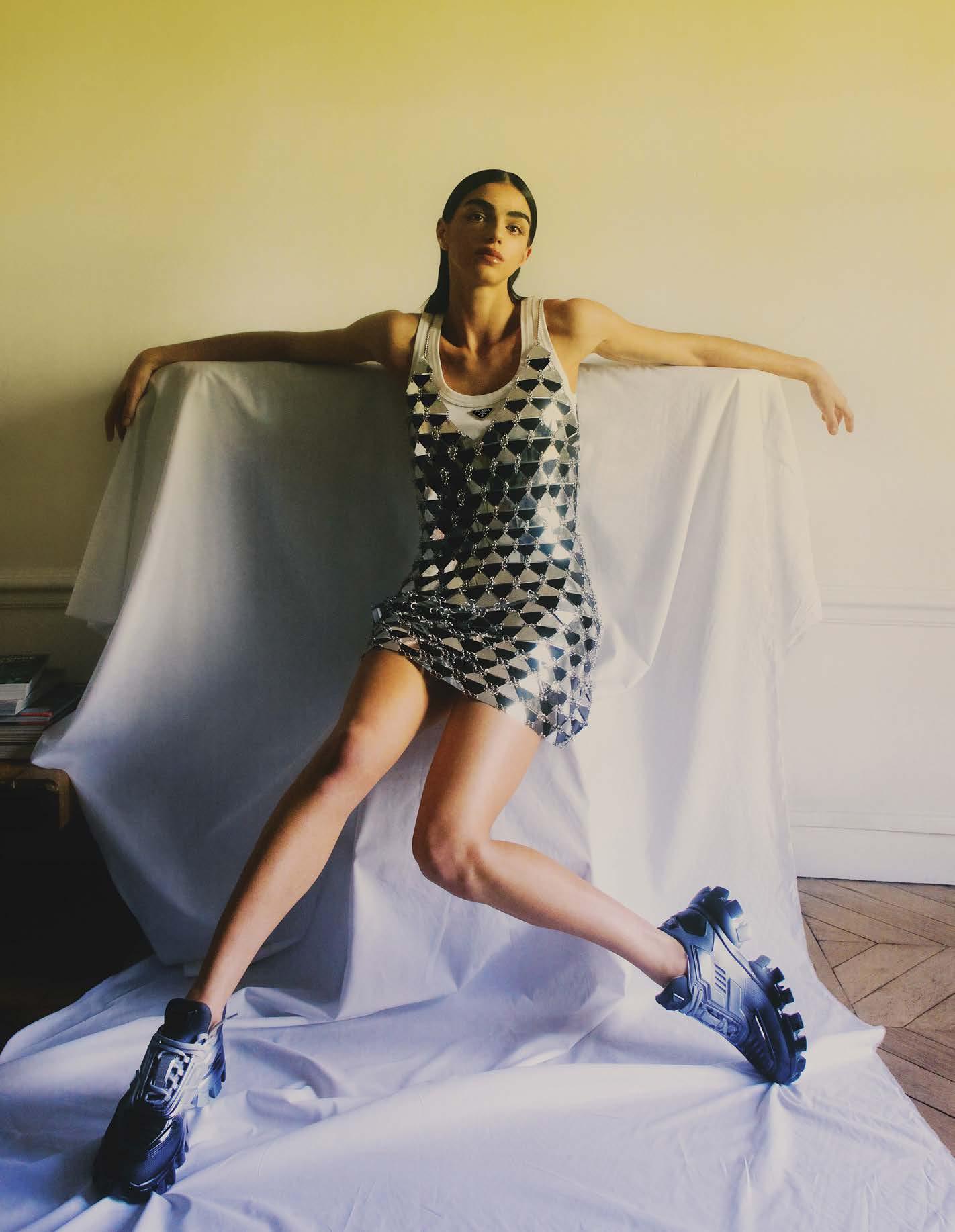
YOUSRA MOHSEN FOR YUNG ISSUE 2
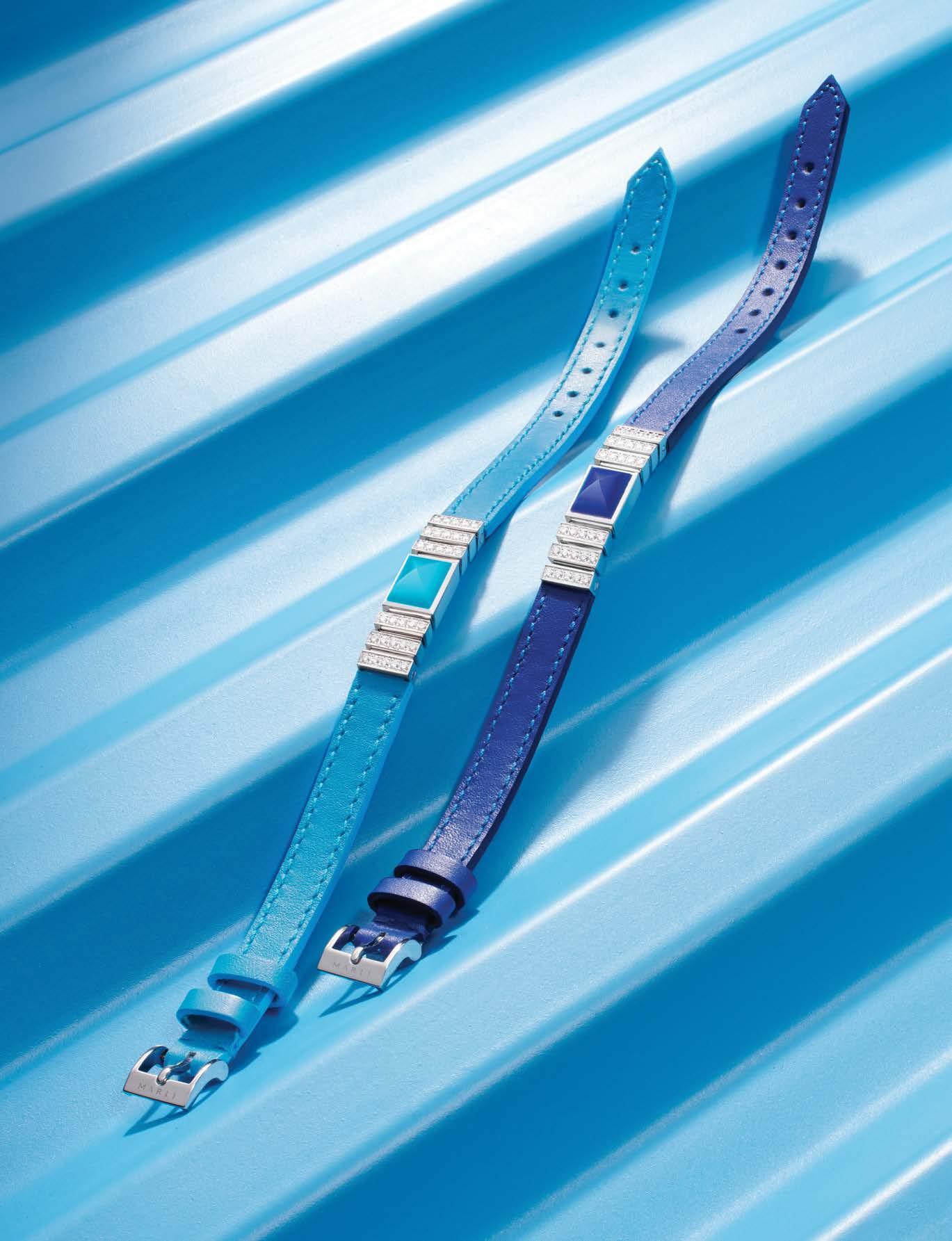
marlinewyork.com 20
New York @marli
Hudson Yards,



Contents Letter From The Founder Masthead Contributers 22 Creatives Top Watches Lucid Yusra Mardini Ali Latif Yousra Mohsen Darin Sallam In The Wild Electric Shade Sentire Studio Ilyes Griyeb Abiola Obisesan Quoz Arts Fest Banyan Tree AlUla The Space 2-3 4-5 6-7 8-9 10-55 56-69 70-79 82-93 94-107 108-121 124-139 140-151 152-165 166-177 178-189 190-197 198-205 206-213 214-215 THIS IS YUNG CONTENTS 2-3

PHOTOGRAPHY AXL JOZEPH
“Dream big and shoot for the stars,” they say — something that the YUNG generation from the MENA region has embodied, time and time again. Creativity is a world of endless possibilities — a world that is seemingly boundless and where coexisting in and among a kaleidoscope of art forms is a reality. At YUNG, we aim to reaffirm this message and to uplift the region’s new generation of creatives by shining a spotlight on their work.
We’re welcoming 2023 with messages of love and hope. An idea that this generation exudes, showing that with hard work, passion, determination and hope, dreams aren’t so far fetched.
Our YUNG Issue 2 cover stars prove that: they are the epitome of all things GEN LOVE and HOPE. Take Yusra Mardini’s story; from refugee to Olympian she has overcome all odds to use her voice as a vessel for change. Or Darin Sallam, who uses penetrating scriptwriting to bring important stories to light. Ali Latif proves how life can change in the blink of an eye if you only keep dreaming, and Yousra Mohsen is shattering stigmas faced by women through dance. This issue is full of beautiful, aspirational chronicles from those who have fought hard, loved even harder and succeeded in making their mark on our world.
As you flip through YUNG Issue 2, you’ll get a glimpse of fresh and innovative talent born in — and inspired by — our region. From designers to DJs, photographers to founders, and plenty in between, we celebrate 22 YUNG creatives who are making an impact.
In a world where busyness seems never-ending, it is our duty to pause and appreciate the creative work that stimulates our senses. We hope this issue gives you a space to do so.
YUNG Love, Sandra Yeghiazarian
THIS IS YUNG LETTER FROM THE FOUNDER
4-5
GEN HOPE






 YUSRA MARDINI photography JAMEELA ELFAKI; styling LATIFA BINT SAAD
YOUSRA MOHSEN photograpy AXL JOZEPH; styling SIR WILLOW
DARIN SALLAM photography AMINA ZAHER; styling SAIF HIDAYAH
YUSRA MARDINI photography JAMEELA ELFAKI; styling LATIFA BINT SAAD
YOUSRA MOHSEN photograpy AXL JOZEPH; styling SIR WILLOW
DARIN SALLAM photography AMINA ZAHER; styling SAIF HIDAYAH
YOUSRA MOHSEN FOR YUNG ISSUE 2
YUSRA MARDINI FOR YUNG ISSUE 2
DARIN SALLAM FOR YUNG ISSUE 2
ALI LATIF photography ISMAEL NEBCHI; styling TAHI GUY
GEN LOVE
GEN LOVE
Magazine Issue 2
Founder and Chief Content Officer
SANDRA YEGHIAZARIAN
Creative Director
SAIF HIDAYAH
OPERATIONS DIRECTOR & EXECUTIVE PRODUCER
LINA MERHI
Senior Art Director
YAZAN EL ZUBI
Art Director
TATIANA AKL
Fashion Assistant
NUJOUD OWEIS
Editorial Assistant
OMAIA JALLAD
Digital Writers
YASEEN DOCKRAT, MENNA SHANAB
ADVERTISING AND PARTNERSHIPS partnerships@thisisyung.com
SUBMISSION submissions@thisisyung.com
PRINTING
AL GHURAIR PRINTING AND PUBLISHING LLC
PUBLISHED BY THIS IS YUNG LLC
Sharjah Media City hello@thisisyung.com www.thisisyung.com
All rights reserved. No part of this publication may be reproduced in whole or part without permission from the publishers. YUNG Magazine welcomes new contributors but can assume no responsibility for unsolicited photographs or illustrations. Every effort has been made to contact the copyright owners of the images and text in this issue.

photography AMINA ZAHER
AMINA ZAHER / AXL
JOZEPH / DANIEL ASATER / ILYES GRIYEB / ISMAEL
NEBCHI / JAMEELA
ELFAKI / JEAN KAIROUZ
/ JODY HASN / KATIE
SILCOX / LAILA KAWAR
/ LANA SHASH / LATIFA
BINT SAAD / LAURA
MADAR / MOHAMMAD
ALNATOUR / SAGDAH

/ SALEH KELARGE / SAMI
LAKOUAIT / SIR WILLOW /
SOPHIA KHALIFEH / TAHI
GUY / ZAID ALLOZI
THIS IS YUNG CONTRIBUTORS
8-9

٢٢ POWER IN
Twenty-two is the ‘master builder’ of numbers, creative and powerful. These 22 need-to-know creatives from the Middle East fit the bill.
THIS IS YUNG 10-11 ٢٢
words NUJOUD OWEIS & OMAIA JALLAD
٢٢
Discover the stories of fresh, innovative, talented creatives born in and inspired by our region from designers to DJs, photographers to founders, and plenty in between. Welcome to the power of creation.
NUMBERS

THIS IS YUNG ٢٢ 12-13
photography LARA ZANKOUL
LARA ZANKOUL
Transcending Reality
Deciphering a world beyond what is presented inspires interdisciplinary artist, Lara Zankoul, to create her dreamlike photography.
Your work is quite surrealist, talk us through it: I believe there is a lot more to reality than we are able to see and I like to document that. I’m interested in capturing feelings, states of mind and dreams. I’m not interested in capturing scenes as they are: I like to break, deconstruct and reconstruct, to change the order of things. I like the absurd, because it makes the most sense.
What parts of your personality shine through your work? It is hard to answer this question myself. I would say playfulness, but also the contradiction of poised and calm on the outside but crazy on the inside.
You are self-taught, how did you achieve this?
Through obsession. I would spend all my spare time reading and researching about photography. I still do that when I feel inspired, this passion keeps fueling itself.
What personal message does your work carry?
My work is influenced by my personal experiences; it carries messages of struggles to find freedom as a woman, of femininity, love and abuse, as well as messages of self-growth and transcendance.
Which of your photo series did you most enjoy working on, and why?
The Aquarium series because the process was challenging, yet so fun. I built a human-sized aquarium, designed it as a room, filled it halfway with water, put my friends in it and photographed them through the glass.
When shooting on set, what music is in the background? It depends on the mood and energy I’m looking for - sometimes it’s lounge music, sometimes it’s 90s pop songs.
How did you discover the world of surrealism through your photography?
By playing around with reality: defying gravity, breaking the order of things, playing with perspectives, shapes and forms. There are endless ways to do it. The use of visual metaphors and symbols is also a way to explore this realm.
What made you delve into the NFT world?
A friend of mine asked me to host YouTube interviews with NFT artists, and I asked him to help me get into the NFT world in return. He helped me set up a wallet, and introduced me to Web3 platforms.
Do you have a favourite book that inspires you?
Tim Walker’s Story Teller. It’s a masterpiece I keep at my studio for endless inspiration.
What do the words ‘hope’ and ‘love’ mean to you?
To live with honesty towards yourself and others, to remain true to yourself and to keep exploring your own journey of growth, which will reflect positively on the world around you.
BASSAM ALLAM
The Surreal Deal
Whether it’s documenting nature or capturing high-fashion, Egyptian photographer Bassam Allam presents the world through an artistic and surrealist perspective.
What is your earliest memory of a camera?
I think it has to be when I was around six years old at Giza Zoo in Egypt, holding an Agfa Optima pocket camera. I remember it made me feel like a spy because it had a very special shape. All this was happening while my dad took videos of our trip, there is a tape of it somewhere.
What about your Egyptian heritage inspires you?
How the ancient Egyptians used light in their temples and tombs, and how rich the colours of the walls were. The geometry in everything they created is amazing. The concept of duality in ancient Egyptian mythology also resonates so much with my own work.
If you could be any surrealist master who would it be?
I’d love to meet so many of them, especially Lee Miller, Man Ray, and Andre Breton, but I don’t think I would choose to be anyone else but myself.
Colour seems to be a significant element in your work, is there a meaning behind it?
Colour is one of the most inspiring things in life for me. I can go as far as saying that sometimes I like a picture simply because it has a beautiful colour combination. Mastering colour can help communicate or add another level of emotions to a picture.
Your work screams surrealism, but who is Bassam
Allam through the looking glass?
My work is just an extension of who I am, how I see the world, how I think and feel, how things look inside my mind. I am the beautiful colours. I am shadow and light.
Take us through your creative process. How do your ideas come to life?
My creative process is subconsciously driven. I channel ideas in the moment depending on what the situation, location, subject, etc offer me.
Who is your muse?
The human character.
What is your advice for aspiring creatives looking to start in the field?
Learn and keep learning, especially (and most importantly) about yourself.
What does hope mean to you?
Hope is trusting that the best will always happen.
THIS IS YUNG ٢٢ 14-15

“I don't think I would choose to be anyone else but myself.”
photography BASSAM ALLAM





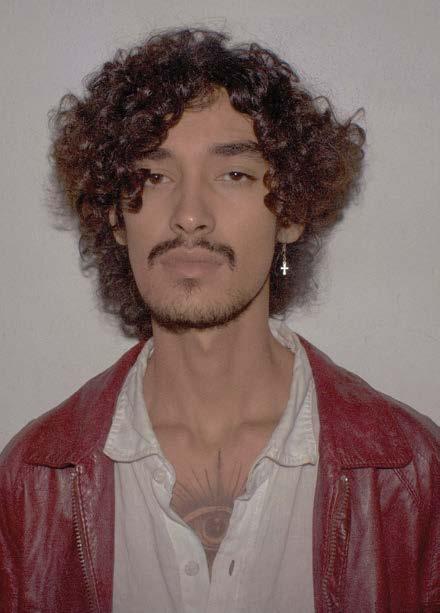



56-57 photography JAD MAQ 16-17 ٢٢
through life.”
JAD MAQ
Soul Searcher
Inspired by the struggles in his life including separation, homelessness and starvation, Jad Maq’s artwork offers a unique reflection that celebrates one’s inner true self.
We’ve seen the spiral as a repetitive symbol in your work, what does it mean to you?
To me, spirals represent the cycle of the soul – the individual’s journey through life. The way I use spirals in my work is to have them represent the layers of social constructs that were buried in us from a young age. The driving force for the viewer should be a curiosity to unfold those layers and reach a deep connection with oneself and each other.
Talk us through your colour choices, does their darkness serve a message?
Yes it does, the aim of monochromatic colour palette is to present the viewer with a hint of the individual’s journey through darkness and light.
What does the element of fire represent in your work?
Fire to me sparks a sense of a childlike pleasure, which I believe is the force of creation that lies at the heart of our civilization. I enjoy that fire can represent gentleness but also torture, which translates to me as looking to the future without forgetting the past.
If you could be anywhere in the world, where would you go? I’d go back to the Mediterranean Sea, simply to feel the serenity of the scenery and the ambiance of the soundscape once more.
Who inspires you?
My girlfriend, her resilience inspires me.
If you were to have one superpower what would it be? Flying.
What unconventional material would you like to explore in your work and why?
Liquid mercury, something about it being dangerous and shiny sparks a curiosity in me.
Take us back to when you first started. What’s your earliest memory of a paintbrush?
My earliest memory of holding a paintbrush is related to surviving; I was homeless and struggling to eat when a friend gave me money to buy food. I decided to take a risk instead, and bought my first brushes and canvas. As soon as I started painting, I saw how self-expression is infinite, how it is fuelled by the purity of the human essence, and that it is boundless, free of the prejudice of social constructs. I knew that these were the tools to shine light on my darkness. Now I owe my life to the paint brush and my canvas.
“Spirals represent the cycle of the soul – the individual’s journey
DUHA BUKADI
Towering Dreams
Dive into the world of Tunisian designer and architect, Duha Bukadi. It’s a place that rebels against the norm and is instead full of pink skies, kittens, and smiles at strangers.

Your footwear brand, Pupchen, is rebellious to routine - are you, too?
Yes, everyday is different for me. I don’t follow a routine, I forget a lot and I like to improvise. I’m careful, but I also love taking some risks. Most importantly, I have fun! I try to make everything fun.
Take us to the start of your design process, where do you get initial inspiration from?
It can be from anything in my surroundings or my memories. A discussion I had with someone or my vivid dreams. I think I also work a lot during my sleep: I choose colours and come up with solutions and concepts as I dream.
Does being an architect influence your shoe design process? It does. I don’t have any education in fashion so I always design shoes as I would a building; bearing in mind aesthetics, structure and functionality. We also live in our shoes, don’t we?
Your unique sphere heel is all about standing out from the crowd. Why spheres?
Spheres are fun, free, feminine and mysterious. I also love all things circular: pom poms, lollipops and crystal balls. Plus, we live on a huge sphere.
A Pupchen client is wearing one of your pieces on a day out, what does this day look like?
When I close my eyes to imagine a day like this, I think of pink skies, fun, laughter, good news, long meetings, smiling at strangers, adopting a kitten from the streets, telling another woman that she looks amazing. The idea is to enjoy every aspect of life, to have fun with everything.
THIS IS YUNG 18-19
٢٢

photography MOE ZACHOUR
ALEXANDRA HAKIM
Sustainability Queen
Already counting Rihanna as a fan, British-Lebanese jewellery designer Alexandra Hakim is successfully creating a socially-conscious future.

THIS IS YUNG ٢٢ 20-21
photography LARA ZANKOUL
Tell us about your zero-waste approach to design: Essentially, I take pieces of rubbish to my studio and transform them into unique pieces of contemporary jewellery. My design process revolves a lot around trial and error. I use a special casting technique that I have developed over the years – upcycling disregarded elements such as consumed matchsticks, leftover fruit and mixed metals in a way that preserves every detail of the original material. Sometimes it works and sometimes it doesn’t but I take comfort in knowing that metals can be melted down and re-worked almost endlessly so that nothing goes to waste.
How does your Lebanese heritage live through your work?
Each campaign holds a powerful message about real people who dedicate their lives to keeping the Lebanese land and its heritage so rich and fertile, from the craftsmen to the farmers and the fishermen. My favourite collection is called No More Fish in the Sea, which was inspired by a fisherman I met in Chekka, Lebanon, called Bob. He told me that he’d been fishing everyday, come rain or shine, since he was 10. The Mediterranean Sea was his home but it’s no longer what it used to be. He explained, “back in the day we’d catch so many fish that we sometimes threw them back in. Now, the water is so polluted that I catch just enough to feed my family. I fish to survive.” After speaking with him, I immediately decided to make pieces from all of the trash in the sea that Bob caught in his nets – minus the fish, of course. I designed this collection as an ode to this local community and their undying hope for a more sustainable future
What does sustainability mean to you?
Sustainability has been at the core of my brand’s DNA since day one – from my work ethic to my studio practice. It’s really about honesty and transparency, and creating pieces that are good for the planet.
How did your perspective on design change after becoming a mother?
Apart from practicality, not much. However, it has encouraged me to delve deeper into the protective nature of jewellery and to focus on the unique sense of empowerment that a wellmade piece can evoke.

Who do you design for?
For the modern, curious human, for forward-thinkers, and for people who are hungry for something different. And, also for those who like the jewellery they wear to tell a story.
What rituals have you adopted to help you reset from your busy lifestyle?
I like to spend time visiting museums alone. I live in Madrid, which serves as an endless source of inspiration. Sitting in front of Baroque masterpieces and absorbing the detailed craftsmanship hits the reset button for me every time.
photography HASS JULIEN
SARAH MANSOUR
Soul Mate
Fusing varied inspirations - from long drives and Lebanon, to choir and Christmas - helps Sarah Mansour maintain her vocal identity.
In your everyday life, what little things inspire you to make music?
A lot of my inspiration happens while I’m driving. I’m often blasting music in the car and suddenly I have different ideas pouring in. When I catch something good I park somewhere scenic so I can develop my ideas. It helps me to get moving. If I’m writing at home and I feel stuck, I’ll even go for a drive just to get the juices flowing. Melodies and lyrics also often pop into my head while I’m trying to go to sleep and then I have to get up and make little recordings on my phone.
Your voice is nostalgic, how did you discover this distinctiveness?
I learned to sing at a very young age and felt inspired by artists with deep voices. A big part of my vocal identity is layering harmonies and I believe this comes from years of choir practice at school. This combined with the inspiration I draw from female RnB and soul artists is what has built my vocal technique.
Tell us about your very first song, and how it came about?
The first song I ever wrote is called “What Selma Said”. I was 14 years old and wrote it for my best friend, who kept pushing me to sing. I even had it professionally recorded and produced. The song is about how your friends can make you believe in yourself and encourage you to shine. I still ask myself if I should release it properly.
What is your favourite song to sing in the shower?
This changes constantly but a few songs that always come back are: “I Have Nothing” by Whitney Houston, “Happier Than Ever” by Billie Eilish, and “Loving Her Was Easier” by Willie Nelson.
What’s an unpopular opinion that you genuinely believe in?
Christmas music is so good. I’m talking about the classics: I love the jazz, the warmth, and the fact we only hear it once a year. I have fond memories of the holidays so it meant a lot to me to release a cover of one of my all-time favourites, Mariah Carey’s “All I Want for Christmas Is You”.
If you were to embody any pop icon dead or alive, who would it be?
Freddie Mercury meets Sade.
What is the next big achievement or dream you wish to accomplish?
I’m working on my first EP right now and I couldn’t be more excited to create this story and release it into the world. It feels like a physical piece of the last three years of my life.
Are there any emerging artists who you appreciate in the industry?
Taxi 404, November Ultra, Flo, Lana Lubany and Nadine El Roubi.
How do you hold onto your Lebanese roots?
I wouldn’t be making music if I hadn’t moved back to Beirut after six years in the US. Lebanon is a part of my entire musical identity and working with fellow Lebanese talents to kickstart my career has ensured that a piece of this place is in everything I make.
THIS IS YUNG 22-23
٢٢
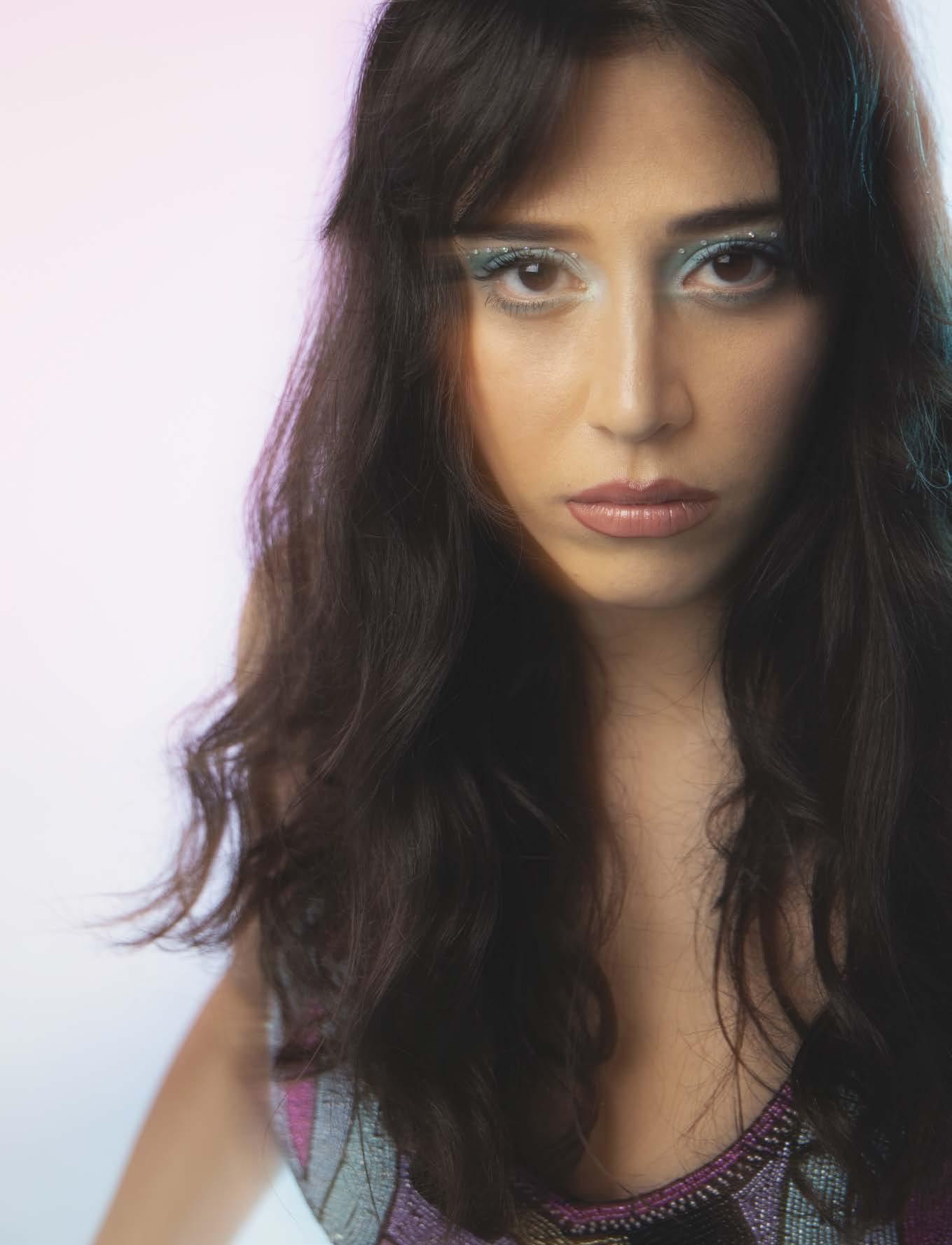
“Your friends can make you believe in yourself and encourage you to shine.”
photography FLORIANE HUSSEINI
DANA BOULOS
Role Play

THIS IS YUNG 24-25
Photographer and Film Director Dana Boulos proves that hard work and determination pay off.
٢٢ photography PROD ANTZOULIS
As a creative, did you have a muse growing up?
Yes, I had so many but my first was my grandmother, Teta Afaf. There was something about Teta that was so glamorous in an unapologetic way.
How did you end up in the world of film and photography?
I had a million different jobs before going into film and photography. I’d wanted to be a director all my life, then one day I decided to make that dream a reality. Most people don’t realise the potential they have when they set their minds to their goals.
What does it take to make it within this industry?
This industry isn’t for everyone, it takes hard work, struggle, sweat, luck, ambition, failure and determination to get to where you want to be. You have to learn to carry on working despite the incredulity of people around you, and most importantly, you must develop a thick skin to keep going.
What or who do you like to shoot most?
I primarily like to shoot with people and I especially love being able to work with actors who can transform themselves mentally into the role. There’s so much that plays into creating and bringing a scene or image to life.
Who is someone you dream to collaborate with next?
Nadine Labaki.
What three words would best describe your style of work?
Dreamy, fearless, aspirational - these are words others have used to describe my work.
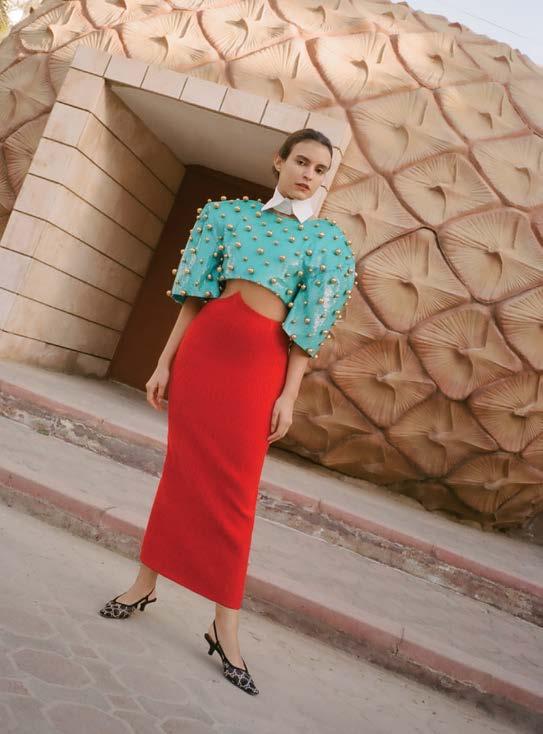
What does hope mean to you?
Hope is being able to see that there is light, despite the darkness.
Where do you look when searching for new inspiration?
From life and books.
If you were to be placed in front of a camera for a change, which photographer would you choose to photograph you?
I’d love to be photographed by Nan Goldin, she’s someone I’ve always looked up to.

“Most people don’t realise the potential they have when they set their minds to their goals.”

THIS IS YUNG 26-27 ٢٢
“It is only a matter of time to reach the top, and I am on my way there.”
photography IDRISS NASSANGAR
AHMED RAZEEK
Mind Matters
There was never a plan B for Ahmed Razeek, who knew from a young age that he was destined to become a photographer. Now, he’s on a mission to showcase Arab and African talent to the world.
How did you pave your way into the industry?
I started working in photography when I was 16 years old. It led me to pursue a degree in film from the University of Paris 8, and this was the foundation that took me into the fashion industry.
Did your upbringing influence your work?
I was born in Egypt and raised in France; this cultural mix definitely influenced my work. I have a huge vision: to show the world that the Middle East and Africa have exceptional talent and a tremendous impact on our industry. This is my ultimate goal right now, and I believe we are going to make it happen in the near future.
You live in Paris now, how does the Parisian environment inspire your work?
Paris is an art masterpiece - there is talent on every corner. People are so inspiring here, and I like to connect with them. Through them my vision expands and evolves. Also, the mix of cultures in Paris is something I admire and use as inspiration.
How would you describe your style when it comes to your creative practice?
My style is timeless, psychedelic, and a mix of my personalities. I’m trying to take people on a journey and allow them to make their own ideas about my work. With every project or photoshoot I do, I envision how I would like to portray it. Then, once I have my vision and inspiration, I begin to build the idea behind it.
What has been your favourite project thus far?
My favourite project is my latest short movie, Miel. This project is my baby and we have made huge efforts to make this happen. People from 10 different nationalities have worked on it, including talents from France, Italy, Egypt, Turkey, Senegal, and more. For me these people are the power of this project.
If you were to live in any era, which would you choose?
I would choose to live in the future, say 100 years from now. I think this would be very interesting and it matches well with my futuristic vision.
Apart from photography, do you dabble in any other creative practices?
Of course - I would say photography is a part of me, but I am also a creative director. Music also plays a huge role in my life; I’m currently trying to learn to become a DJ - it’s something that inspires me, but I still have some way to go to master it.
Has there been a moment where you lost hope on your professional journey?
I’ve had this vision since I was a kid, and started to practice at the age of 16. Only a few years later it has become my job. Honestly, I never lost hope because I have trust in my talent and vision. It is only a matter of time to reach the top, and I am on my way there. People’s successes - especially those who started from the bottom - always inspire and fuel me to keep going and not give up.
Dead or alive, who would you dream to photograph?
I would like to shoot Ahmed Zaki, the Egyptian actor who passed away a few years ago. With strong art direction behind it, that would be an iconic shoot.
Which photographers do you admire, and why?
I really admire Sarah Moon, she had a forward-thinking vision. In my opinion, she changed the fashion photography industry, and we can now see a lot of people who are inspired by her style. But it isn’t only photographers that I admire, I also admire Wes Anderson as an exceptional director. I’m a huge fan of his vision: he left nothing to luck - every detail from location to colours to people are well thought through. It’s as if every scene of each one of his movies is a magazine cover.
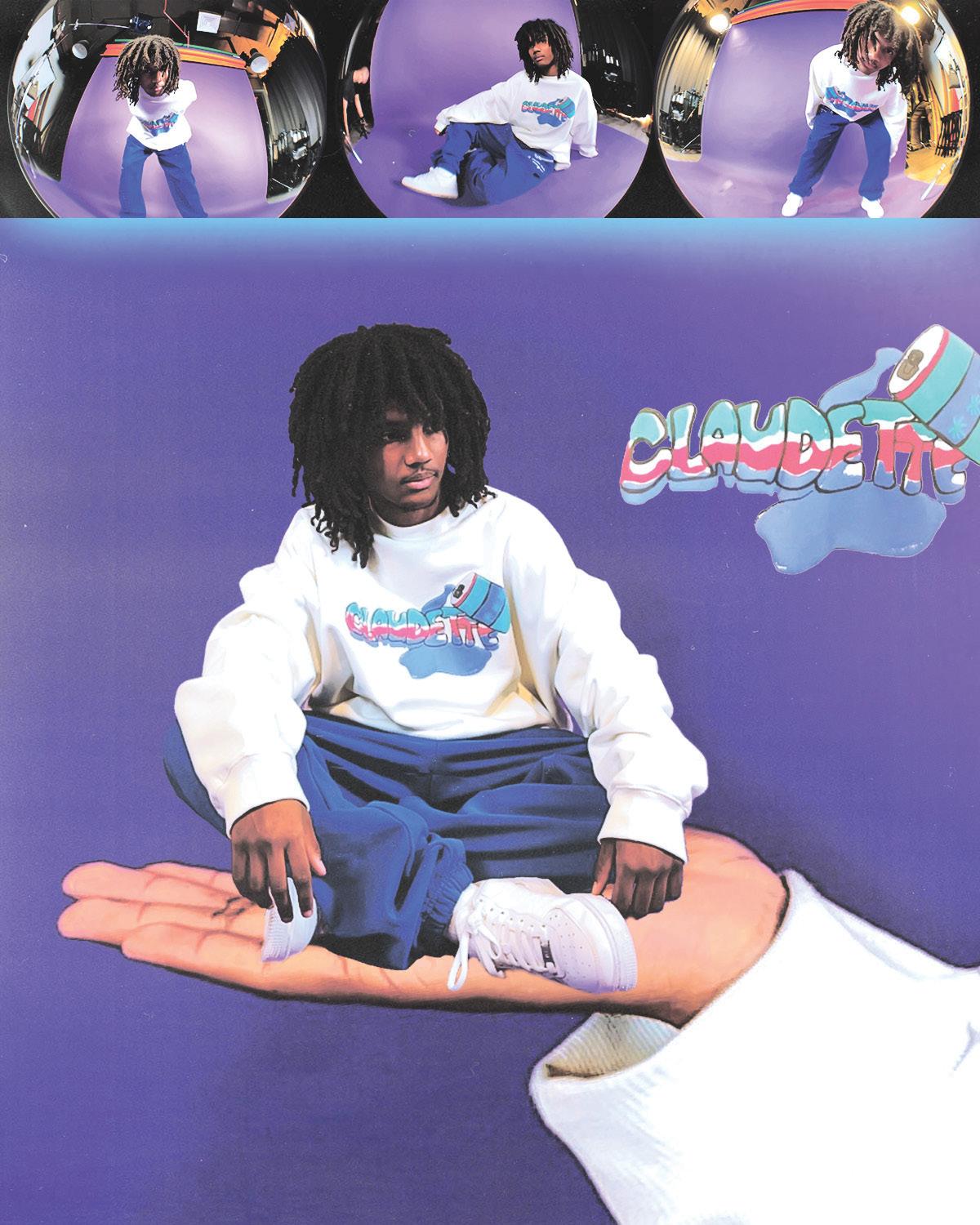
THIS IS YUNG 28-29
٢٢
photography CONOR CUNNINGHAM
LAYAN AL DABBOUS
Community Design
Fusing art and life, Layan Al Dabbous aims to unite humanity with her streetwear-style designs.
Your brand is called Claudette The Brand. Who is Claudette?
Claudette is a character I created that almost acts as my alter ego in cartoon form. I always wanted to create a space where people could communicate, relate and be vulnerable and found I was able to do this by spreading thought-provoking messaging through Claudette, the character.
What is the story behind the illustrations in your designs? Each drop has its own unique story and stems from situations, observations and experiences. The most recent drop was titled I See Things Clearer Now, and the graphics all relate to the idea of me opening my eyes to some of the truths of life. Each graphic tells a unique story and together they mesh to create an overall story. Everything I draw is with a specific purpose - even the materials play into the storyline and help give it meaning. I love using word play and colours, too.
How did you start using spray paint as a medium? It happened very organically. I was living in New York and had a big, white, empty wall in my apartment. It needed some colour so I bought spray paint and started doodling on it. I liked the way I was able to express myself using the paint. I later decided to transfer these messages onto hoodies, jackets and trousers I had at home. My friends and family loved them, so I started making more.
Claudette The Brand has a cult following, why?
I’ve always wanted to show that humans experience this journey of life - with all its ups and downs - in a rather similar way to each other. I believe open and vulnerable communication can heal a lot and I think it’s important for people to see how similar we all are. This idea fuels the core of the brand: I think people can see that and want to join us on this ride.
You claim to bridge the gap between opposites. What does this mean and why is it important to you?
Again, it goes back to the idea that we are more similar than we are different. It’s a way to bridge a negative divide within humanity. If we can come together with love and acceptance, so much greatness can come out of it.
How important is colour to the brand?
Colour is an integral part of the brand. What I can’t say with words or graphics I say with colour. Each tone brings out a different emotion and feeling in people, so adds to the story of the piece.
What has been your favourite memory throughout the brand’s growth?
There have been so many amazing moments but if I had to pick one it would be our first official pop-up on Canal Street in New York. It was surreal to see an idea I’d had play out in the physical world; people came from all over the city and it was such a fun day filled with art, fashion and music. That was the moment I knew this was something I wanted to grow.
What is next on your list of achievements for Claudette?
I have no idea what’s coming next, but I like it that way. I love putting energy into the brand everyday. We are, however, looking to add more silhouettes and different fabrics to our upcoming collections.
What is the key to standing out?
Being authentic and creating from purpose and passion.

THIS IS YUNG 30-31
photography FARID RENAISCSM
٢٢
“My story is sincere to the people I was raised around, which contradicts any stereotype in the news.”
KAZNA ASKER
Street Life
Combining her British upbringing with her Yemeni heritage, fashion designer Kazna Asker’s streetwear label is inspired by the Arab and Muslim world, incorporating traditional Middle Eastern designs and fabrics into activewear.
When did you discover your love for fashion design?
I was nine years old when my dad bought me and my siblings matching Rocawear outfits for Eid, everyone would come up to us and be like, “That’s Jay Z’s brand.” I guess that’s when I discovered fashion… and Jay Z.
Your work is extremely driven by community and values, why is this important to you?
My aunt is extremely involved in community work and we’d always co-organise charity events to fundraise money for Palestine and Yemen. I’ve always been surrounded by a strong Yemeni community where we all know and help each other. I have a lot of experience in charity work and community work, from working with refugees in the Netherlands, to teaching in Nepal and organising fundraising events in Sheffield. It felt natural for me to be inspired by real people and reference their stories and voices within my work.
What’s the message you are trying to convey through your designs?
The story that I try to convey is always based on sincerity. I design in matching pairs – a complementing look for men and women – to represent the brother and sisterhood of my community. My muse is always inspired by the strength and prayer of Muslim women, so I prioritise Islamic modesty within my designs. I would say my story is sincere to the people I was raised around, which contradicts and challenges any stereotype and negative connotations associated with the Muslim community in the news.
What was the biggest challenge you faced whilst designing your recent collection?
Definitely imposter syndrome especially at Central Saint Martins. I’m aware fashion is a superficial industry and that people don’t want to think about politics whilst shopping. So I’d always question if fashion was the right platform to convey my message, but my tutors really believed in my message, which I’m super grateful for.
Why did you choose streetwear?
I was born and raised in the UK, and around people wearing tracksuits everyday – whether it was my dad, brother and cousins in Liverpool or my community in Sheffield. So all I would see and wear was Nike and Adidas, and I guess those details and styling inspired the design process.
How is your personality reflected through your work?
I combine my Yemeni heritage with my British upbringing, the same way I wear a Nike tracksuit with a keffiyeh head scarf. I think you can definitely see the family dynamic within my work. I’m super close with my brother and sisters, and I always design in groups or pairs to tell my story. Also, I’m a little feisty, and my work stands up for all my political views.
Who is your biggest style inspiration?
Probably my grandma and my cousins. I love my grandma’s traditional abayas and hijabs and my young cousins in their tracksuits. I like seeing how we adapt our cultures as the next generation. In terms of fashion eras, I’m inspired by everything from the 90s.
You won the Debut Talent Prize at Fashion Trust Arabia, what’s next for you?
I feel super grateful that I could represent Yemen and raise awareness on the current humanitarian crisis. I’m also proud that I could bring everything beautiful about my local community in Sheffield to Doha. My goal is to develop my own brand and continue the journey of merging local cultures, community, charity and activism with fashion.
FATMA MOSTAFA
Weaving Creativity
A multi-hyphenate creative, Fatma Mostafa is an Egyptian artist, embroiderer and photographer who takes a multidisciplinary approach to her work, incorporating her many talents into her award-winning jewellery designs.
Why is embroidery such an important part of your designs?
For me, embroidery was one of the first mediums I worked with. Later on, when I studied painting, I loved experimenting with different materials and mixing techniques with my embroidery – I really just enjoyed the process.

Given your multidisciplinary background, what made you choose jewellery design as the main gig?
While I was experimenting with different materials, I got the idea of mixing metal with embroidery to make something wearable. I felt that with this mix I could make unique designs and pieces that are different to what already exists in the jewellery industry. I feel I can express myself with all the materials I love to work with.
What challenges did you face when incorporating embroidery into small-scale jewellery pieces?
Jewellery making and embroidery are two crafts that, individually, require a lot of effort and time to deal with. The idea of mixing them together, and the precision and patience needed to make small paintings with embroidery is challenging, but I enjoy the process.
How did your love for painting aid your jewellery design process?
I think being a painter is what makes me think of every jewellery piece as wearable art.
How are you influenced by your Egyptian heritage? Egypt has a lot of visuals, civilizations and diversity of traditional crafts, which definitely influenced my creativity.
What is the significance behind the names of your collections?
Every collection has its own story. For Water Lilies I was inspired by Monet but also the water lilies lake at Orman Garden in Cairo. For Out Of The Blue the name came after a period of mental blocks and lack of inspiration.
After winning the Fashion Trust Arabia Jewellery Designer Award, what’s next for you?
It was an honour to win the prize in the jewellery category, I am so happy and proud of myself. I’m so excited for what’s coming, and being the winner of the prize will definitely play a role in my brand development.
THIS IS YUNG 32-33
٢٢
“I make unique designs and pieces that are different to what already exists in the jewellery industry.”

photography FATMA MOSTAFA
Taxi 404 consists of two members, what elements do you both bring to the table?
The Taxi 404 base is a symbiosis of visions and technique. We’ve been making music together for almost 10 years, and we never ask ourselves that question. We just knew it was obvious that we needed to write songs together.
What is the meaning behind the name Taxi 404?
To be honest, we picked it because it sounded cool.
How would you describe your sound?
Our sound naturally flows from what we like to listen to. When we decide to write a song, we never say, “ok, today we do an indie-pop song” or “let’s do French variety”, we just do what we feel at the time of creation without putting labels on it.
Who or what do you listen to for pleasure?
The list is long: The Strokes, Serge Gainsbourg, Inner Wave, Laylow, Doc Gyneco, Chopin, Erik Satie, Chet Baker, Skinshape, Mac DeMarco, Beach House, Rachid Taha, Feu! Chatterton, Abdel Halim Hafez, Hermanos Gutiérrez, Luidji, Arcade Fire, Ichon... should we continue?

What would you say is the best achievement you have accomplished as a band so far?
People singing our songs in concert is an accomplishment. And also, being able to pay rent thanks to our music.
What about your Lebanese heritage inspires your music?
As far as our music is concerned, we don’t really know the answer to that question, given that we listen to a lot of different things. But one thing is certain: the caring nature of the Lebanese public motivates us to continue.
What do you do for fun when not recording or performing?
We play a lot of FIFA 20. And sometimes we even think about dropping everything for a career at FIFA.
Dead or alive, who do you look up to in the music industry? Composers influence our way of seeing music, but the most important thing for us is to keep our footprint and our original essence, and do Taxi 404.
What is your favourite moment as a band? Each sold-out concert!
What is your definition of hope?
We don’t really like the word hope, because it leaves a margin of error, we prefer the word faith, which accompanies us to the end.
34-35 ٢٢
TAXI 404
Making Waves
Not easily defined, Taxi 404 are staying true to themselves with symbiotic soundwaves.

photography FRANCESCA MATTA

THIS IS YUNG 36-37
٢٢
“The process of nurturing and building a story is an extremely stimulating one.”
photography SAMO SHALABI
ZEINA AREF
Identity Parade
Drawing inspiration from her hometown, Cairo, Zeina Aref explores identity and celebrates womanhood through the mediums of film and photography.
What are you currently working on?
I’m currently in different phases of production for a music video and some commercial work, which has really been helping in my understanding of the craft of making. I’m also developing a personal experimental short film which has been challenging but is something that I’m aiming to shoot in the coming year. On top of that I’m aiming to shoot another self-portrait series, which is a process that’s becoming almost like a ritual that helps me in documenting my and my journey.
What is your favourite medium to use in your work?
I think every story is best told with different mediums. Experimenting with film, photography, sound, installation and performance are things that I want to continuously explore in my practice. Currently, I’m really enjoying film and moving image. It’s so multi-faceted, collaborative and allows you to explore and experiment with different senses, narratives, and formats for storytelling. The process of nurturing and building a story is an extremely stimulating one.
Outdoors or in a studio, where’s your favourite creative space?
I definitely prefer shooting outdoors or on location. A lot of my inspiration comes from spaces and their natural connections, patterns and visuals. I also think that nature is so rich as a base, and I tend to root aspects of my work in reality. I don’t really enjoy studio work as it’s not as dynamic or inspirational to me.
What does being a woman from the MENA region mean to you today?
Being a woman from Egypt is one facet of my identity and it means that the stories I enjoy telling are informed by that culture and by my personal experiences. It is something that I identify with and the experience I connect to most.
What is your favourite memory of Egypt?
One of my favourite memories would have to be very old family trips to Alexandria. We’d have these very redundant loops of activities related to the beach and walks by the waterfront which are really nostalgic.
Topics surrounding women seem to highly influence your work, why is that?
It’s just something that is innate to me, and they are the stories I feel are most important to discuss and to resolve within myself. My work is a reflection and reaction of my present self and the social and political spaces I inhabit. And so, naturally, these themes and conflicts surface in my most personal work.
What’s the greatest lesson you’ve learned?
It sounds super cheesy to say this, but trusting the process, and yourself. I think this is something that I’ve often struggled with and - to a certain extent - self-doubt is healthy. But I’ve really learned to understand the true meaning of trust, and how important it is in order to experiment, to push yourself and to develop your work.
ABD AL HADI ABUNAHLEH
Dancing King
Dance is in Abd Al Hadi Abunahleh’s blood, but bringing his talent to the world wasn’t quite so straight forward.
In a society where dancing and choreography are not stereotypical professions for a man, how did you come to realise this was a passion?
The reasons I chose to dance are always unfolding themselves to me. When I was a kid I was extremely observant, with so many questions about people’s behaviours and movements. This intuitive observation soon started to operate on a larger scale, and I started contemplating people moving in groups and masses. At some point, I knew that I needed to start moving in order for me to understand movement and its relation to the human body. After years of practice I came to a realisation that the more I dance, the stranger my body feels to me, and this is when I started inventing my own movement system, which is simply rediscovering my own voice.
How would you describe your style?
My own movement is simple and primitive, yet, the construction of the pieces as a whole, feels like a ceremony or a ritual. This is why I describe myself as a ceremony inventor.
How did you make your passion for dance into a reality?
Like any other artist, I was starving and still trying to create a comfortable environment and conditions - but this is very difficult in Amman, especially when it comes to dance. Getting involved and collaborating with other artists from different disciplines offered me a huge support system. I was also privileged and hardworking enough to be invited to more than 30 different countries as an artist and a choreographer where I was able to collaborate with other artists, galleries and institutions. This gave me the opportunity to be present in multiple geographic areas.
Tell us more about Studio 8 and the idea behind it:
With the non-existing infrastructure of choreographic work and contemporary dance in Jordan, we wanted to create a platform that functions as an ecosystem to support dance, from teaching and audience building to exchange and presentation.
What’s your favourite type of music to dance to?
I appreciate any type of music. But when it comes to my creative process I play experimental and soundscapes - where rhythm and time are not defined - in order for me to move freely without having my movement choices affected by the structure of the sound.
What feelings are heightened in you when you are dancing?
It’s a case by case, to be honest. With each honest choreographic work, it seems like I’m possessed with a certain energy, character and feelings. The experience of creating and dancing my latest work Crossing, for example, is totally different from one of my other works named Wujud w Hodoud. But there is one feeling in common whenever I dance: I feel like I’m detaching from the physical world and ascending space and time. It’s as if I dance in my sleep; when I stop dancing, I wake up with flashbacks flooding into my brain as well as so many question marks and a massive space for contemplation.
What made you incorporate painting and dancing into some of your projects?
As I started to practise contemporary dance, my friends were all artists from different backgrounds, too. This inspired my work. I also see similarities between different art forms and believe that art forms can be very similar when it comes to the process - but different in results. When harmoniously merged together, these results - installation art, sound design and painting, for example - create magic.
How can we encourage more males to dance?
I feel that society in general should be more exposed to dance, and be more open to the idea of contemporary dance and movement - not only in the theatre and commercial sector.
What does love mean to you?
Love is simple, and is within all and everything. I can find it in the most complex and the most simple little things.
Other than your profession, what do you love to do as Hadi?
As an anthropologist, I like to travel and explore other authentic, traditional and native cultures. I love diversity in food, myth, oral culture, landscapes, arts, architecture, food and languages.
If you were to paint a picture of your happy place, what would it look like?
A source of light.
THIS IS YUNG 38-39
٢٢

photography GHASSAN SELA
“My own movement is simple and primitive, yet, the construction of the pieces as a whole, feels like a ceremony or a ritual.”
TALA MORTADA
Rule Breaker
Beirut-based art director and DJ, Tala Mortada, is using music and design to help affect political change and build community.
Has a career in music always been your dream?
As one of the founders and managers of Factory People (she’s also a founder of Clap Clap design studio), we build all our projects around music. When I was younger I dreamt of making music videos, but what I ended up doing is designing interiors, installations, films and graphics for our stages, our clubs and our online platforms. It’s a whole visual world revolving around music, where I also get to perform.
How do you feel when gigging?
I get goosebumps when I remember tunes that match together so perfectly, or when one track seems to exist just to continue the story of the track before it, and to introduce the one after. When the crowd appreciates those moments, it’s crazy synergy.
Are you ever anxious before a performance?
The anxiousness definitely reduces with time, but yes there’s always a nice kick before a performance.
How do you manage a work/life balance?
Before having a baby, I used to only work. I thought I had a personal life, but I was hiding behind work. I was always under the impression that I had to live for my passion and career, but after the pandemic I realised the importance of giving time for my well-being. Now that I have a baby, I have to be very rigid about how many meetings I take, how many working hours I do and how many nights I DJ. I want to give my son a lot of my time so I’m very careful about how I juggle everything. It’s exhausting to switch mindsets so frequently.
How has being a mum affected your career?
My company was getting back on its feet when I was well into my pregnancy. The pandemic and the Beirut explosion in 2020 destroyed our clubs and a big component of our business. So I basically never got to take a break, but I did take kind of a back seat. On the one hand, this helped me observe my job from a distance, and understand what I want out of my career. I used to do everything, and now I’m happy being more focused on my creative tasks, on training my team, and on overseeing high-level decisions. But on the other hand I’m saying this in hindsight; how it felt was much tougher than this. It was really hard having to take a back seat while my partners could still be driving at full speed. It was hard giving myself time for my body and brain to recover - and the worst part is the guilt I still feel when I spend a lot of time on work instead of taking care of my baby and myself.
What message do you have for emerging DJs in the region?
The world needs happiness today, forget about all the rules, forget about appearances, play music for people who love your music.
THIS IS YUNG 40-41
٢٢

photography KARL SFEIR
“The world needs happiness today… play music for people who love your music.”
SAM KARAM
Beat Master
Based in London, the Lebanese DJ and producer Sam Karam tackles house and techno beats to shake up the electronic music scene with a sense of Arab pride.
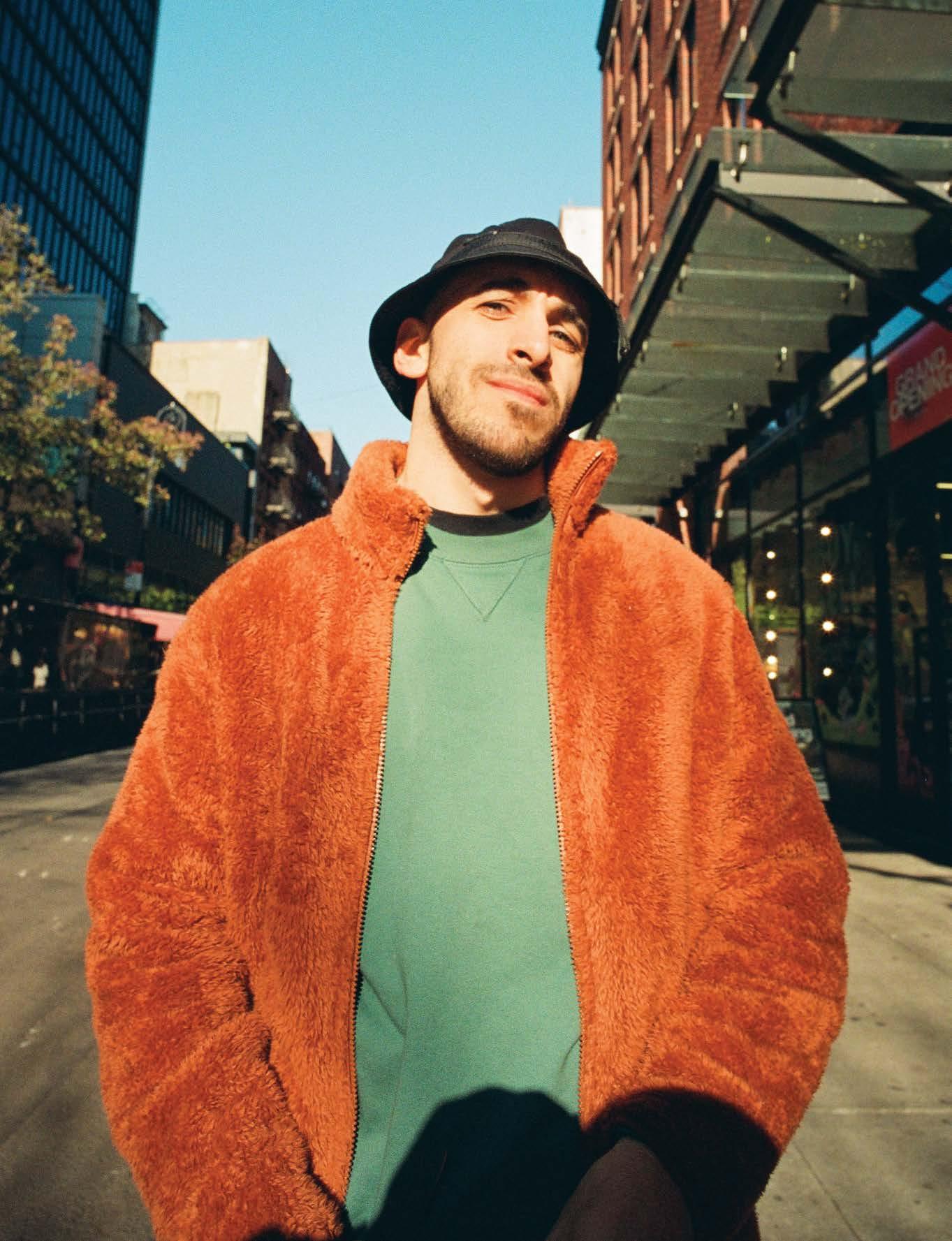
THIS IS YUNG 42-43
photography NEEL GUPTA
٢٢
What has been your favourite gig so far?
It’s been an incredible year for me, my busiest to date. Playing at Sama Abdulhadi’s fundraiser for Beirut was one of the best performances of my life. The Palestinian techno queen invited some Lebanese DJs to play at one of the best clubs in London, so the pressure was on. I managed to weave in fun housey vocals with entrancing techno, and even slipped in some Palestinian techno – Shabjdeed and Al-Nather’s Mtaktak.
Who’s your favourite Arab music icon?
This is a tough one. Sonically I’m almost always inclined to say Fairuz, because her voice is just unmatched and otherworldly. I would say though that Umm Kulthum still takes the crown as the greatest of all time. If I had a choice between a ticket to Mars or to time travel to an Umm Kulthum concert back in the day, I’d choose Umm Kulthum in a heartbeat. In contemporary times, I have to give a big shoutout to Felukah who, unlike most manufactured pop stars from the Middle East, is breaking boundaries and connecting with listeners on another level. The expat experience for Arabs is very real and difficult, and to be a voice for them is something that is much needed.
What do you love so much about Umm Kulthum?
She was basically techno before techno was even invented. The long sets, the hypnotic effect of her repetition of words, the tension created by elongating pronunciations, the emotion evoked from the harmony of the instruments behind her, and the hype coming from her audience. These are the ingredients that make magical dancefloor moments, which people around the world seek out in good times, and bad times.
What message do you try to convey through your music?
I always try to be intentional with my writing, whether it’s the more cosmopolitan electronic tracks, or my Lebanese-identity alluding tracks, like those on the Sorrow Carves album. Although it’s hard to decipher and deliver a message in electronic music –what with its lack of words most of the time – I want to invoke a sense of Arab pride when people listen to songs on that album. When people think of Arabic electronic, they often think of Acid Arab bangers or Omar Souleyman’s nasal synth melodies. Even on They Troubled Us, the closest thing to a wedding banger on that album, I tried to emulate a trippy atmosphere and bring manipulated vocal samples to the foreground. The SWANA region has many talented producers, and I want them to get ideas from the rich catalogue of music our homeland’s hold. I would rather we use these samples in novel ways before a European with an oriental alias does it.
When did you realise your love for music?
Getting up for school was always exciting. Not because I had to go to school, but because I was always excited to pick a cassette to play in the car ride. When my dad traded up for a car with a CD player it was like the gates of heaven opened. Not only could we listen to albums from the collection at home, but I could burn mixtapes and curate our car rides from Beirut to the mountains or to the Bekaa Valley.
Did you have the support to pursue your career in music?
I’m very lucky that my parents always helped to nurture my creativity especially with guitar lessons from a young age. However, the social stigma of pursuing a career in music was definitely troubling. I felt this more from teachers, classmates and society in general. But, I’m truly fortunate that out of all the obstacles that you face when pursuing such a challenging career, my parents were not one of those obstacles. I couldn’t be where I am without their faith and support.
How have you been treated within the industry?
In the past eight years of pursuing this, I’ve had support and belief from a huge pool of DJs from different (mainly immigrant) backgrounds in London. One particular crew is Mehmooni, a party series by the wildest Iranians in the capital. I recently played with their organisers again at Village Underground to raise awareness about the revolutionary efforts in Iran.
What’s your favourite album of all time?
I was a huge music journalism nerd in high school and I have to say I’m happy that I grew out of that phase. This is quite a hot topic and I always think it is extremely subjective – everyone’s experience of music varies based on factors such as language. With that in mind, I think the greatest jazz albums, like Miles Davis’ Kind of Blue, should trump the most legendary PRassisted rock and hip hop albums. I would also say Madvillainy by Madvillain is my personal all-time best album because of the extraordinary use of sampling techniques while still delivering a collection of tracks that transport you to another world.
Where’s your dream gig destination?
I’ve been hearing some great things about Wadi Rum in Jordan and Bonjuk Bay in Turkey, so I’d definitely say these are on my dream gig list.
“Umm Kulthum was basically techno before techno was even invented.”
LELLA FADDA
Enigmatic Energy
Solitude leads to uniqueness for Lella Fadda, whose sounds come from a confidence only music can give her.
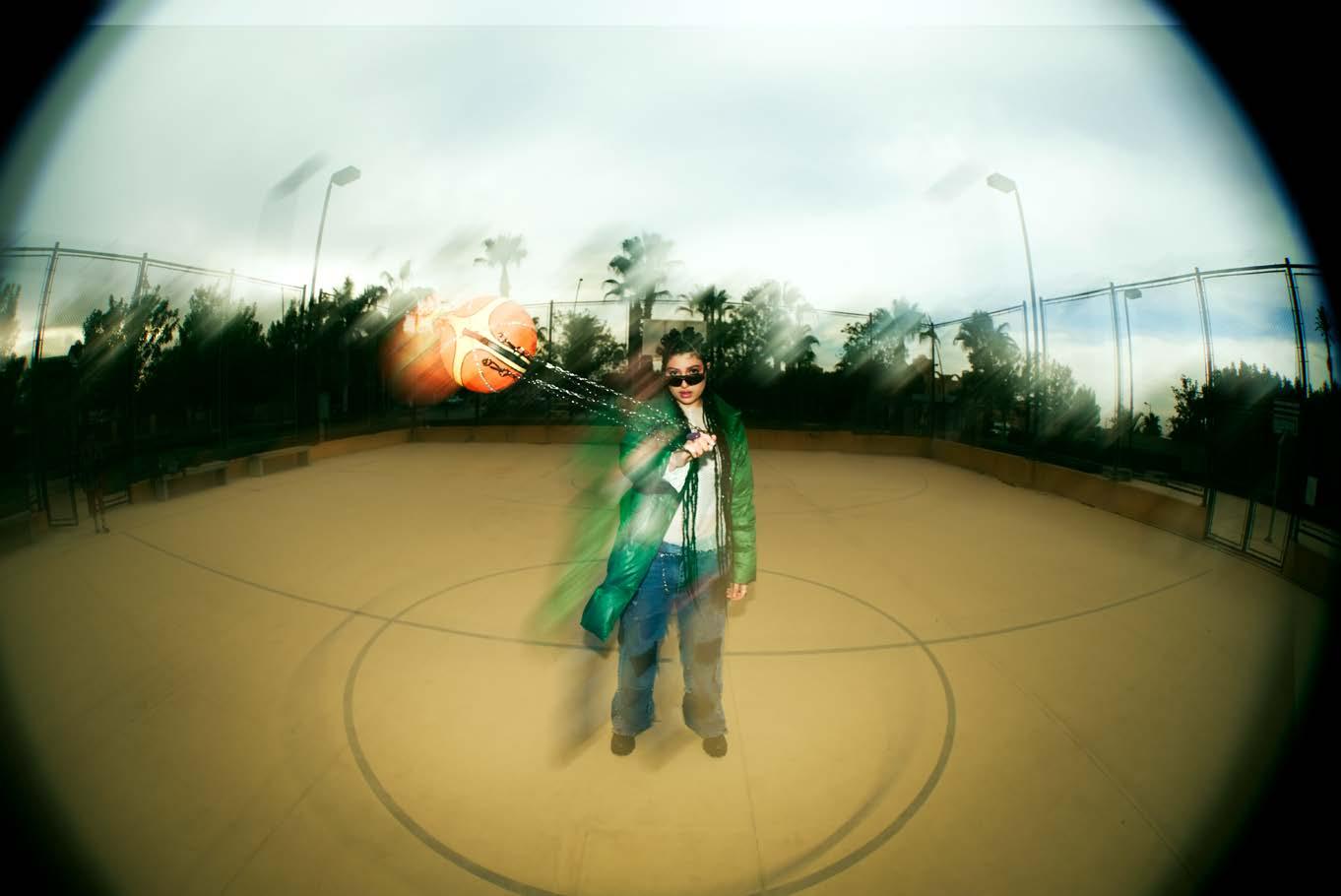
THIS IS YUNG 44-45 photography IBRAHIM
GAMAL
٢٢
“I believe the feeling of loneliness has always been the protagonist of my writing.”
Behind the spotlight, who is Lella Fadda?
I’m a very private person so what I choose to show is what I want people to see. The last year has been about focusing on music and enjoying the process. Behind the spotlight, I’m learning to have fun with everything I create, and to be kinder to myself.
When was it that you discovered your love for performance?
I was a very lonely kid who always had problems talking in front of people - but enjoyed singing for them - so I’d say that music was my only friend while growing up.
What challenges do you face being a performer in the MENA region?
People are trying so hard to put me in a box full of their own ideas about how a female artist should look and sound. I’m just here to embrace my uniqueness, without trying to live up to people’s expectations. I know I’m creating a new genre and it’s going to take time for people to get it.

Take us through your creative process:
I write to document my stories and life - I could forget a phase of life ever existed but not a song, you get me? I believe the feeling of loneliness has always been the protagonist of my writing. My songs are very personal, I’m sharing more than music. My most personal, completely heartfelt, is my latest release, Malleit.
What are your pre-performance rituals?
My Rubik’s Cube. It lets me hyper-focus on one thing rather than stressing out about what could go wrong. Also the thought of getting food after the show makes me feel like life is worth living.
Who would you like to perform or collaborate with next?
Sevdaliza, Agar Agar, Tamino, Tuğçe Şenoğul, Ghali, Akher Zapheer, Michelle Gurevich. I can go on (and on!) about the people who inspired me throughout my life, but these are a few names that popped into my mind. I know we could create magia together. Magia is my favorite word, it means magic in Italian.
What distinguishes you from other performers?
I don’t know. I’ve always been very attracted to ‘real’ artists, people that I knew were giving so much more than just a performance. Likewise, I just do what I like to watch.
MIRAMAR MUHD
Mighty Murals
Expression becomes euphoria and imagination becomes reality for Miramar Muhd, every time she paints in super-size.
When was it that you first embarked on your journey with art?
It was around 2017. I felt the need to express and the canvas was the nearest tool. Over time, I realised the healing power of art and now I’m obsessed with what I’m doing.
What is your favourite art medium to work with and why?
Paint, but on large walls. There’s something euphoric about hanging mid-air in front of a massive wall that makes me want to paint forever. When I paint like this, I feel like I’m opening a gate and communicating with another part of me: my giant self. It feels like I exist in another realm and at some point imagination becomes more real than reality. Maybe because I’m giving it a large piece of the space-time fabric. For me, painting a mural is a spiritual journey and the process is more important than the result.
Is there a significance to the scale of the work that you create?
For me the larger the wall, the lighter I feel. It sounds contradictory, but it’s much more about what I want to express than how physically tired or capable I am. There’s a lot I want to say and the large scale helps me to put it all out there. Now, my dream is to paint a whole mountain by myself.
Women seem to be an integral part of your conceptual process, tell us more about that:
I believe women are superior beings. They literally give life to everybody walking on this earth. It’s a miracle. I want to keep reminding myself and other women of how strong they are; whether I’m painting an image of a strong woman or painting a large-scale mural as a woman in a male-dominated society.
What story are you trying to narrate through what you do?
I have no story to narrate. I’m here to explore and seek something that is still unknown to me, yet I can feel its presence and strength. I like to share my journey but, to be honest, I don’t want to label or title any of it until it speaks on its own, especially my current work. I can tell you that I’m learning, being inspired by nature and that my recent studio work revolves around movement.
What are the main themes that you go back to when painting?
To my childhood, and to nature. The more I try to develop my process and art, the more I find myself going back in time and memory. I suppose it’s trying to understand who I really was and who I am.
What is your favourite childhood memory?
I was obsessed with water for some reason. I used to play with it constantly. Splashing the water, pouring the water, looking at the water and even trying to smell it.
Tell us about your We Move Mountains collection: The We Move Mountains collection celebrates female empowerment. For an International Women’s Day special, my work was featured as part of a campaign with The North Face. The idea was to celebrate women who challenge themselves both literally through sports, and figuratively by making a difference and opening new paths for others to follow.
What challenges do you face when creating such large pieces of art?
The challenge is that I need to accept the challenge in the first place! A huge percentage of mural work is a mental process, so I have to prepare myself mentally before I start.
THIS IS YUNG 46-47
٢٢

“I want to keep reminding myself and other women of how strong they are.”
image supplied by talent
YOUSSEF DRISSI
Deconstructing Design
Unconventional and ever-evolving, Youssef Drissi’s clothing brand, Late For Work, shares a classic yet modern, subtle yet bold take on design with the world.

THIS IS YUNG 48-49
٢٢
“I realised at a young age that it wasn’t the external vision of Moroccan art that inspired me, but the behavioural aspects and contradictions of an Arab society growing in a modern, globalised world.”
photography MAROUANE BESLEM
What aspects of your culture inspire you?
As an Arab who grew up in Morocco, I realised at a young age that it wasn’t the external vision of Moroccan art that inspired me, but the behavioural aspects and contradictions of an Arab society growing in a modern, globalised world. I’m inspired by the observation of social-phenomena, and the human behaviour of our society. I think we are somewhat stuck between our ancient culture with its traditions and beliefs, and a modern digitised world.
What does love mean to you?
Simply to be around loved ones, and to continue to do what I’m passionate about.
Describe the moment when you knew fashion was your career path?
I’ve always been passionate about arts and fashion, but the moment I knew it was going to be my career path was when I joined a fashion school and started to reinvent and reconceptualise clothes.
Who is a creative you dream to collaborate with?
I love everything Gleens Martens is doing.

Who would you love to see wearing your pieces?
Anyone who speaks the language of the brand, who understands and relates to it, and who the designs define in some way.
What does the name Late for Work mean, and how did you decide on it?
Late For Work defines the strong worlds that describe the brand: offbeat and undisciplined.
How would you describe your distinctive style as a brand?
The brand offers an unconventional vision and contradictory ideas, inspired by the observation of social phenomena. We’re classic and modern, subtle and bold, masculine and feminine - and we explore deconstructive and genderless designs; incorporating sultry-streetwear with desk-job roots.
A lot of your work is created through deconstructing existing pieces, talk us through that:
My creative process revolves - and evolves - around the deconstruction and reconstruction of pre-existing pieces using intuitive cutting, sewing, fitting and more. It’s hands-on work which offers me the opportunity to test and change my ideas.

How do you spend your non-working days in Casablanca?
I love spending time with friends and family, strolling around the city. We’ll probably drive out to the ocean or spend the afternoon at the park, and will likely pick up some fresh fish to eat from the port.
DIMA SROUJI
Fragile Vessels
Inspired by landscapes, Dima Srouji is intuitively designing glass shapes and forms similar to ancient vessels, while showcasing the skills of Palestinian craftsmen.
What was the lightbulb idea behind Hollow Forms?
There wasn’t really a single lightbulb moment, but it was the moment of my return to Palestine that had a lot of magic. I think with return a lot can happen. It was a process of meeting the glassblowers (who, to me, looked like alchemists), having an amazing conversation, and starting to make a collection together. It was their first time working with a designer. The ten collections we’ve made over the last five years have been vessels for me to think with and play with; they’ve really been an escape in many ways.
If you were to move from your current home in London and only take three things with you, what would they be and why?
This is an interesting question for me. I’ve moved around so much in my life: I used to hold onto things, to make me feel at home everywhere I moved. I would bring my rugs, my frames, books, etc. Now I don’t feel I need to take those things with me anymore, but I would love to keep three of my plants.
Is there a significance behind the organic shapes that you create for Hollow Forms?
A lot of the forms are inspired by early Islamic vessels, but it’s unintentional. The intuitive and abstract design process somehow ends up feeling similar to ancient vessels from the region. I like the idea that the inspiration from the landscape can be abstracted in the production of objects thousands of years apart, yet somehow still contain a similar essence.
What was the best advice that someone gave you?
Dr. Adrian Lahoud recently said something to me that changed my perspective on how I operate in my practice: “movements are not meant to be clean, they are meant to push us forward.” It relieved a lot of anxiety about where I work, where my red lines are and how I straddle the art world and activism simultaneously, which is not a clean process.
What are your ways of staying positive amidst all the world’s chaos?
Deep conviction in the work we’re doing and so much joy that the network is growing. Most importantly, Gen Z kind of just gets it. I feel calm around them. I surround myself with people that I love very deeply who are part of the same struggle. I think Žižek said something recently about finding happiness, something along the lines of if you are looking for it the object will disappear, but if you are working with people on and through the same struggle, then love and happiness are very present. I think that’s absolutely true.
Where’s the next travel destination on your bucket list? It's hard to decide but I’d like to see more of our region. I’d love to go to Tunis.
While brainstorming, what music are you listening to?
The 98 year old Ethiopian nun and pianist Emahoy TseguéMaryam Guèbrou who lives in Jerusalem.
THIS IS YUNG 50-51
٢٢
“It was the moment of my return to Palestine that had a lot of magic. I think with return a lot can happen.”
 image supplied by talent
image supplied by talent

THIS IS YUNG 52-53
٢٢
photography LARA ZANKOUL
PAULA SABA
Style Sync
For Lebanese dancer Paula Saba, independence brings identity and creativity leads to calm.
What is your favourite type of dance?
I don’t really have one favourite, but I love contemporary dance because I can be more flexible with the elements and styles I can portray.
Talk us through a favourite memory:
One of the purest childhood memories I have is from when I was three, I was standing on a swing while it was moving, and decided to do a flip with my hands while holding the swing. I guess favourite memories are linked to physical activities that I consider fun to do.
Have you found any challenges being a model and actress?
Yes, many. Being an independent artist in Beirut is really tough at times, as are challenges such as finding your identity and style. I also chose to be a freelancer without any stable income which was hard. But I did this firstly because it meant I was able to select the shoots I took part in, and secondly because the more challenges I take on, the more I feel in sync with what I do.
With all these challenges, how do you reset and find a sense of calm?
I usually find calmness when I go back to my roots, family and beautiful hometown surrounded by nature. I also found a certain calmness when I decided to take action, to create and collaborate, and to not see my job as just a source of income.
What do you resonate with more - acting or modelling?
I love modelling because it helped me find myself as a performer. But I also really love performing, whether it’s modelling for a fashion brand, acting in projects, or dancing and expressing myself through movement.
What do you do when you’re not working?
I just finished shooting my first short film: it’s a dance film and I’m so content. It can be considered work, but it’s me working on and improving myself. When I’m not on shoots I usually see friends, go on adventures, play music and do lots of sports or dance. Sometimes I just watch Netflix. I also try to support my flatmates who are working on various projects within Beirut.
If you could turn back time, what would you tell yourself?
“You’re doing great sweetie.” I would also give her a hug and tell her “don’t be too hard on yourself and try to cherish every experience.”
How do you keep yourself hopeful in a competitive field?
I’m a daydreamer so feeling passionate and motivated about personal projects or participating in others' creative projects always pushes me. When you focus on your own progress and path, you also respect everyone’s personal growth.
What’s next for you?
I’ve created two short dance films that are currently in production. One is experimental and the other is surrealist. I really can’t wait to debut what I have been working on for the past months.
“The more challenges I take on, the more I feel in sync with what I do.”
ZAID FAROUKI
Cutting Cultures
Stitch by stitch, Zaid Farouki is re-weaving his heritage in a more conscious way.
How do you find a sense of calm and healing through your practice?
It’s a mode of self expression. I find healing power in embroidery, it’s a way for me to express myself using a tactile language scripted by a needle and thread. Also, as a seasonless and gender-inclusive brand, mindfulness is part of our on-going sustainability practice. I think that by adopting a slow fashion approach - with practices centred around product quality, longevity, production transparency and local resources - we have more capacity for consciousness and awareness.
Your Palestinian heritage is instilled in your designs, talk us through that:
My heritage and experiences are part of the weaving of my identity: I draw inspiration from the fashion of cultures and it plays out in unique designs, such as inscribing my cloth with motifs and writing. It’s impossible to separate my view of the world and the details I notice, from the detail which subconsciously appears in our designs.
How do you find a balance between modern and traditional in your designs?
We believe we’re cross-cultural ambassadors, combining eastern and western traditions. We are deconstructing what it means to be Middle Eastern and representing it in a genderneutral, modernised manner, transcending borders.
And the balance between fashion and art in your work?
We began by developing wearable art pieces, which were a series of personal discoveries. It wasn’t until I attended Istituto Marangoni in Milan that I realised I could channel my love of art into the fashion world; there were so many pieces I envisioned as art pieces and knew I had to blend with fashion. I still find myself pushing the limits and attempting to reinvent the meaning of fashion.
If you were standing in front of your younger self today, what would you tell him?
Celebrate and love yourself and your heritage. Most importantly: the journey you’re embarking on will work out in the end.
Who are your inspirations?
It’s impossible to name just a few, as people across the board inspire me. Everyday is a quest to gain inspiration or influence from someone, or from my surroundings.
Do you believe in a perfect design?
I believe that you put out the best possible design and that in that moment of time you believe it’s perfect. But on the quest of knowledge, you’ll have to look back and critique yourself. This is how you advance.
How did you come across your fascination with headpieces?
My full family name is Taji Farouki. In Arabic the word Taji literally means “my crown”. My fascination for headpieces began with that. I love 3D printing head pieces, encrusting them with crystals, or using traditional embroidery blended with crystals and motifs.
In your opinion, what is the most underrated fashion item?
A white T-shirt and denim trousers. If you can style and wear a simple white T-shirt, with a pair of jeans (and wear it well!) it means you can style yourself in anything.
How do you keep yourself hopeful for the future?
Believing in a better future and aiming to leave the world a better place.
THIS IS YUNG 54-55
٢٢

photography NIMA MIRAHMADI
“We are deconstructing what it means to be Middle Eastern and representing it in a gender-neutral modernised manner.”

THIS IS YUNG 56-57 TOP WATCHES
From razor thin to retro chic, classic reinterpretations to powerhouse complicated, watches in 2022 have taken us everywhere; the moon, F1 tracks, back in time and into the future!

illustrations
KAWAR
LAILA
RICHARD MILLE

RM 72-01
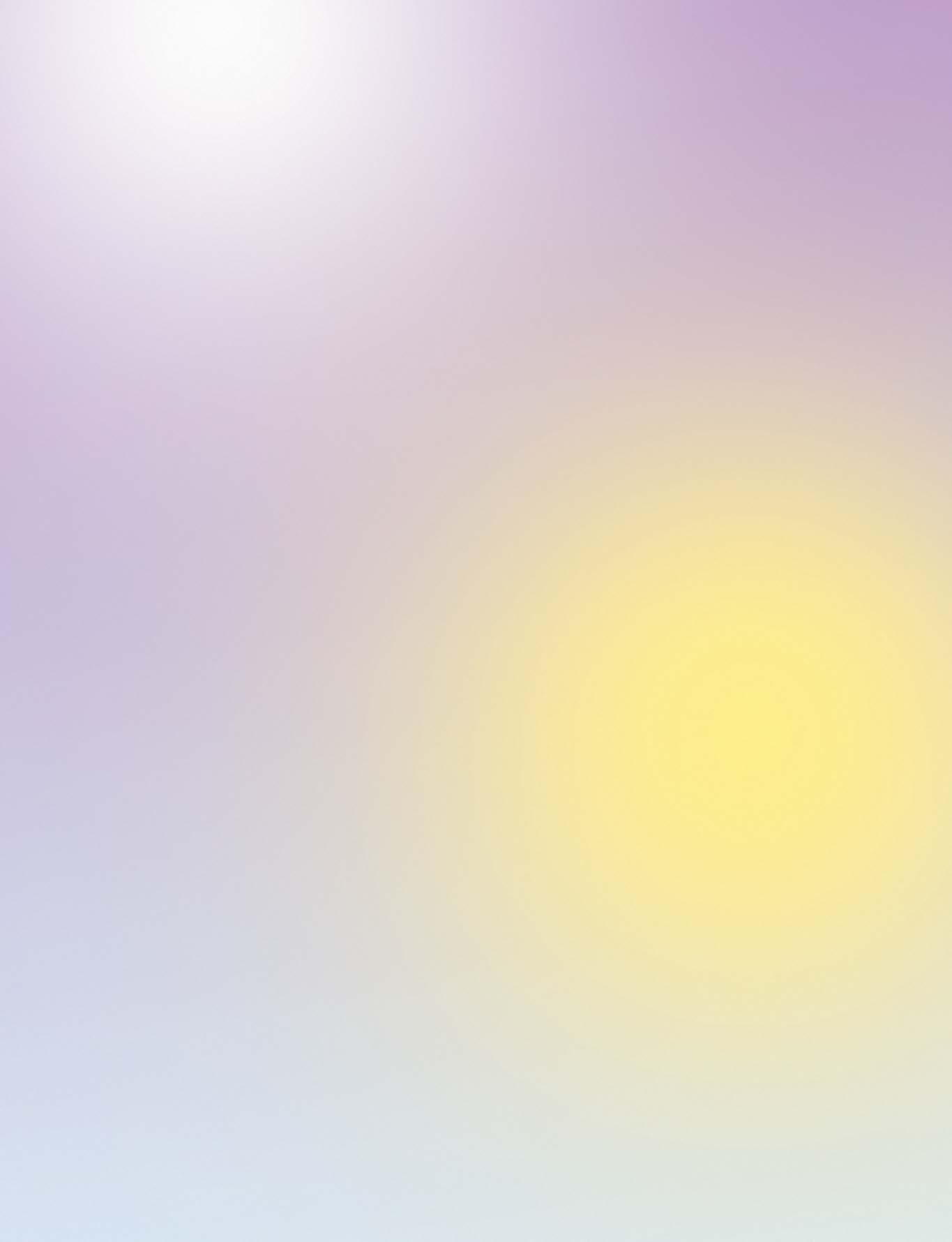
THIS IS YUNG 58-59 TOP WATCHES
VACHERON CONSTANTIN Égérie Moon Phase


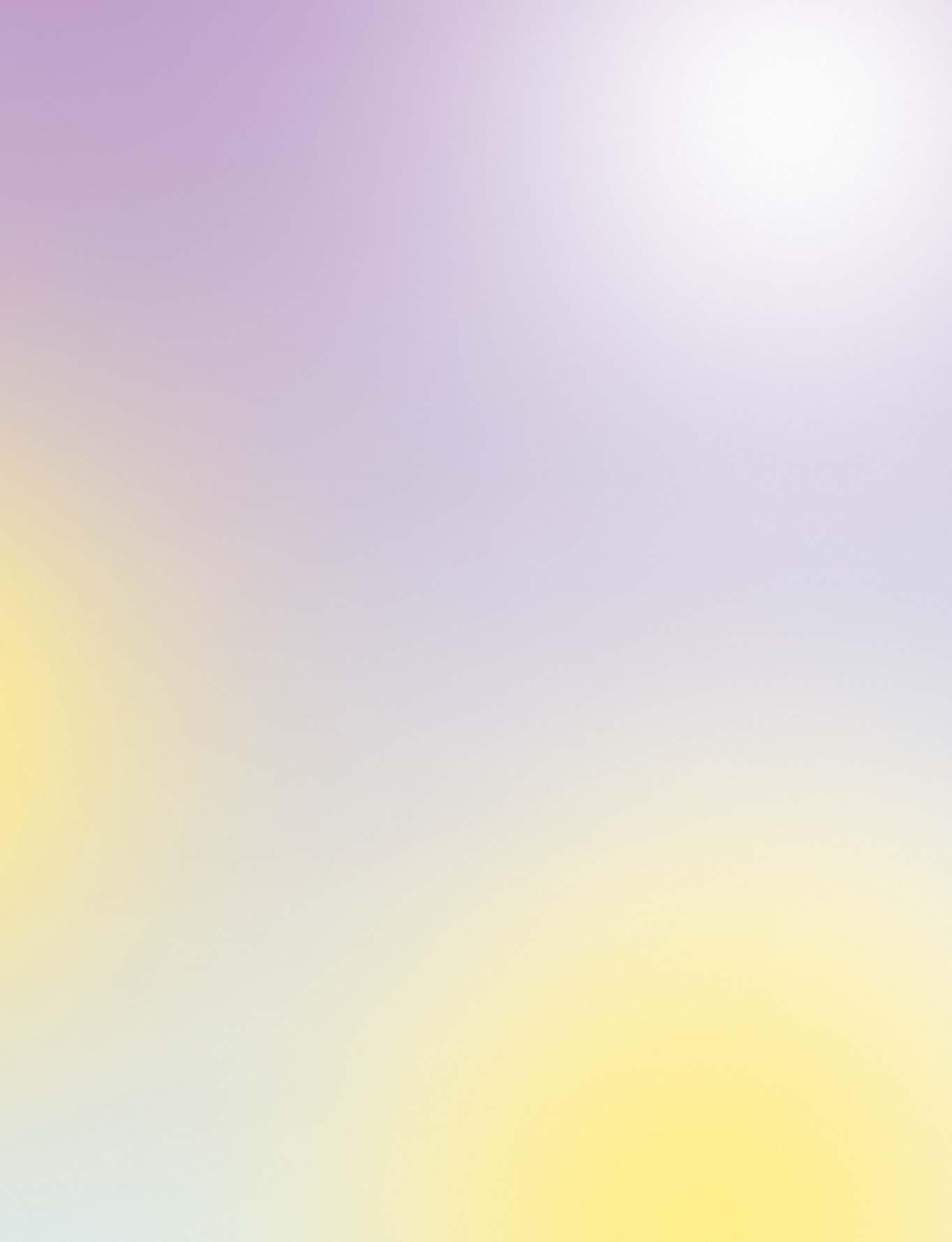
BREITLING Super Chronomat
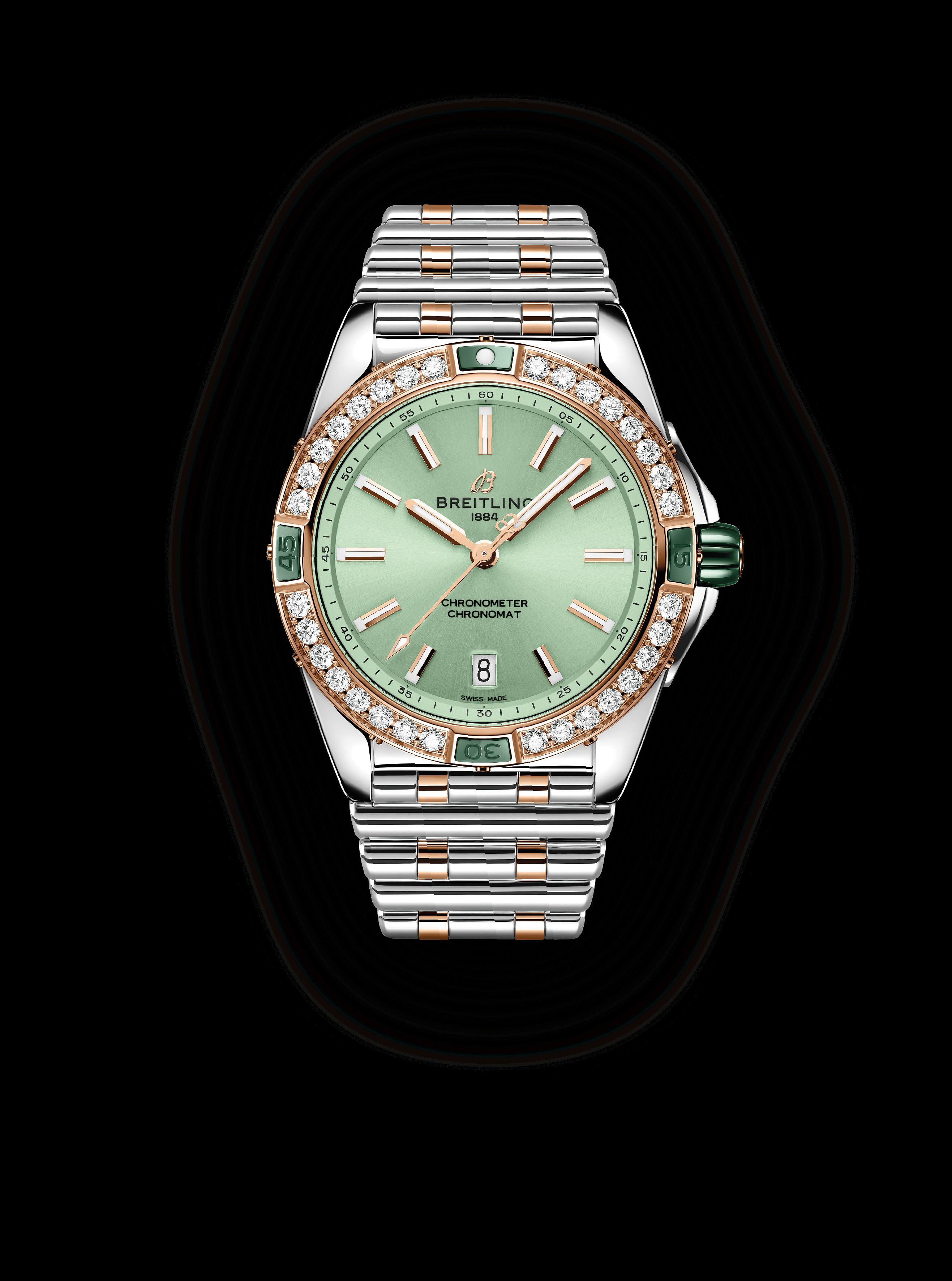
THIS IS YUNG 60-61 TOP WATCHES
CHRONOSWISS


Sugar Rush


CHRONOSWISS image via AHMED SEDDIQI & SONS
TUDOR


Pelagos 39

image via AHMED SEDDIQI & SONS
THIS IS YUNG 62-63 TOP WATCHES
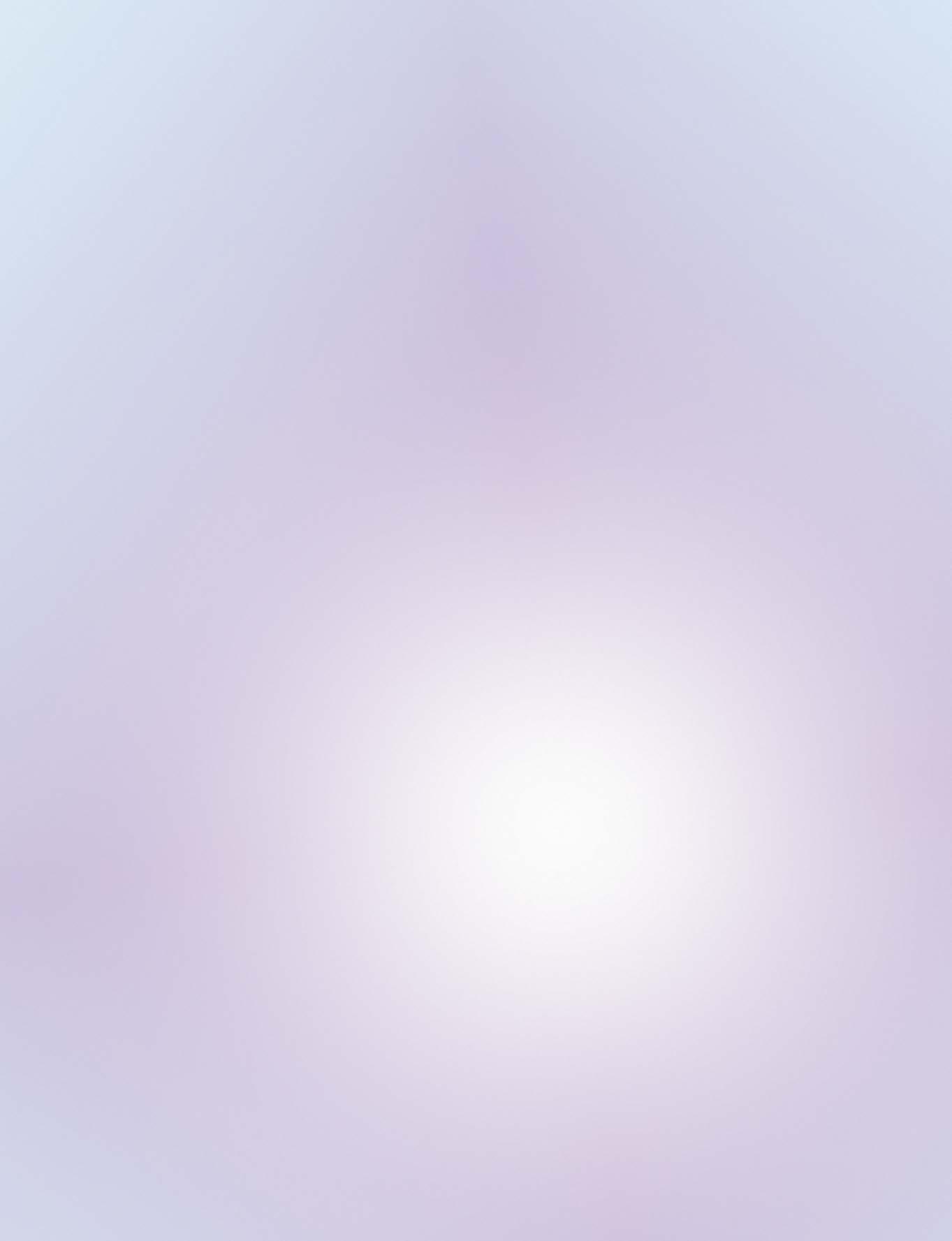


PIAGET Polo Emperador Skeleton Tourbillon


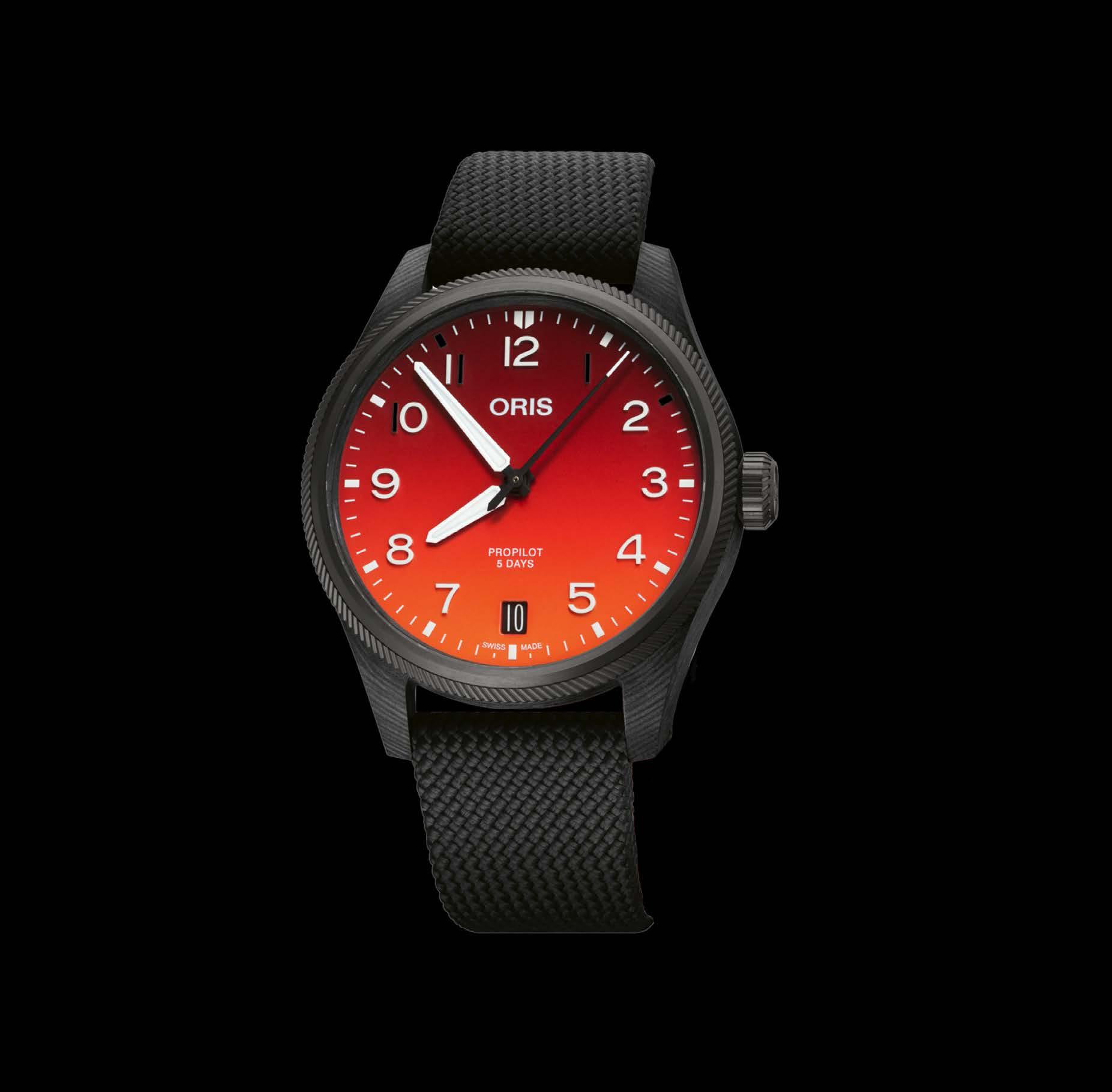
ORIS Coulson Limited Edition 64-65 TOP WATCHES
GIRARD PERREGAUX


La Chaux-de-Fonds


ORIS & GIRARD PERREGAUX
ROLEX Deepsea




ROLEX image via AHMED SEDDIQI & SONS THIS IS YUNG 66-67 TOP WATCHES
ROGER


Spider Pirelli

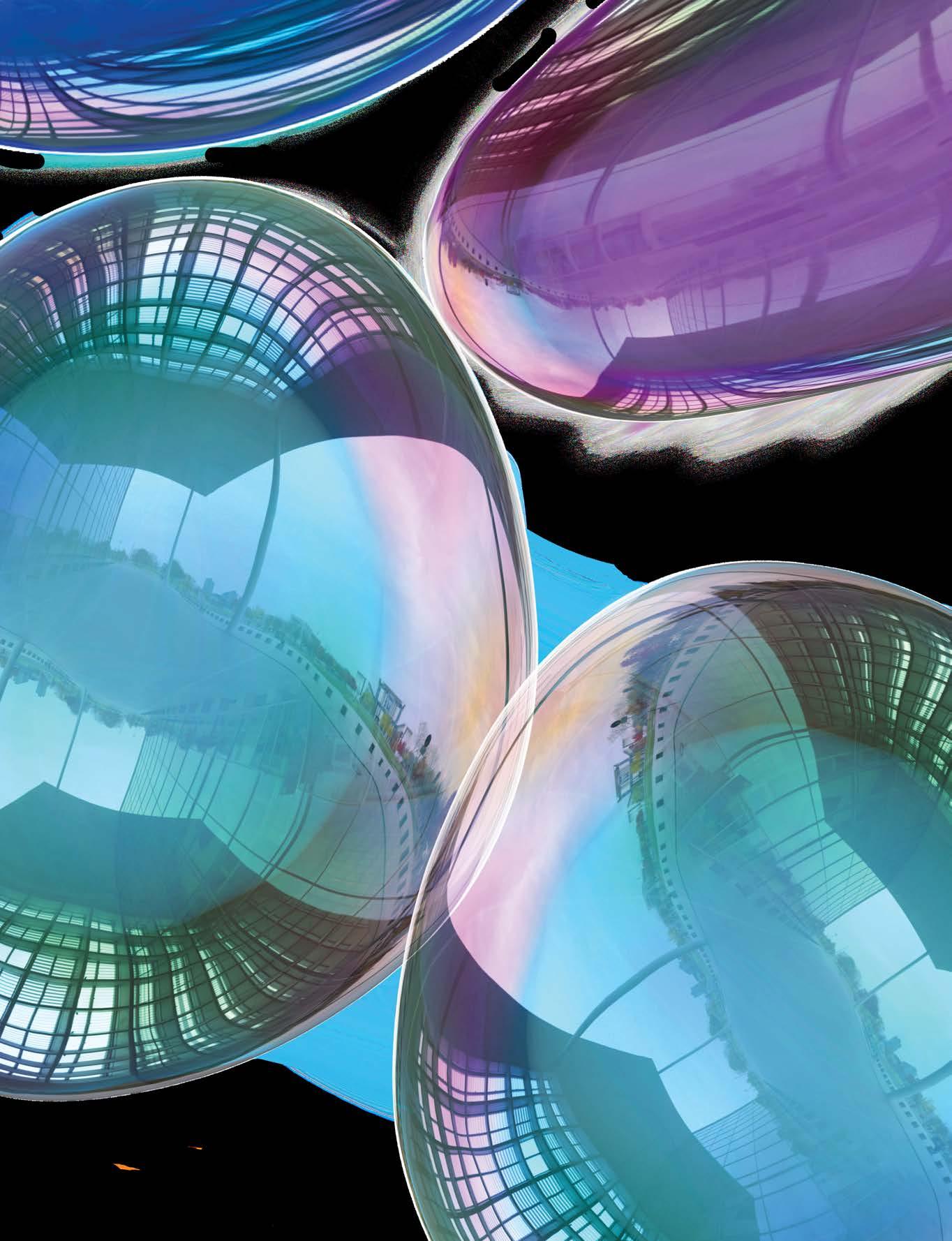
DUBUIS Excalibur
BULGARI


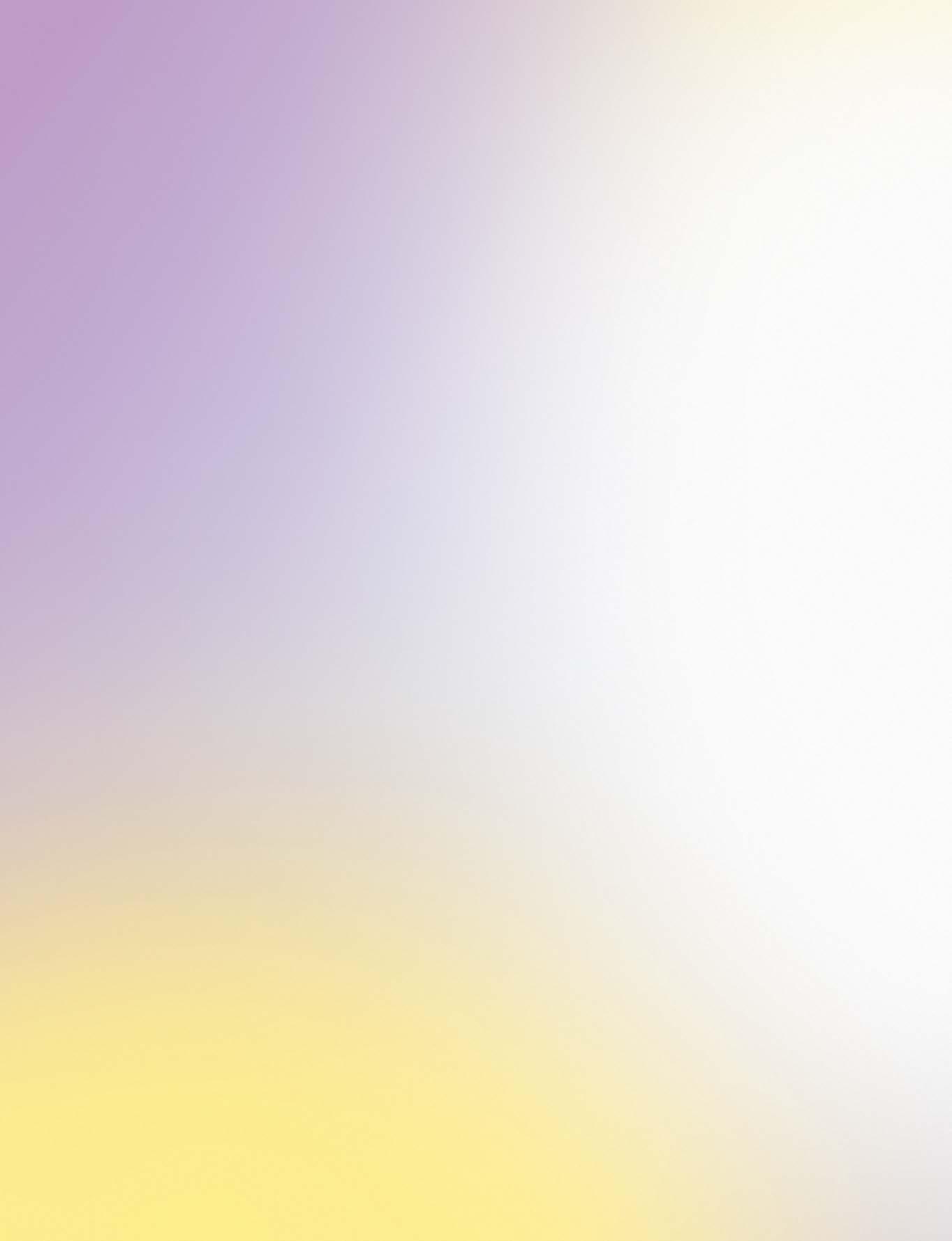
THIS IS YUNG 68-69 TOP WATCHES
Octo Finissimo Automatic




HUBLOT Square Bang Unico
LUCID
Lucid can mean brilliant, shining, luminous. All the things that make something, or someone, shine. Join the stand-out crowd with these eye-catching pieces.

THIS IS YUNG FASHION 70-71

photography DANIEL ASATER styling SAIF HIDAYAH
Dress, shoes, socks, Celine

THIS IS YUNG FASHION 72-73
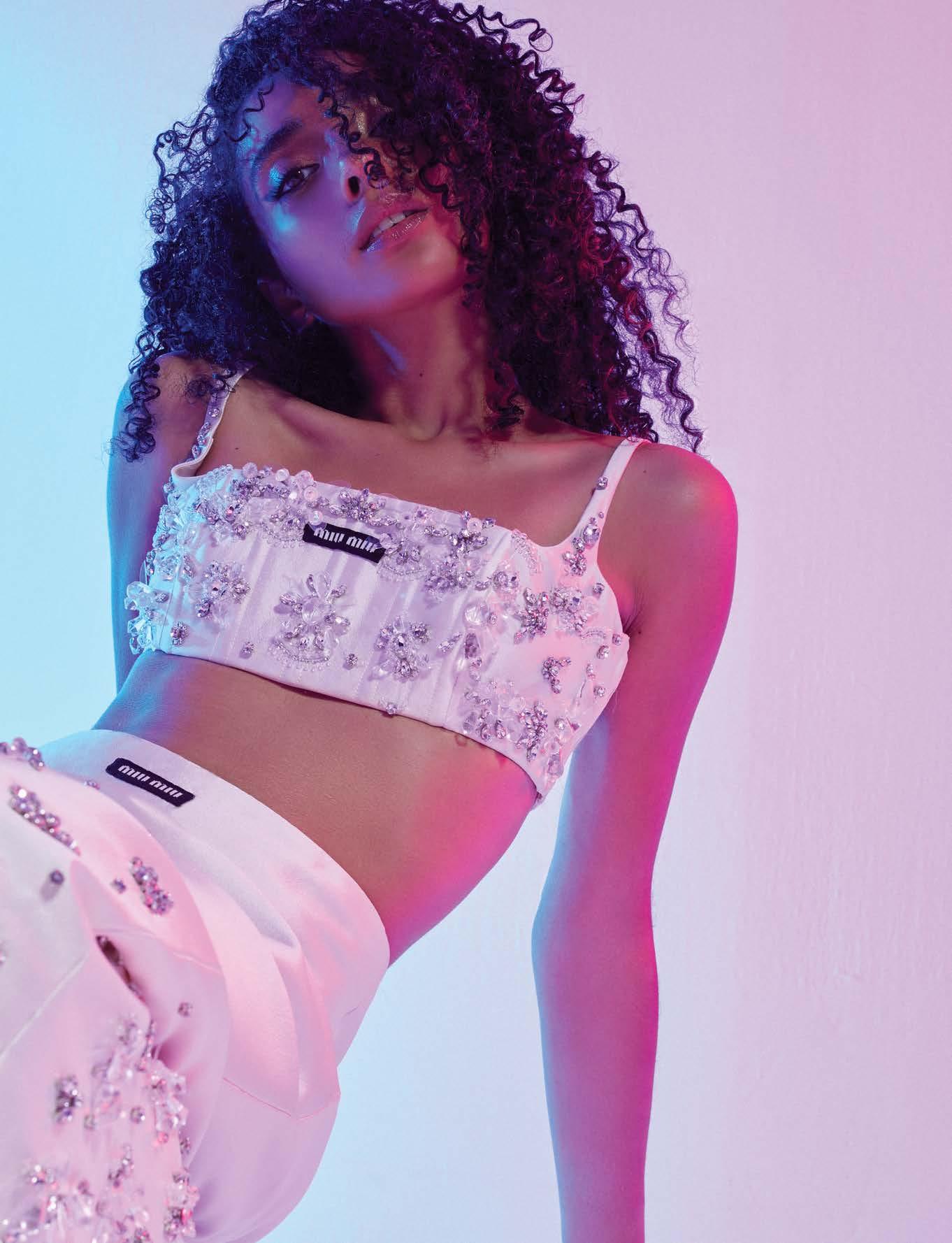 top, skirt, Miu Miu
top, skirt, Miu Miu

THIS IS YUNG FASHION 74-75
Dress, top, Hermes


THIS IS YUNG FASHION 76-77
Dress, gloves, heels, accessories, Chanel
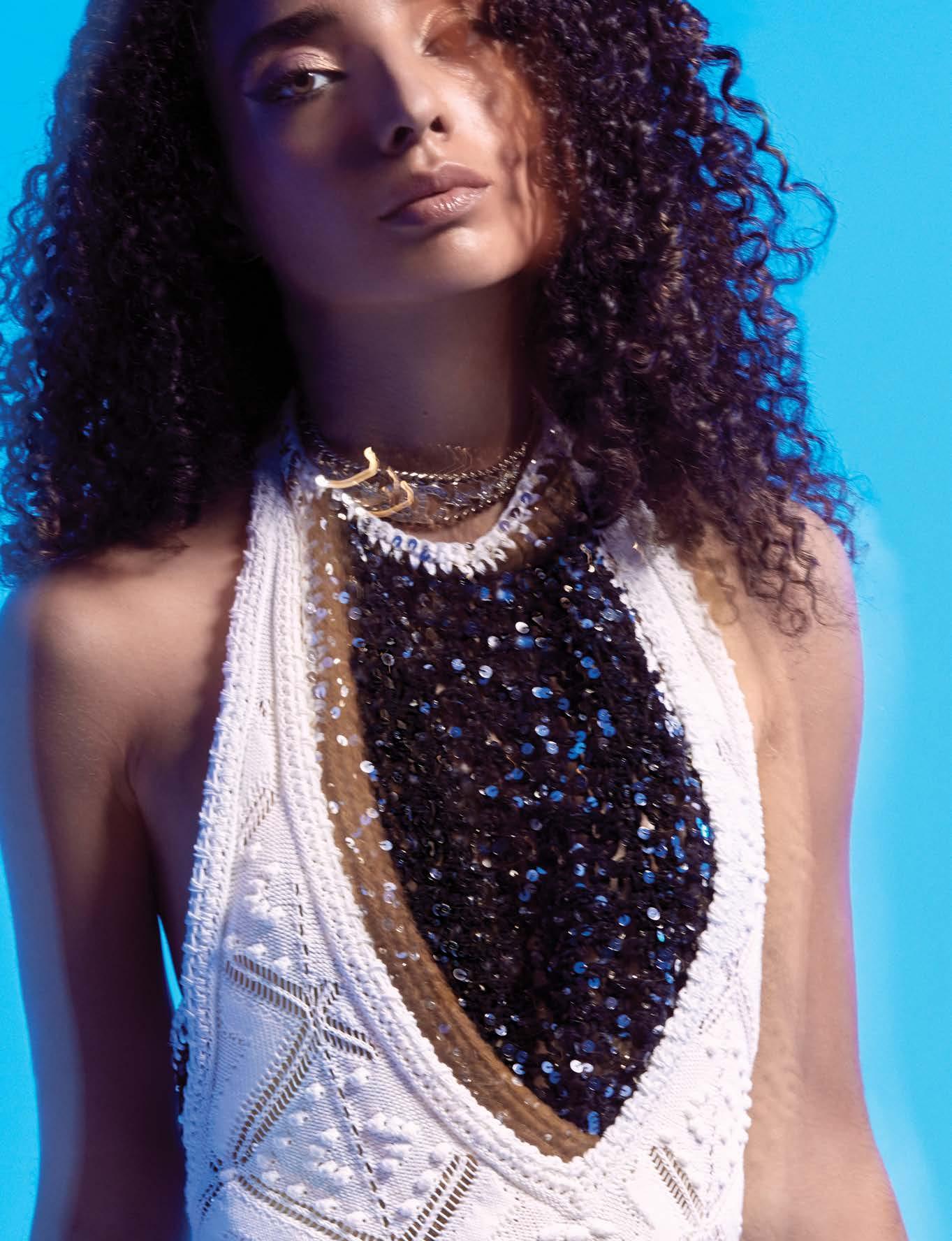
THIS IS YUNG FASHION 78-79 stylist on set SAKINA IBRAHIM; hair & makeup JEAN KAIRUZ model SAJDAH; producer JODY HASSAN
 Dress, heels, Gucci
Dress, heels, Gucci
GEN
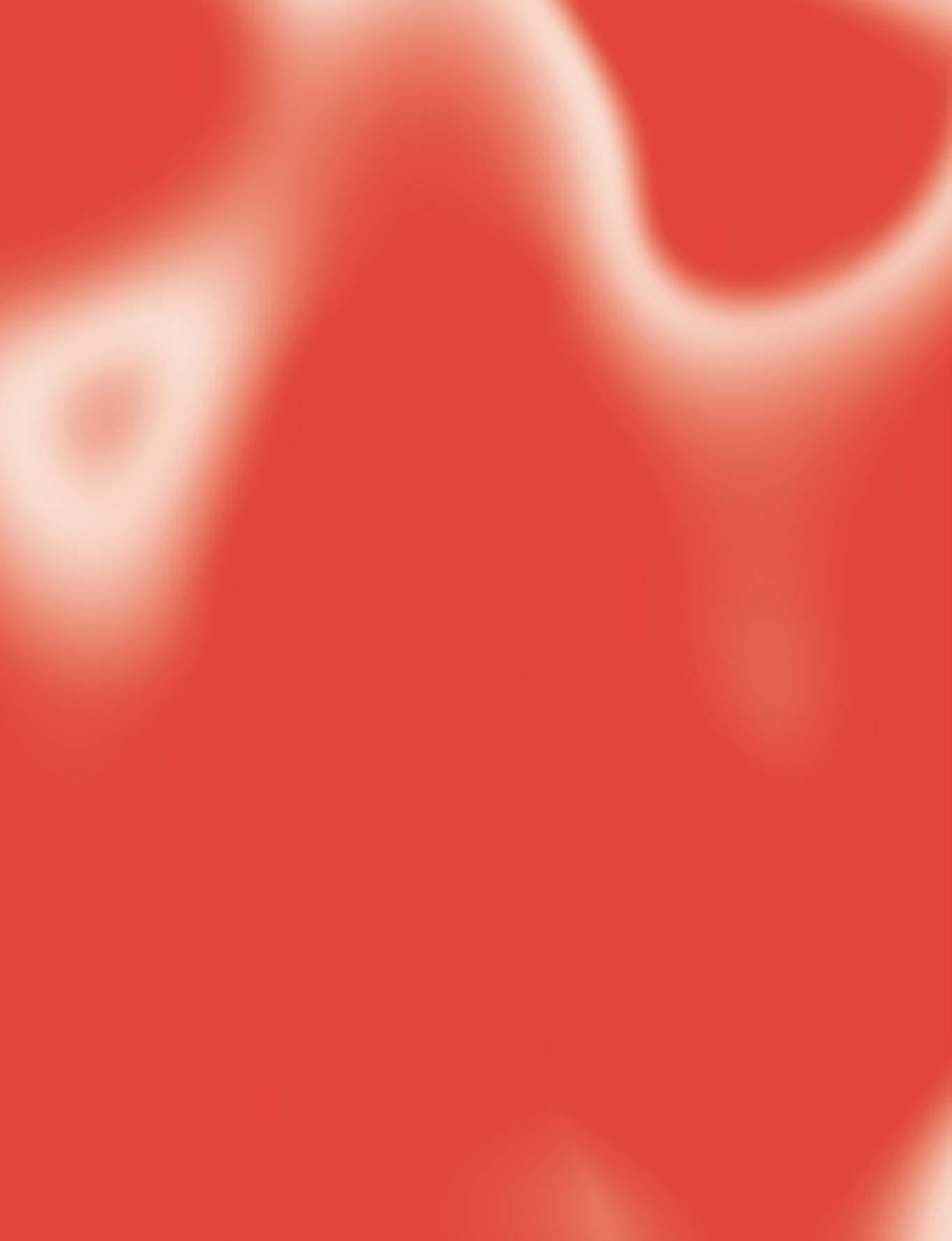
LOVE
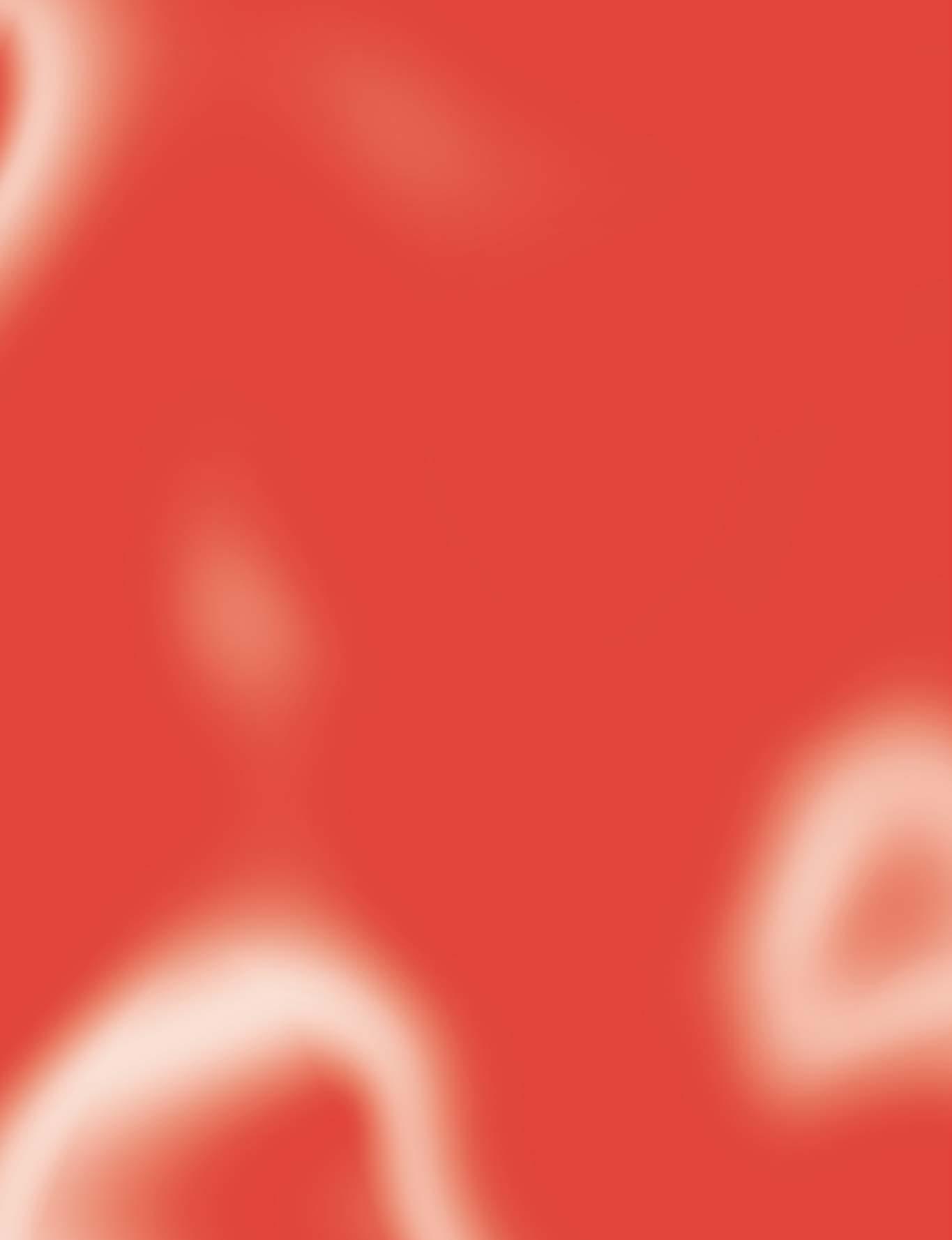
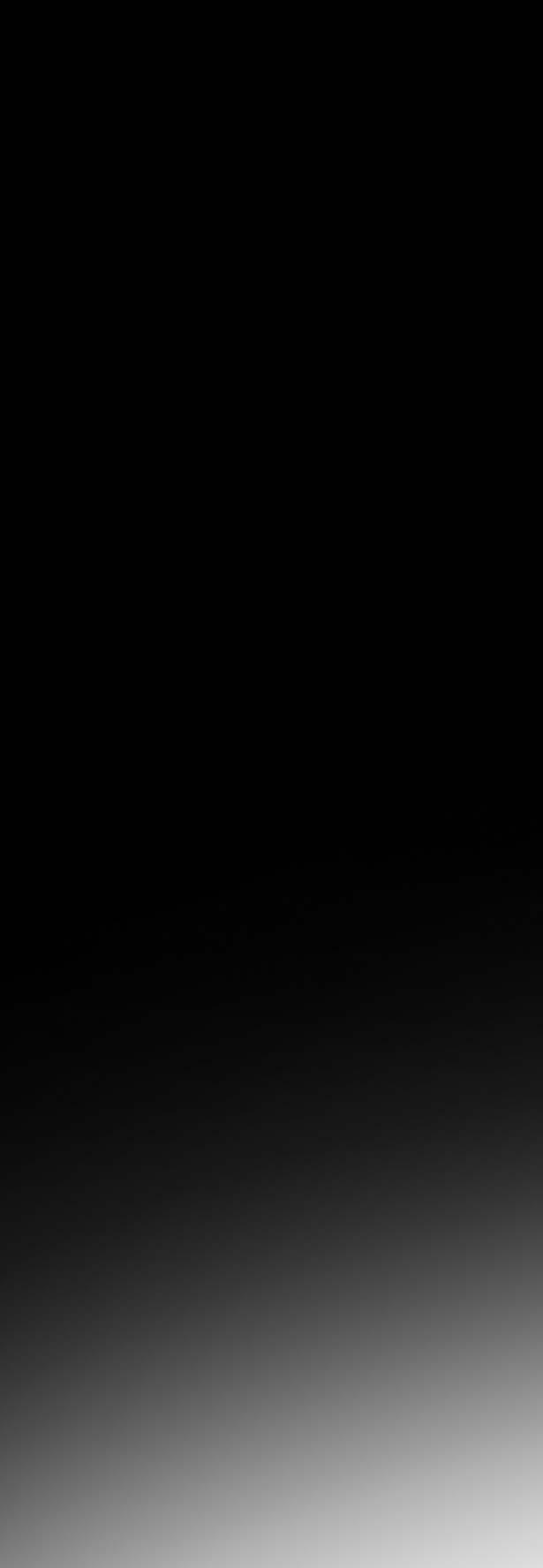

THIS IS YUNG YUSRA MARDINI 82-83
Dress, necklace, Givenchy


 photography JAMEELA ELFAKI styling LATIFA BINT SAAD words SAIF HIDAYAH
photography JAMEELA ELFAKI styling LATIFA BINT SAAD words SAIF HIDAYAH
Yusra Mardini is on a mission to challenge attitudes towards refugees. It’s a subject the Olympian knows only too well, escaping war-torn Syria – along with sister Sara – and even helping save lives during a treacherous boat crossing from Turkey to Greece. Right now, the first step is a Netflix premiere – her Netflix premiere. The Swimmers is the story of two sisters who escaped.
“When I was three years old, [my dad] had probably set every goal for me in my athletic life,” Mardini explains joining YUNG via Zoom from Los Angeles. She grew up amongst a family of swimmers and the sport was a generational legacy that would be passed down to her and her sister, Sara. “They expect you to become an Olympic champion,” she says laughing. “When I started, I hated it, I would always run away from it because it was cold, and I would cry.” Her earliest memory of the sport is of her dad throwing her in the pool while the Syrian national team trained, “I learned how to swim away from them and I didn’t like it. I remember hiding under my mum’s chair because I did not want to swim.”
Her father was her swimming coach in Damascus. “In the pool, I always called him coach. He would tell me, at the pool, I’m not your dad, I’m your coach and you have to respect everything I have to say. I always trusted him and I always respected him in the process. This was something that taught me a lot about life. He really was professional.” While that proved to be difficult, Mardini doesn’t deny the fact that her father was a great coach. “In the beginning I thought I was doing it for him, but slowly, I realised that I really am passionate about swimming. I’m very stubborn and I had the determination to become an Olympian.”
Swimming would consume Mardini’s teenage years. She would be picked up from school and would immediately go to training practice everyday. “I did a lot for swimming, I guess it was just preparing [me] for life and I’m thankful [my dad] was tough on me because it taught me a lot. It’s funny to me now that I think of it,” she giggles.
Driven by her passion to compete in the Olympics, Mardini’s will to live and fulfill her lifelong dream was a constant. It just seemed something preordained, that would happen no matter what the odds. Then the civil war broke out in Syria in March of 2011. It was a moment that would change the trajectory of her life.
“The first time I heard of war, I was on a school bus and one of my friends was talking about what happened in Daraa, another city in Syria. At that time I never imagined that a war would break out. We thought it was a small problem that would go away. [Later] the area I was living in started to be one of the very problematic areas, and we [ended up losing] our house.” The Mardini family would be forced to flee their hometown, moving into different apartments every few months as the war intensified. “They would cut water, electricity and the food was getting expensive.” While the place she once called home continued to collapse right before her eyes, her parents would attempt to shield the difficult news in hopes of protecting her and her sister Sara. “As an Arab, politics is a red line. We do not discuss politics.” However, listening to the news was inevitable – it was their everyday lived experience, no matter how hard her parents tried to shield them from it.
THIS IS YUNG YUSRA MARDINI 84-85
“It was either stay in Syria and risk my life everyday, or risk it one last time and be safe for the rest of my life.”
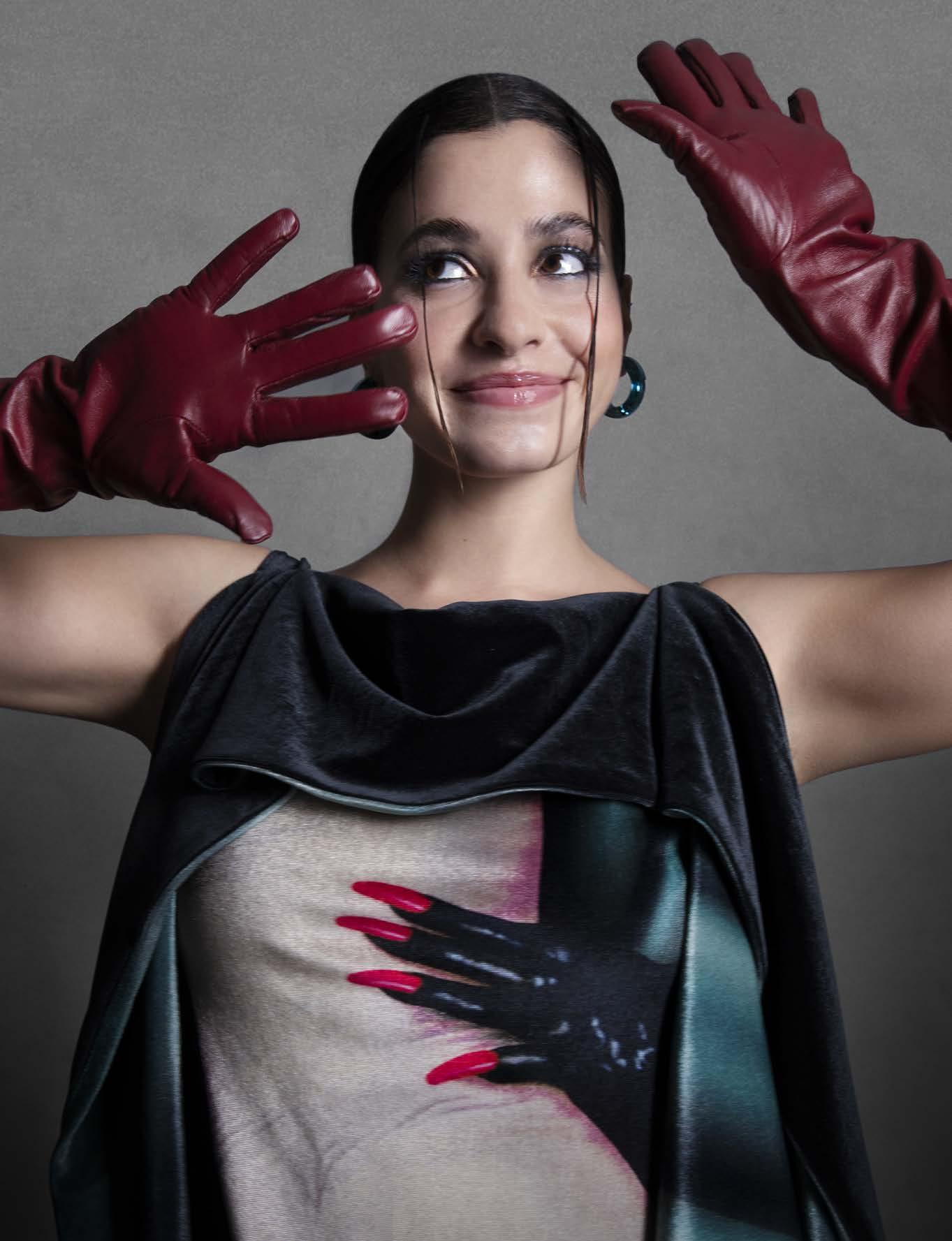 Dress, Loewe. Earrings, Swarovski. Gloves, stylist’s own
Dress, Loewe. Earrings, Swarovski. Gloves, stylist’s own

THIS IS YUNG YUSRA MARDINI 86-87
Jacket, trousers, heels, Balenciaga
Mardini’s life in Syria was no longer the same, in fact it was no longer safe. “At the time we didn’t have a lot of choices. It was either stay in Syria and risk my life everyday, or risk it one last time and be safe for the rest of my life.”
The movie, directed by Sally El Hossaini, perfectly depicts the athlete’s life in Syria at the time. “As you can see [in the movie], there was a normal life while having war, and I think many Arab countries saw that, not just Syria.” She would hear the bombings everyday – a constant reminder that her life could end at any moment. “The West [views] the Arab world as grey, where everything in it is destroyed, and I think it was important to show that even though we had war, we were trying to have a normal life as well. Unfortunately, it became normal for us to listen to the bombing and to [carry on] with our lives.” This sad reality rang true; however, she hopes the movie will be able to show that Arabs are full of life and their world is colourful with so much culture and history even during conflict.
As much as she had hoped to achieve her dreams from Syria, Mardini had to make the difficult decision to leave the country with only her sister Sara by her side. As she sits behind her Zoom screen from Los Angeles, she pauses to reflect on her time there. “Syria is my first and most important home. I really miss it. I miss the food and the people. I miss just walking around there. I didn’t realise how much I loved my country until I left and that is the sad part for me. We had to risk everything to try and find a better future and have a safe place to stay.”
The sisters would eventually reach Germany, after a long and traumatic journey. In the process, she found herself on an overcrowded dinghy in the Aegean Sea. What was initially supposed to be a 45-minute trip from Turkey to Greece, took around four hours. When their dinghy’s engine failed during the dangerous crossing, and the boat started taking on water, Mardini and her sister plunged into the icy depths to help push their fellow refugees to dry land on the Greek island of Lesbos. “I would be lying if I told you if I had a clear thought. There was no clear thought. I was just in the water, I just wanted to make it to shore and it felt like I was seeing the island but was never able to reach it. It was one of the hardest things I had to do in life,” she explains, reliving the sense of despair. “It was survival mode. I saw my sister [jump in] and I thought if she can do it, I can do it too. I thought of the people on the boat who didn’t know how to swim. It was [also] scary because they knew my sister and I were swimmers and because we did our lifeguard license, we knew if you’re a swimmer, they might panic and might pull you down with them if anything happens.” Selfless and determined, Mardini’s main objective at the time was to make sure everyone on the boat was going to reach the shore safely. “I could have swum it. I swam in open water in Syria before, but it broke my heart that none of them knew how to swim.”
Mardini’s experience at sea is still very vivid. “I do speak about it a lot because I want people to understand that there are millions of refugees around the world and this is still happening and people are still crossing. I was one of the lucky ones, I’m alive and I’m still here, but there are a lot who lost their lives trying to make it to safety. I do not want to remember [it] and it’s hard to think that at just 17 years old I was forced to make such a horrific journey just to be safe and to enjoy the simplest human rights.”
After finally arriving in Germany, 25 days after leaving Syria, Mardini would contact the local swimming club near the refugee centre where she was temporarily residing at the time. The coach, Sven Spannenkrebs, not only agreed to let them train, but managed to get Yusra on to the newly formed refugee team for the 2016 Rio Olympics. Just a year after that near-deadly boat trip, Yusra was in Rio, the flag bearer for the IOC Refugee Olympic Team and her story made headlines around the world.

THIS IS YUNG YUSRA MARDINI 72-73
Jacket, Valentino. Heels, ByFar. Belt, stylist’s own
YUSRA MARDINI 88-89
“We dodged a lot of bullets, we lived in Syria and our house was destroyed, I lost a lot of friends and a lot of people around me.”

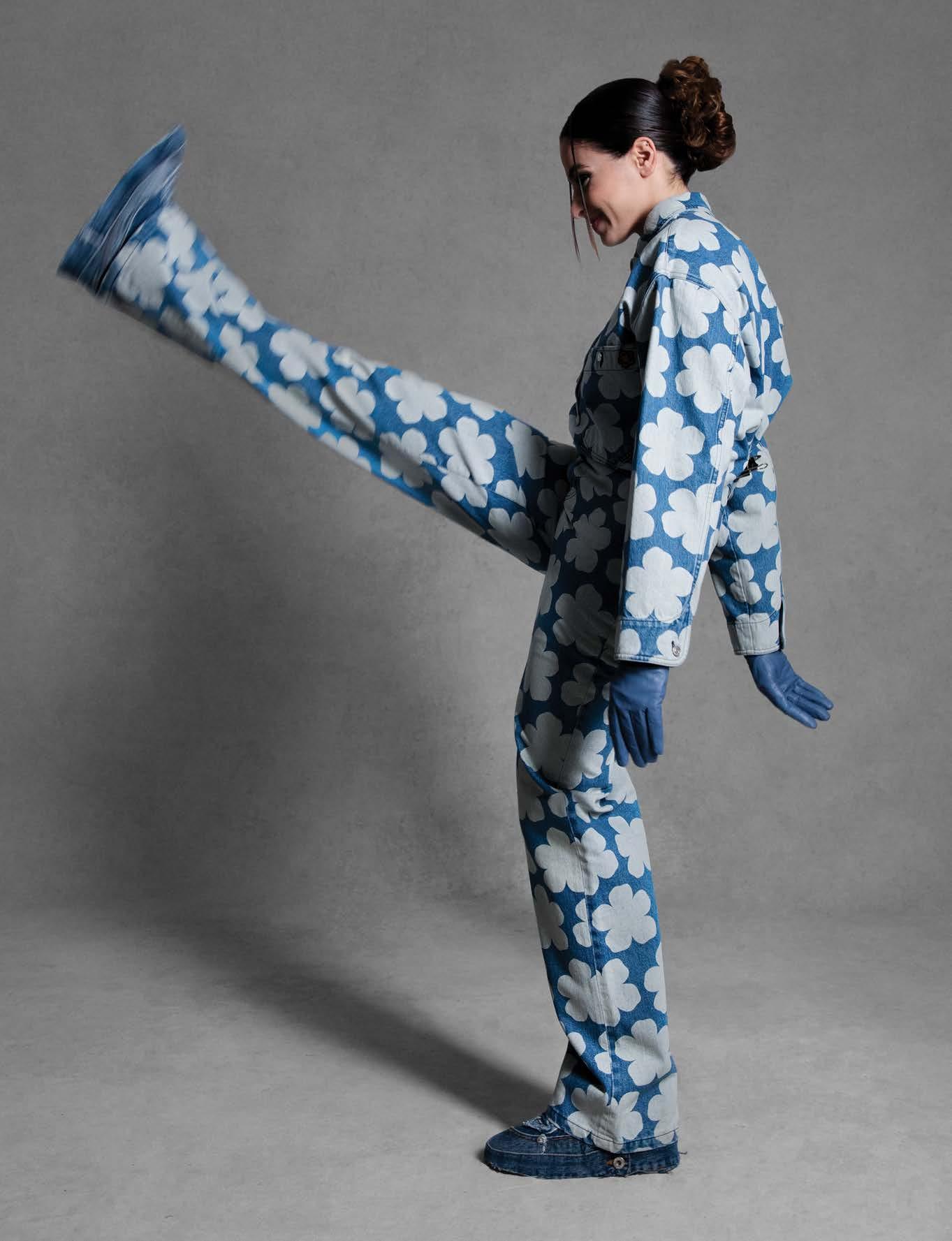
THIS IS YUNG YUSRA MARDINI 90-91
Jacket, trousers, shoes Kenzo Gloves, stylist’s own
Unsurprisingly, Mardini’s journey has come at a cost – namely her mental health. “I’ve sought help. I didn’t immediately have any, but over the years my sister literally forced me to. She started going to therapy and the therapist was someone my she trusted a lot. I did it for a while and it helped me a lot. It’s a safe space where you can talk about everything.” Today, Mardini has come to accept and understand why she was forced to go through this experience. “Even if it’s confusing and unfair, I really believe that I am lucky and that I did achieve my dream – and that’s incredible. I went to two Olympic Games and I’m in a position where I am able to help people.”
The film also reflects something accurate about Mardini’s relationship with her sister. “My mum raised us as twins. We would wear the same clothes and I think many are like us. We would do everything together. My friends were also her friends. But we are also very different. She was the rebellious and wild one that never listened and I would always try to do everything perfectly, not to make my dad angry. I learnt a lot from her. I actually learned English because of her. I wanted to copy her and be better than her, the competitive side always got the best of me,” she bursts out laughing. “We have a special bond and I think that’s what helped us on the journey, because we understood each other and we knew no matter how different we were, in the end we would literally do anything to help each other.”
These days, Mardini is as bulletproof as ever. Sia’s song “Titanium,” takes centre stage in the movie and it’s a beautiful metaphor that rings true to her experience. “I’m Bulletproof, nothing to lose, fire away, fire away,” she sings on call. “We dodged a lot of bullets, we lived in Syria and our house was destroyed, I lost a lot of friends and a lot of people around me. So many things have happened but here we are, we’re still trying, still alive and we’re lucky to be alive.”
While Mardini did just get her German passport, she believes that she will always be a refugee because of what happened to her and who she represents. “I will always represent refugees around the world and I want to encourage them to get to the level that I got to and to be able to say that I am a refugee and I’m proud of it — this is a part of me, I didn’t choose to go through this journey, but I went through it in the best way I can. It took me a while to understand and be okay with that word because again in the Arab world, you’re taught that being a refugee is not a good thing, and that’s the same around the world too.”
By understanding the responsibility she carries representing millions of people just like her around the world, today, Mardini is just as driven as ever — but she has new found goals to achieve. “I have a strong voice to change something better for the world.” Beyond her swimming, Mardini’s plans for the future include continuing her role as a UNHCR Goodwill Ambassador and launching her own foundation in the US and in Germany, which will focus on sports and education. She just moved to Los Angeles to study film and TV production at the University of Southern California. As for her swimming career, she will take a short break to decide whether she wants to continue, but as it currently stands, swimming competitively is not on the horizon. Despite being thrust into the Hollywood spotlight, she has not lost sight of her calling, and if her life story is anything to go by, the world really is her oyster.
“Even if it’s confusing and unfair, I really believe that I am lucky and that I did achieve my dream – and that’s incredible. I went to two Olympic Games and I’m in a position where I am able to help people.”

THIS IS YUNG YUSRA MARDINI 92-93
creative direction SAIF HIDAYAH; photo assistant OLIVIA GLOFFKE; makeup ZANA MOSES; hair JOE KELLY; set designer YOUSSED EL SAYED; executive producer LANA SHASH; production assistan NUJOUD OWEIS; styling assistant AGNĖ KAMINSKAITĖ
Dress, Lurline Earrings, Swarovski
“It’s hard to think that at just 17 years old I was forced to make such a horrific journey just to be safe and to enjoy the simplest human rights.”
MULTIHYPH EN ATE
photography ISMAEL NEBCHI styling TAHI GUY words MENNA SHANAB
THIS IS YUNG ALI LATIF 94-95
 Top, shoes Maison Margiela Trousers, Highlight
Top, shoes Maison Margiela Trousers, Highlight

THIS IS YUNG ALI LATIF 96-97
Jacket, top, trousers, shoes, Prada
Never stop dreaming. Keep faith. You never know what life is going to bring to you.”
In a sea of multi-hyphenates, few are able to strike the right balance between their creative pursuits. Tunisian model-turned-musician and aspiring actor Ali Latif, however, is determined to do it all, fighting tooth and nail for his moment in the limelight. From living on the streets of Paris and getting by on make-rent gigs to shooting campaigns for Versace and producing his own music, Latif is driven by an unwavering perseverance, shooting for the stars and grinding out success on his own terms.
Born in Tunisia and moving to the South of France with his family when he was seven, Latif navigated a tough childhood split between two cultures; held back by dreams difficult to achieve and battling disillusionment, alienation and discrimination all his life. But he never lost faith and hung on to the hope that his big break would come soon. This would become his life mantra.
“Dream. Never stop dreaming. Keep faith. You never know what life is going to bring to you. I’m the perfect example of this. I was homeless. I was 18 years old. I was living on the streets in Paris, but nevertheless every day I was thinking to myself ‘okay, something’s going to happen’ - this is why I’m here today.”
Latif had a lot of dreams but becoming a model was never one of them. When he left his job as a cashier on the French Riviera and ventured out to wrestle the cosmopolitan jungle of Paris, he was daydreaming about a career in music or cinema. It was while working in a bakery in Paris that Latif was discovered - by Jeffrey Kolsrud, the owner of Q Model Management, as Kolsrud purchased a croissant on a morning out in the French capital. “I came to Paris a few years ago to change my life,” says Latif, “I wanted to become an actor and do music, that was my intention when I arrived here. But then lots of new things came into my life. I was not supposed to be a model but it came to me. I was scouted in a bakery and I thought ‘okay, this is going to open a lot of doors.’”
Wading through euro-centric standards and blatant discrimination, Latif still managed to rise through the ranks, modelling for Versace, Coach and H&M, and shooting for prestigious publications. His face has graced the pages of Vogue Spain, Fantastic Man, and the Balmain hair products line. He has also walked for French labels AMI and Haider Ackermann. But the model life was not all glamour and glitz. For Latif, he always felt othered and alienated by the fashion establishment. The modelling space was not welcoming of outsiders but Latif pushed on and achieved his goals by way of hard graft and a steadfast belief that anything is possible. “A few years ago, I was one of the only Arabs in the industry. I struggled a lot. People asked me to change my name and a lot of people told me that I will never work because I’m an Arab.”
Even after snagging campaigns with some of the world’s most prestigious fashion houses, Latif still had difficulty navigating the modelling space in Europe. “Before the Versace or Coach campaign, though they came early in my career, it was a nightmare for me. I was not accepted anywhere. Even after those campaigns, I have always felt the rejection. I don’t come from a rich family: my father is a builder and my mum is a cleaner.”
“Dream.

THIS IS YUNG 98-99 ALI LATIF
Jacket, top, trousers, Valentino Shoes, Talent’s own

“Fight for your dreams because if you don’t, nobody is going to do it for you.”
Latif hopes his story will inspire the younger generations in Tunisia to shoot for the stars. That nothing is out of reach and that if you believe ardently in your dreams, everything will align for you. The key for him is perseverance and not wallowing in self-pity and resentment. “I don’t want to think that if I don’t get something, it’s because I’m an Arab because if you go down this path, it’s going to be very hard for you. You will give up very quickly. You have to discipline yourself. You have to think ‘I’m going to make it even if I’m from a marginalised group’. Fight for your dreams because if you don’t, nobody is going to do it for you.”
With his popularity as a model both in France and in Tunisia, Latif was able to naturally transition into the musical realm, finding a place for himself in the Franco-Tunisian rap scene. This pivot isn’t his first dance with music, though. His penchant for music was born long before Latif ever posed in front of a camera. “I’ve always been into music; since I was 10 years old music has been a kind of therapy. Music saved me when I was younger.” Today, he continues using music as an outlet, a coping mechanism, a platform to voice his struggles.
He tells his own personal story as an Arab swimming in the diaspora. His work speaks to the struggles and dreams of a generation of Middle Eastern youth. “My music talks about the issue of being an Arab in France. It talks about the struggle of surviving every day when you’re a poor kid, when you have no money, when you come from nowhere.” His music sends a message to those scared to take the leap and chase their dreams. “It’s for the people who are talented but who lack courage to leave their hometown, to go somewhere else. Where I grew up in the South of France, no one ever left. Everyone is born there and they stay there. They never leave because they think that there is no life outside of this circle. I’m trying to give a message of hope. I want to say to other kids that everything is possible.”
Growing up, Latif listened to a fusion of French and American rap from the 90s, which later morphed into a passion for popular Tunisian and Egyptian music, as he crossed borders and grasped for his roots in the diaspora. “I am a bit lost. Often in Paris they say you are Tunisian, but when I am in Tunisia they say you are French. What a strange world we live in.”
The question of identity is present in all his music. Embracing his Tunisian roots and integrating them into contemporary hip-hop, Latif created a unique sound that replicates the music he grew up with. His music is at the intersection of the multiplicity of cultures that moulded Latif into the person he is today.
In the midst of COVID-19, Latif hibernated at a Parisian studio and kicked off the musical chapter of his life, going on to release a string of feel-good rap singles. His Franco-Tunisian fusion is an ode to his roots, a celebration of his success and a message of empowerment. Although he’s taken a small hiatus after his last EP ‘520’, Latif tells us he’s brewing up a handful of new tracks and plans to release them in the upcoming months. Watch this space.
THIS IS YUNG ALI LATIF 100-101
 Top, Louis Gabriel Nouchi. Trousers, Maison Margiela.
Shoes, Hermes. Cap, stylist’s own
Top, Louis Gabriel Nouchi. Trousers, Maison Margiela.
Shoes, Hermes. Cap, stylist’s own

THIS IS YUNG ALI LATIF 102-103
Top, Louis Gabriel Nouchi. Trousers, Maison Margiela. Shoes, Hermes. Cap, stylist’s own
“I’m trying to give a message of hope. I want to say to other kids that everything is possible.”

THIS IS YUNG 104-105
Top, bag, Kenzo. Shorts, Givenchy. Shoes, Comme des Garçons

ALI LATIF THIS IS YUNG 106-107
“A few years ago, I was one of the only Arabs in the industry. I struggled a lot. People asked me to change my name and a lot of people told me that I will never work because I’m an Arab.”
Jacket, trousers, Loewe

agent SAIF MAHDI; hair CONSTANCE HAOND; makeup BENOIT CLAVERIE; location KARIMA PEYRONIE production MEDIA UP PRODUCTION, FASHION AND ART MOROCAN ASSOCIATION
THE DIVINE FEMI NINE
YOUSRA MOHSEN 108-109 THIS IS YUNG
photography AXL JOZEPH styling SIR WILLOW words MENNA SHANAB

Full look, Prada

YOUSRA MOHSEN 110-111 THIS IS YUNG
look, Prada
Full
Enrobed in prismatic lights, moving her body without inhibitions, bewitching the audience with her feminine prowess - it is on stage, performing, that Yousra Mohsen feels most liberated; freeing herself of expectations and confronting the societal, male gaze head-on.
In her journey towards building a profession out of dancing, the 22-year-old performer of Lebanese origin had to walk the tightropes of the conservative society she grew up in, navigating cultures of ‘3eib’ and breaking free of the shackles of a patriarchal society to emerge as the unapologetically fierce and feminine force she is today.
For Mohsen, her personal battle for women’s rights and social freedom is waged on the stage, where she breaks social taboos with impunity and hypnotic choreographies anchored in empowerment. She is the embodiment of the new generation of Middle Eastern women – fearless, bold, jet set on liberating their bodies and reclaiming narratives. At just 18, Mohsen made history - and caused quite an uproar back home - becoming the first woman of Middle Eastern descent to join a legendary Parisian cabaret.
Her infatuation with dance, however, started well before that. “I had been both dancing and horseback riding (showjumping) since I was around five years old.” After graduating from L’Académie Internationale de Danse in Beirut, with a wealth of training in classical, contemporary, jazz and folk dance under her belt, she toured the world with Lebanon’s Caracalla Dance Theatre, and found herself enamoured by the concept of travel through art. “It was touring with the Caracalla Dance Theatre in 2015-2016 that awakened something in me. I felt the urge to get more of this sensation - discovering new countries and cultures while dancing and doing what I loved most.”
“Whenever I am on stage I feel powerful and I do my best to try and translate this power that I feel to the audience, through a simple look or by the way I initiate a movement.”
“Dancing is like entering another world, a freer world where I just naturally blend in.”
From there, Mohsen never let go of her dream of becoming a professional dancer and continued to seek out experiences across the world through dance. “I joined a French cabaret and we went on tour in 2019 through Uruguay, China and Prague. I also had the opportunity to work with the singer Mika. We performed on different stages across Europe and shot a music video in Spain. This is what I love most about my job, constantly travelling and never having the same office. It is all very exciting.”
Despite these whirlwind adventures around the globe, it is Paris that she now calls home. Six years ago, the young dancer left behind her beloved Beirut and landed in the City of Love to pursue her dreams of becoming a performing artist. After a glitzy night of fantastical performances in a venue on the Champ-Elysées with her mother, Mohsen knew this is where she belonged. Exhibiting the beauty of a woman’s body ignited something in Mohsen, so she decided to apply to be a dancer at a historic burlesque venue in Paris. She went on to pass the auditions and become the first Arab woman to ever dance here.
When she dances burlesque, Mohsen melts entirely into her alter ego Laïla Liberty. “Laila means night in Arabic which stands for my Lebanese roots. Liberty is basically everything I look for in life and what I wish for everyone: freedom.” Laïla is dominant, courageous, fierce and confident, and as she performs the character, Mohsen feels herself imbued with the imagined qualities. Dancing as Laïla Liberty, I am not fully myself anymore, it is hard to explain. It’s like entering another world, a freer world where I just naturally blend in as Laïla. All the preparations before shows - rehearsals, warmup, makeup, costume - definitely help me transition smoothly from a normal woman to a performing artist on stage.”
Through elaborate movements and gaudy avant-garde outfits, Mohsen was able to throw off the mental shackles that bound her, tapping into a sense of ownership with regard to her own body. Each performance art piece speaks to a part of who she is, enacted and revealed through her body and her movements. “The fact that I got to choose however I wanted to dance or express myself was liberating and very exciting. I discovered myself slowly, learning about my body each day. Now, whenever I am on stage I feel powerful and I do my best to try and translate this power that I feel to the audience, through a simple look or by the way I initiate a movement.” To a cabaret dancer, dance is a vehicle of self-expression, an art form. “Being on stage just makes me feel free, happy, powerful and empowered. I think these feelings translate to the audience in a magical way that we like to call art.”
THIS IS YUNG 112-113 YOUSRA MOHSEN

Full look, Prada

YOUSRA MOHSEN 114-115 THIS IS YUNG Full look, Prada
“Laila means night in Arabic which stands for my Lebanese roots. Liberty is basically everything I look for in life and what I wish for everyone: freedom.”

THIS IS YUNG YOUSRA MOHSEN 116-117 Full look, Prada
Working on completely letting go and learning to accept the power of the feminine was not an easy journey for Mohsen. “Discovering my femininity was a long and tough process. I wasn’t really at ease with my body until I started taking heels classes in Paris, it took me a while to accept the fact that it is okay. I remember being in dance school in Paris. It was my first end-of-year exams and we had a class called Heels Class. I posted a video on Instagram about this particular exam and people started commenting horrible stuff about my body, my dancing, what I was wearing etc. It shattered me at first but then I had this feeling, it was as if something was pushing me to ignore these comments and keep going. So, I did.”
In France, burlesque and cabaret are seen as a sanctuary of femininity, a temple of glamour – a place where the female body is worshipped and exalted. But the word cabaret carries a different connotation in the Middle East - one associated with nightclub culture. Mohsen’s achievement of becoming the first Middle Eastern woman to join such a venue caused a stir back home but standing tall against the vitriol and misogyny, she has performed for more than four years. To young female dancers across the Arab world, she is a model of empowerment, her art an ode to women’s liberation.
One of the biggest stereotypes Mohsen had to tackle back home was that being a professional dancer is not a real job. “Shattering stigmas is already a challenge on its own but the biggest challenge was probably explaining that as a woman, no matter your background or where you come from, it is possible to choose your own path, that it is okay to do what you love in life, that art in all its forms can become your job and doesn’t have to stay a hobby forever.” Upon returning to Beirut, Mohsen would be ambushed with a slew of questions undermining her career choices, but she came out more resilient than ever. “What made me feel the loneliest at first was going home to Lebanon; hearing things like ‘dancing can never be your real job’ and fielding questions like ‘what are you really doing there?’ It made me doubt myself. But I grew from that experience and it made me more determined than ever.”
Through her work, Mohsen is helping shift the conversation around dancing in her native country, inspiring women in Lebanon - and the Middle East at large - to emancipate themselves and live freely in their femininity. Mohsen contributes to changing Lebanese society in her own way, devoting part of her time to teaching dance classes. “I sometimes teach heels classes when I am in Beirut, I have been doing this since 2019 and I now see a change in the girls that come to class. They are all super proud to be here, feeling powerful without thinking about what others could say about it. I know that the mentalities are changing and Arab women are now more independent - and stronger - than ever and I think that’s amazing.”
Fast forward to 2021 and Mohsen is offered the opportunity to take the creative lead on a new project in The Theater Dubai. “Pianist and producer Guy Manoukian reached out to me with his new project at The Theater Dubai. He asked me to build a show that resembled me. I wanted this show to have a purpose and something to say, it was very clear from the beginning that I wanted to emphasise female empowerment.”
“Shattering stigmas is already a challenge but the biggest challenge was explaining that as a woman - no matter your background or where you come from - it is possible to choose your own path and to do what you love in life.”
She would get to go behind the scenes of the theatrical production and orchestrate it to her liking. Here was born The Liberty Show – a full-length cabaret show created by Mohsen to liberate women and honour freedom in Dubai. “I directly targeted this subject in the first edition in 2021, and kept going with The Liberty Show Volume II in 2022. The process of coming up with an idea and developing it; creating a visual, choreography, costumes, lighting etc. is the most beautiful thing I have ever done. I would love for The Liberty Show to flourish into an art piece for a cause. Seeing my ideas come to life is magical, as is getting comments telling me how empowering it is.
The past four years have been a whirlwind for Mohsen, dancing her way across the world, from Paris to Lebanon, subverting cultural norms, stepping out of the confines of life to grasp some lesser-known part of herself. Through her art, Mohsen is pulling down the veil over society and over the way women present their bodies. She’s showing the world what it means to step forward in confidence and live your own truth. “I have learned so much in the past 4 years. I have learned to love, cherish and take care of my mind and body. I have learned that I am much stronger than I thought I was. And I have learned that all the challenges that I have faced were meant to happen. Cabaret is a very special world, and I love being a part of it.”
YOUSRA MOHSEN 118-119
THIS IS YUNG
“Discovering my femininity was a long and tough process. I wasn’t really at ease with my body until I started taking heels classes in Paris, it took me a while to accept the fact that it is okay.”

Full look, Prada

makeup JADE BENAÏM; hair MIWA MOROKI; production FASHION AND ART MOROCCAN ASSOCIATION THIS IS YUNG YOUSRA MOHSEN 120-121 Full look, Prada
GEN

HOPE


THIS IS YUNG DARINE SALLAM 90-91 THIS IS YUNG DARIN 124-125
FARHA STRIKES A CHORD!
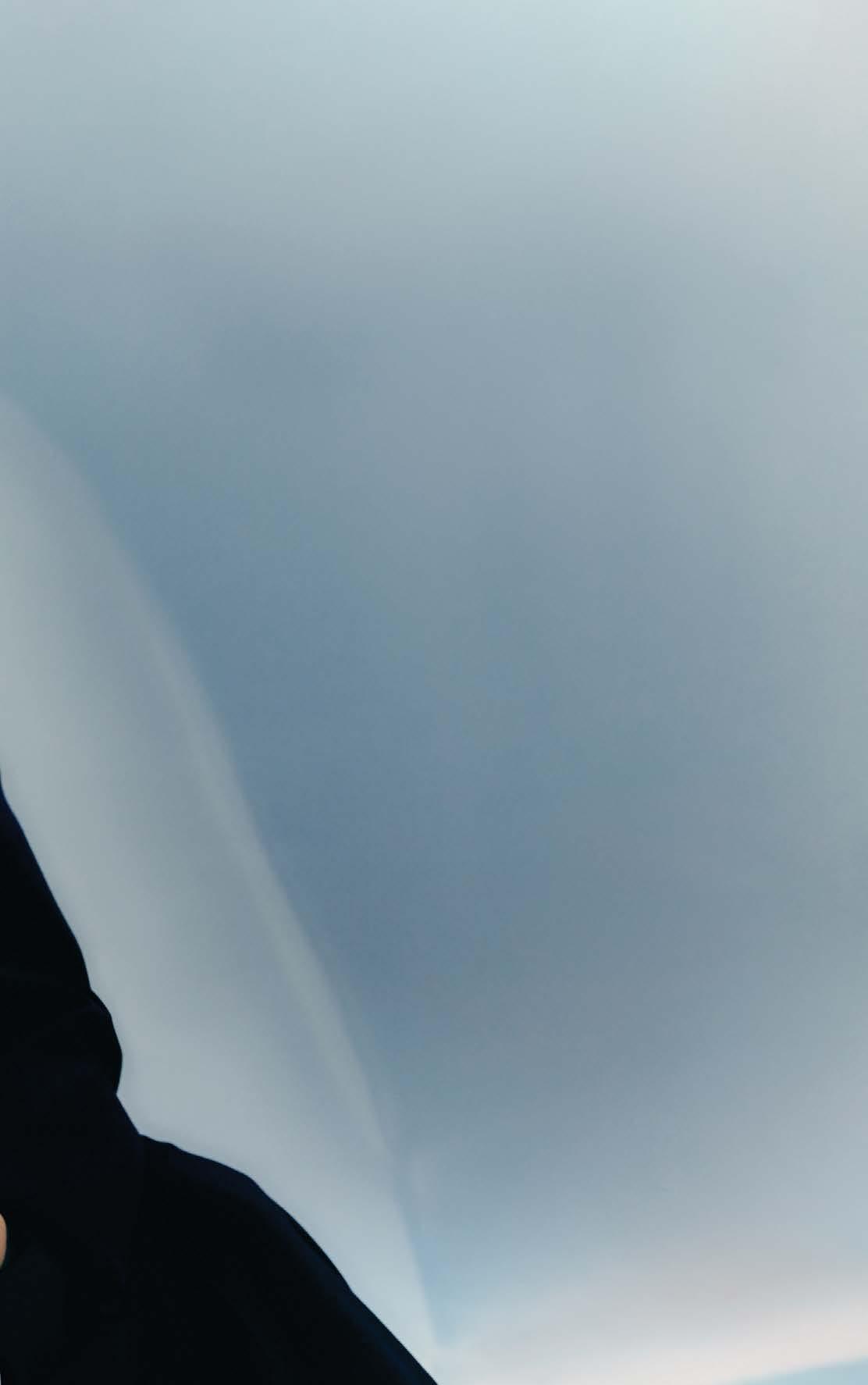
photography AMINA ZAHER styling SAIF HIDAYAH interview DAREEN ABUGHAIDA words MENNA SHANAB
Jacket, top, trousers, Alexander McQueen Jewelry, stylist’s own
Jewelry,

DARIN SALLAM THIS IS YUNG
126-127
Dress, shoes, Gucci
stylist’s own
“I want to talk emotions, because when you hear or read things, you can easily forget them, but when you feel things, they stay forever.”
“I’m an artist. It’s that simple. This is my language. This is how I express myself. I decided that I wanted to be loyal to the events of the Nakba. I want to talk emotions, because when you hear or read things, you can easily forget them, but when you feel things, they stay forever,” says Darin Sallam, writer and director of internationally acclaimed film, Farha. In this, her debut film, Sallam humanises the Nakba with a deft touch of storytelling that penetrates our psyches, narrating the events through the eyes of a 14-year-oldgirl.
As a Jordanian of Palestinian descent, Sallam grew up hearing stories of a Palestine before the Nakba, one brimming with life, music, art, people, traditions and heritage: the lingering beauty that can, at times, supersede memories of dispossession. Patching these stories together, Sallam created the character of Farha, a name that means joy in Arabic.
Born out of transgenerational memories, Farha is a dauntless and carefully-knit story, a visual retelling of the oral histories Palestinians have been told for generations. It is a mental recording of the laughs shared and the faint taste of freedom.
“I chose the name Farha because it represents the things I’ve heard people say about Palestine before 1948: the way they talked about it and missed it, how emotional and joyful they became and how they were waiting to go back. How the eyes of my grandparents and everyone who witnessed and knew Palestine before the Nakba had this glimmer in them.”

DARINE SALLAM THIS IS YUNG DARIN 128-129
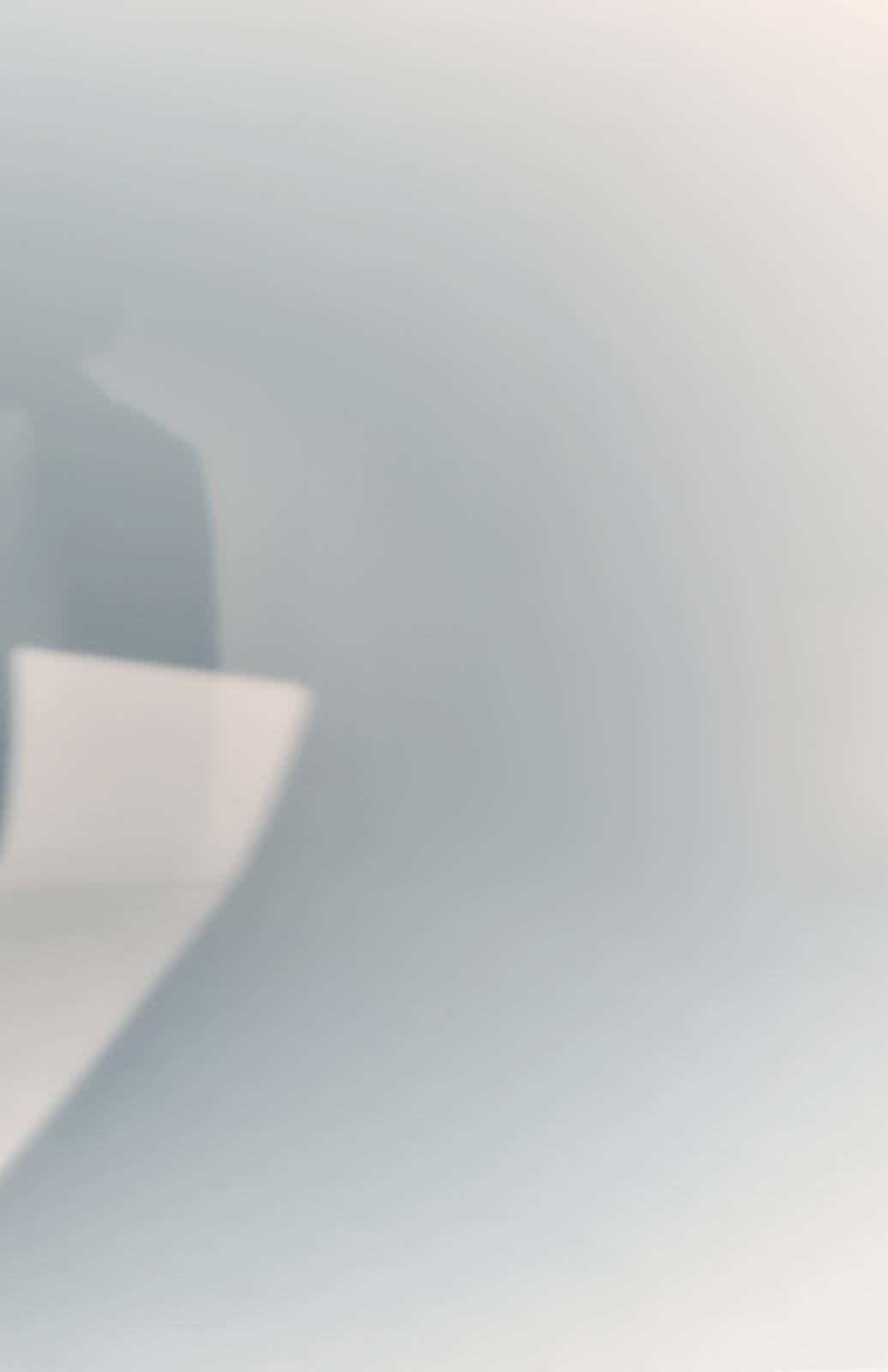 Jacket, dress, heels, necklace, Bottega Veneta
Jacket, dress, heels, necklace, Bottega Veneta

THIS IS YUNG DARIN SALLAM
130-131
Jacket, shirt, trousers, boots, Gucci Jewelry, stylist’s own




THIS IS YUNG DARIN SALLAM 132-133
Top, trousers, belt, heels, Bottega Veneta
As a child Sallam was told the true story of Radieh, a young Palestinian girl who watched the events of 1948 from a locked cellar. Radieh “survived the storm, made it to Syria and shared the story with my mother,” says the Jordanian filmmaker, “my mother in turn shared the story with me.” The story had travelled over years, decades and generations to find Sallam and she felt it was her responsibility to share it, as a microcosm of her elders’ experiences.
In Sallam’s portrayal, the events are depicted from the unique perspective of teenage Farha, watching and waiting; the camera spends more than 50 minutes inside the cellar with her. To capture this seminal moment in Palestinian history from such a restricted - one room perspective - was a daring directorial decision, but one that resonates with the audience, “people felt the character and lived her journey, that was what I wanted to achieve,” says Sallam. “I always wanted to make a universal and timeless story.”
Although the events of 1948 are now covered in a myriad of books, poems and documentaries, the Nakba is seldom shown in the form of fictionalised cinema. Sallam takes the opportunity to give us a glimpse into the splendour of Palestine before the Nakba, incorporating beautiful portrayals of bountiful fig harvests and scenes from a traditional folkloric party - showcasing the beauty of Palestine’s cultural legacy, adding, “I want to show that it was a land with people that had lives, heritage, culture, traditions, sad moments and happy moments.”
Bringing the film to life was a long and arduous journey for Sallam, who began writing it in 2016 and was met with pushback. Nevertheless, the film was shot in Jordan in 2019, and debuted in 2021 to critical acclaim. Following its world premiere at the Toronto International Film Festival last year, the film has risen in popularity thanks, in part, to its release on Netflix which has shared the story with a wider audience. It has been selected.
Farha is not a portrayal of an impersonal historical phenomenon that exists in the world. Instead, it depicts a very personal, real-life experience that adds to the Palestinian collective memory. The Palestinian identity is sustained by the act of remembering and is maintained by the passing down of stories among generations, a tradition Sallam is upholding with Farha. “I wish for the film to live,” she says, “I really hope that the young will continue to remember with a film like this.”
“I’m an artist. It’s that simple. This is my language. This is how I express myself.”

THIS IS YUNG DARIN SALLAM 134-135
 Jacket, top, trousers, Valentino Jewelry, stylist’s own
Jacket, top, trousers, Valentino Jewelry, stylist’s own
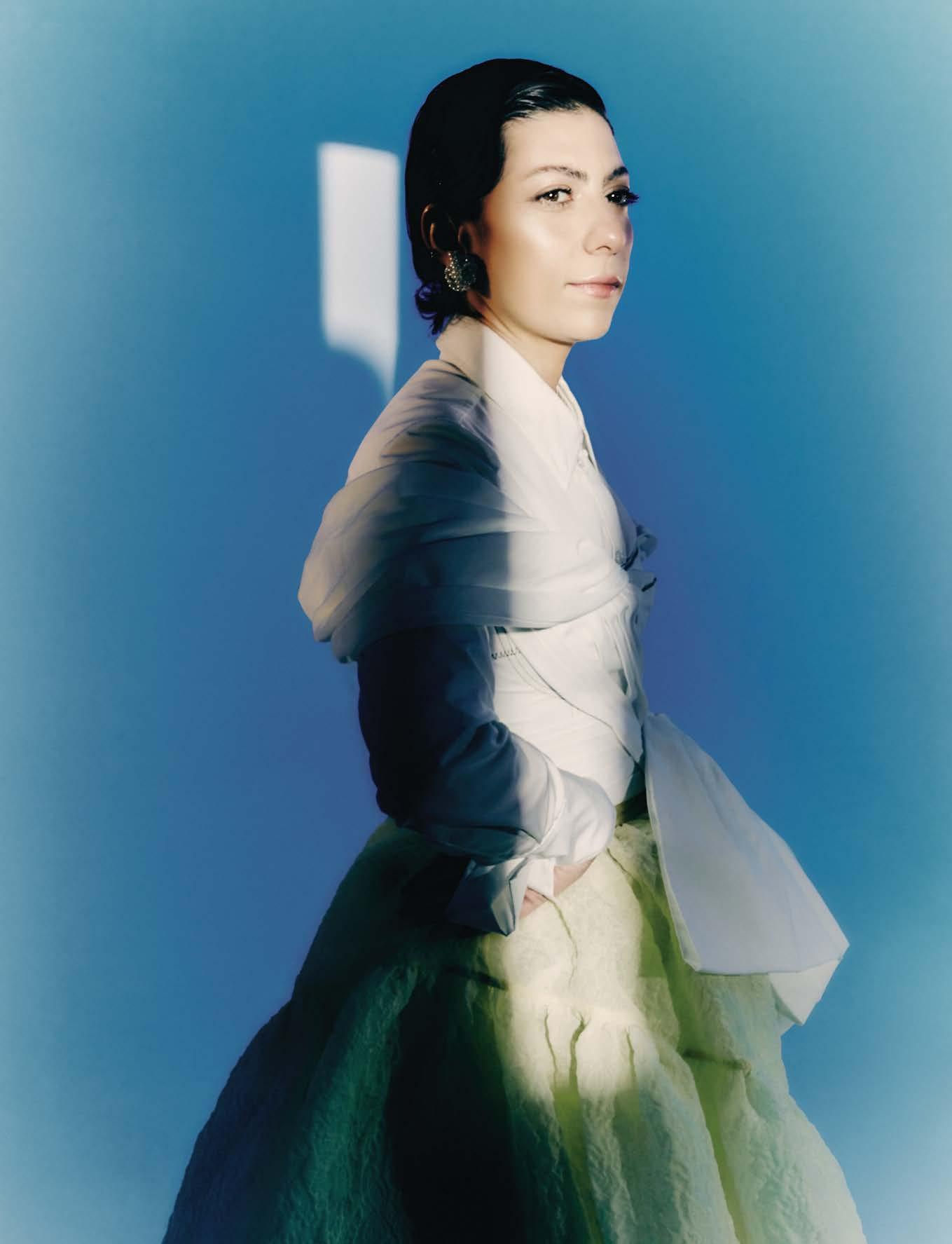
THIS IS YUNG DARIN SALLAM 136-137
Skirt, corset, top, shoes, Erdem Jewelry, stylist’s own



set design SAIF HIDAYAH; styling assistant NUJOUD OWEIS; hair & makeup LAURA MADAR production assistant OMAIA JALLAD THIS IS YUNG DARIN SALLAM 138-139
Top, skirt, brooch, Gucci Jewelry, stylist’s own
“The eyes of my grandparents and everyone who witnessed and knew Palestine before the Nakba had this glimmer in them.”
the in
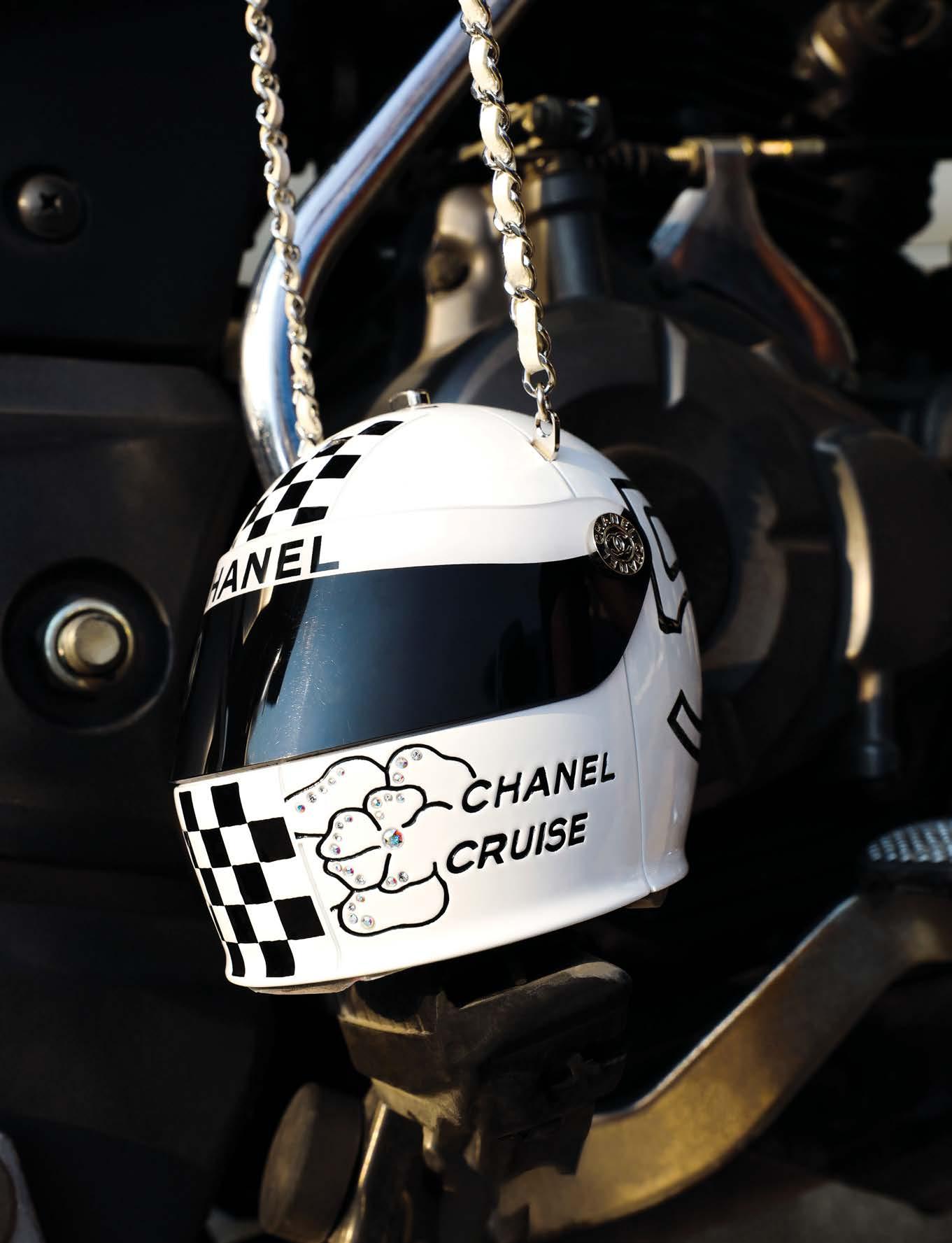
THIS IS YUNG ACCESSORIES
140-141
Bag, Chanel
WILD photography SOPHIA KHALIFEH; styling NUJOUD OWEIS
THIS IS YUNG ACCESSORIES 142-143
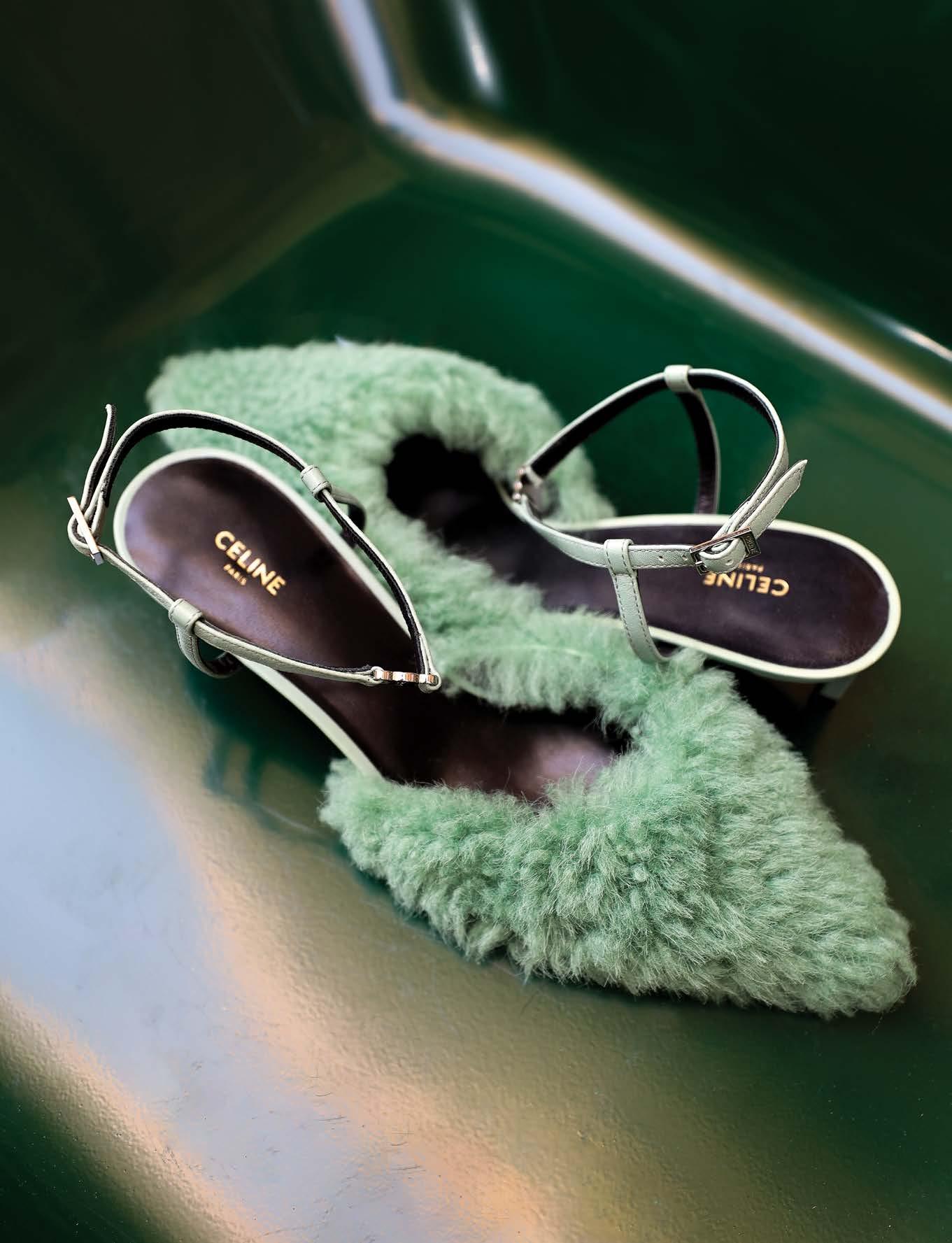 Heels, Celine
Heels, Celine
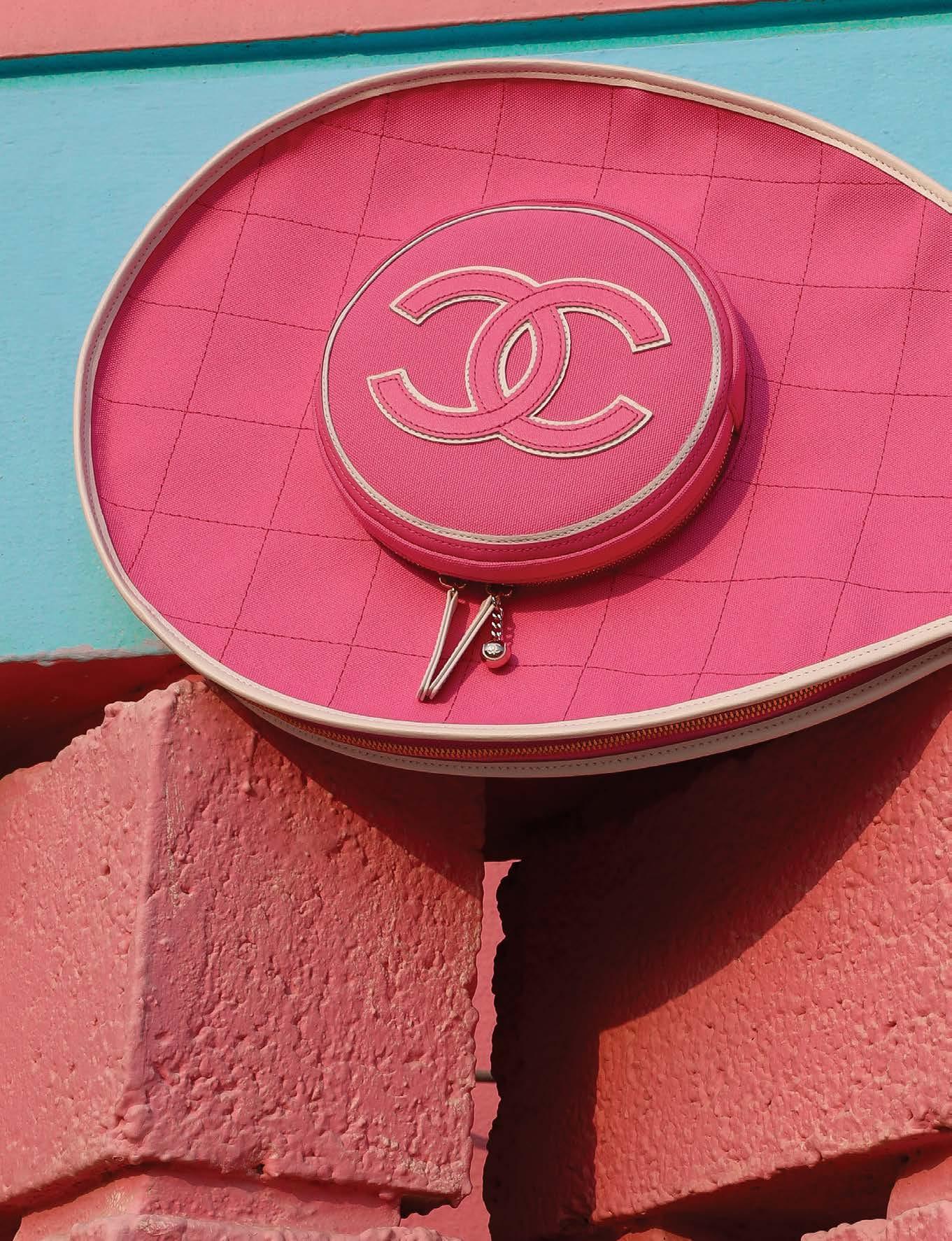
THIS IS YUNG ACCESSORIES 146-147
 Bag, Chanel
Bag, Chanel

THIS IS YUNG ACCESSORIES 146-147
Bag, Loewe

THIS IS YUNG ACCESSORIES
148-149
Bag, Alexander McQueen
 Shoes, Marison Margiela
Shoes, Marison Margiela

THIS IS YUNG ACCESSORIES 150-151
Shoes, Celine

THIS IS YUNG BEAUTY
152-153
Top, Etro at Airport Tray . Jewelry, stylist’s own
ELECTRIC

SHADE
photography ZAID ALLOZI; styling NUJOUD OWEIS
The power of makeup through the eyes of Jordanian makeup artist Laura Madar.
 Top, Trashy Clothing
Top, Trashy Clothing
THIS IS YUNG BEAUTY 154-155
Jewelry, sunglasses stylist’s own
“I don’t believe in beauty standards, beauty is something personal and cannot be measured.
Every person has their own definition of beauty, and everything is beautiful in its own way.”

THIS IS YUNG BEAUTY 156-157
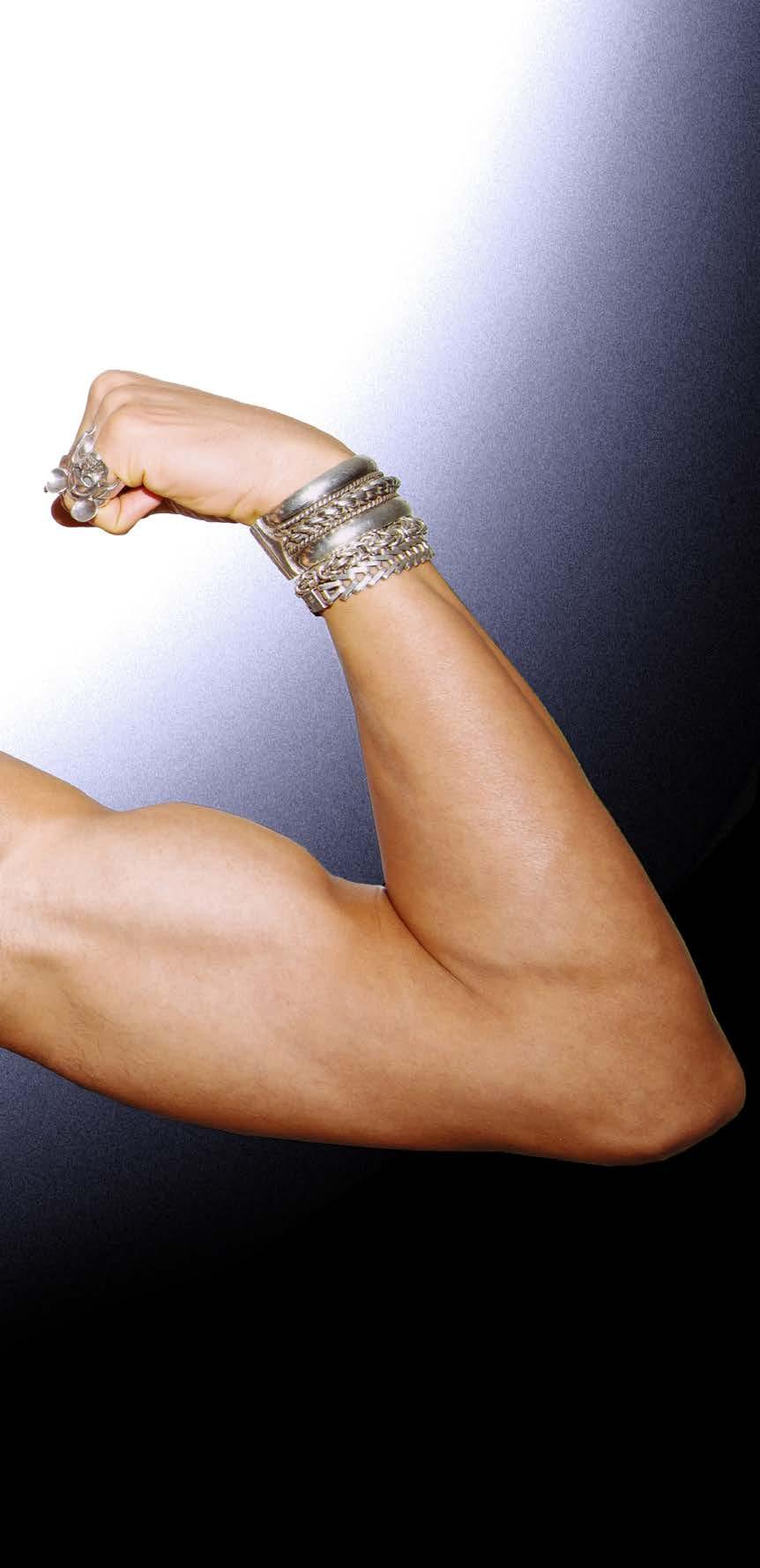 Top, Trashy Clothing
Jewelry, sunglasses stylist’s own
Top, Trashy Clothing
Jewelry, sunglasses stylist’s own
“Makeup is very therapeutic for me. While I work my mind goes blank as I get lost between the colours, products and the process of creating something and bringing my ideas to life.”
THIS IS YUNG BEAUTY
158-159
 Jacket, Etro at Airport Tray.
Jewelry, stylist’s own
Jacket, Etro at Airport Tray.
Jewelry, stylist’s own

THIS IS YUNG BEAUTY
160-161
Jewelry, Stone Fine Jewelry

162-163
Top, Nafsika Skourti Gloves, Minxy Jewelry, stylist’s own
“Makeup is literally my world. Makeup to me is not only something you wear to be ‘beautiful.’ Makeup is art – it’s the way I express myself. Applying makeup helped me through so many things. It calmed me down and I was able to put my feelings into my art.”

THIS IS YUNG BEAUTY 164-165
Top, Trashy Clothing . Gloves Minxy . Jewelry, stylist’s own

models ALIYA
hair & makeup
BOSHNAK,
SOLÉNNE TADROS, MINNATULLA ATEA, SAEED OMAR, ABDULLAH ABULKHAIR;
LAURA
MADAR;
production
OMAIA JALLAD, NUJOUD OWEIS.
FREE DOM OF EX PRESS ION

THIS IS YUNG SENTIRE STUDIO
photography LEANDRO ABALLE styling SERGI PADIAL words YUNG TEAM
166-167
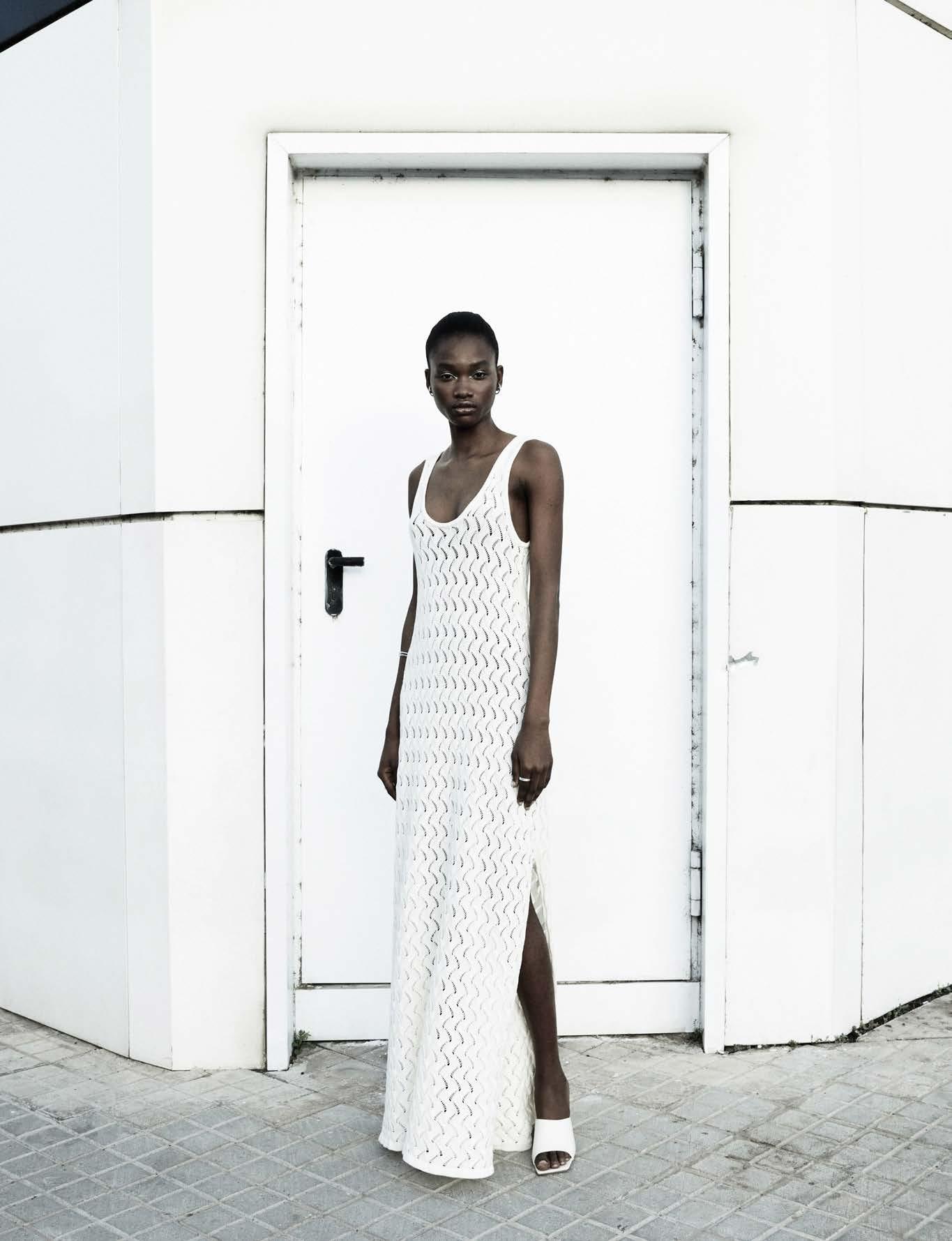

SENTIRE STUDIO THIS IS YUNG 168-169
Unconforming and fuelled by forward thinking artform, Sentire Studio
by Syrian-born Saleh Kelarge, is disrupting fashion through contemporary, innovative and mindful design.
What does Sentire Studio mean?
SENTIR /SEN̦.’TIR/ (VERB): Spanish for “TO FEEL” and “TO EXPRESS”.
Describe Sentire Studio in three words. Elegant, sophisticated, innovative.
Beyond design and Sentire Studio, who is Saleh?
I am a Syrian-born, European-based creative. Growing up in Syria, I was exposed to a rich culture and history that has influenced my values and ways of thinking, yet more than a decade as an Arab living in Europe means I can bring together the best of both cultures. The war in Syria has left me without a true home base, and I’ve struggled with feeling lost and disconnected from my Syrian roots - while also not fully resonating with European culture. I’ve often felt like there is no representation for me in either place. While it can be a challenge to navigate the complexities of cultural identity, it is through these struggles and experiences that we can truly grow and find our path in life.

SENTIRE STUDIO
THIS IS YUNG 170-171
You have a tech background, how does this give you a different perspective on the fashion industry?
One of the key benefits of a startup background is the ability to be agile and adapt to change quickly. My experience has taught me the importance of being flexible and open to trying new things which, in the fast-paced fashion industry, is crucial. Startups also often have limited resources, which can foster a culture of creativity and resourcefulness: my background has given me the skills and mindset to think outside the box and find creative solutions to challenges.
As a sustainable designer, what would you say are the most important things to consider in slow fashion?
It’s crucial to prioritise the use of environmentally-friendly materials and to design for durability, in order to reduce the environmental impact of our clothing. Also important are: transparency to build trust with consumers; producing clothing ethically and under fair-labour conditions; using local factories to help reduce carbon footprint; and offsetting carbon emissions through carbon credits or other methods. We encourage customers to repair and reuse their clothing and produce limited runs of our garments to reduce waste. I’m passionate about educating our customers: by providing information and resources about sustainability and ethical fashion, we can empower people to make informed decisions.
What’s the biggest misconception about sustainable fashion? One of the biggest is that it is not stylish; many people believe that sustainable fashion is limited to basic, utilitarian pieces. However, there are many sustainable brands and designers creating trendy clothing using sustainable materials and production methods. Another misconception is that an individual’s fashion choices cannot make a meaningful impact but, because the fashion industry is a significant voice and contributor to environmental and social issues, the choices we make as consumers can have a powerful impact.
Many brands are shifting towards ethical fashion, what makes you stand out?
We believe in pushing the norms and not using sustainability as our only unique selling point, but rather as a necessary core value - we strive to make a positive social and environmental impact with every decision we make. As a young brand, we are committed to creating things correctly from the beginning, rather than making changes later on. Change takes time and it may take years for bigger fashion houses to transform fully.
Walk us through your design process:
I focus on craftsmanship from start to finish: this begins by researching trends and gathering inspiration, before considering every design detail. After I have developead a number of concepts, I refine and finalise my designs.This might involve making changes to the fit or silhouette and adding details and finishing touches.
Dead or alive, who is an icon you would dream of dressing?
Kadim Al Saher: his music and art have brought joy and inspiration to people across the Middle East for decades, he represents the sophisticated and cultural roots of the region. It would also be a dream to dress Bella Hadid and Zendaya, two strong and confident women who are known for their bold fashion choices and ability to push boundaries. Both represent a new generation of Arab and African American women who are breaking barriers and challenging traditional expectations.
“I’ve learned that success is not always linear, and that it is through failures and setbacks that we often grow the most.”

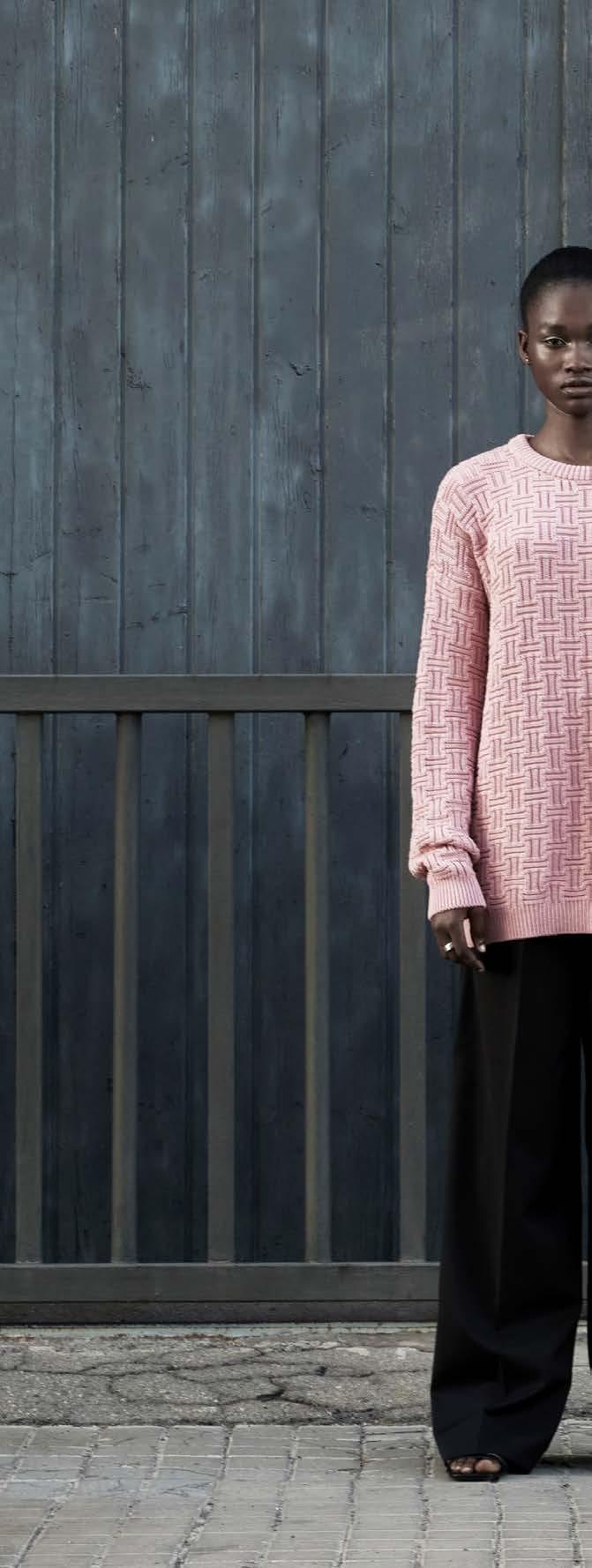
SENTIRE STUDIO THIS IS YUNG 172-173


SENTIRE STUDIO THIS IS YUNG 174-175
What’s next for you?
Currently, I’m focused on setting up international distribution for my brand, building out our omni-channels and preparing to exhibit at the Tranoï show in Paris. As I continue to grow and develop as a designer, I’m always seeking inspiration from different cultures and experiences and looking for new ways to challenge myself and push my creative boundaries.
How do you push boundaries within your design?
I believe that fashion has the power to transform the mundane into the extraordinary, and I am always seeking new ways to challenge the status quo. I’m deeply inspired by the idea of defining future aesthetics and creating products that are innovative and forward-thinking, so I am always looking for ways to push the boundaries of traditional design. One of my greatest passions is reinventing things that people might consider ordinary and making them look outstanding.
How do you go about finding artisans to collaborate with?
Through networking events, online platforms, and reaching out to artisans I admire. It’s important for me to work with artisans who share a similar style and passion for fashion as this helps ensure a successful - and mutually beneficial - collaboration. Building relationships with artisans allows me to incorporate unique elements into my designs and helps me to tell the stories behind my collections.
Your brand mission statement includes “ignite the freedom of expression”how do you capture this?
By celebrating individuality and challenging societal norms. For those who have struggled to fit in, or feel marginalised by society, fashion can be a powerful means of self-expression and a way to reclaim their own identity.
Who or what inspires you?
I can’t choose one person: I’m constantly inspired by everyone I meet and I like my design to invoke a feeling of connection and identification. I’m also inspired by the vision of a future where technology and innovation have transformed the way we live and interact with our surroundings. I imagine a world where daily tasks are streamlined through the use of advanced technologies, and where minimalistic design principles are valued for their ability to create a sense of calm and clarity.
What does success mean to you? And what have you learnt from your failures? Success, for me, is about finding fulfilment and happiness in the work that I do and making a positive impact on the world. I’ve learned that success is not always linear, and that it is through failures and setbacks that we often grow the most. Success is a journey, and it is up to each of us to create our own definition of it. It is not defined by external validation or material possessions, but by how we use our skills and talents to make a positive difference in the world.
“I believe that fashion has the power to transform the mundane into the extraordinary, and I am always seeking out new ways to challenge the status quo and push the boundaries of traditional design.”
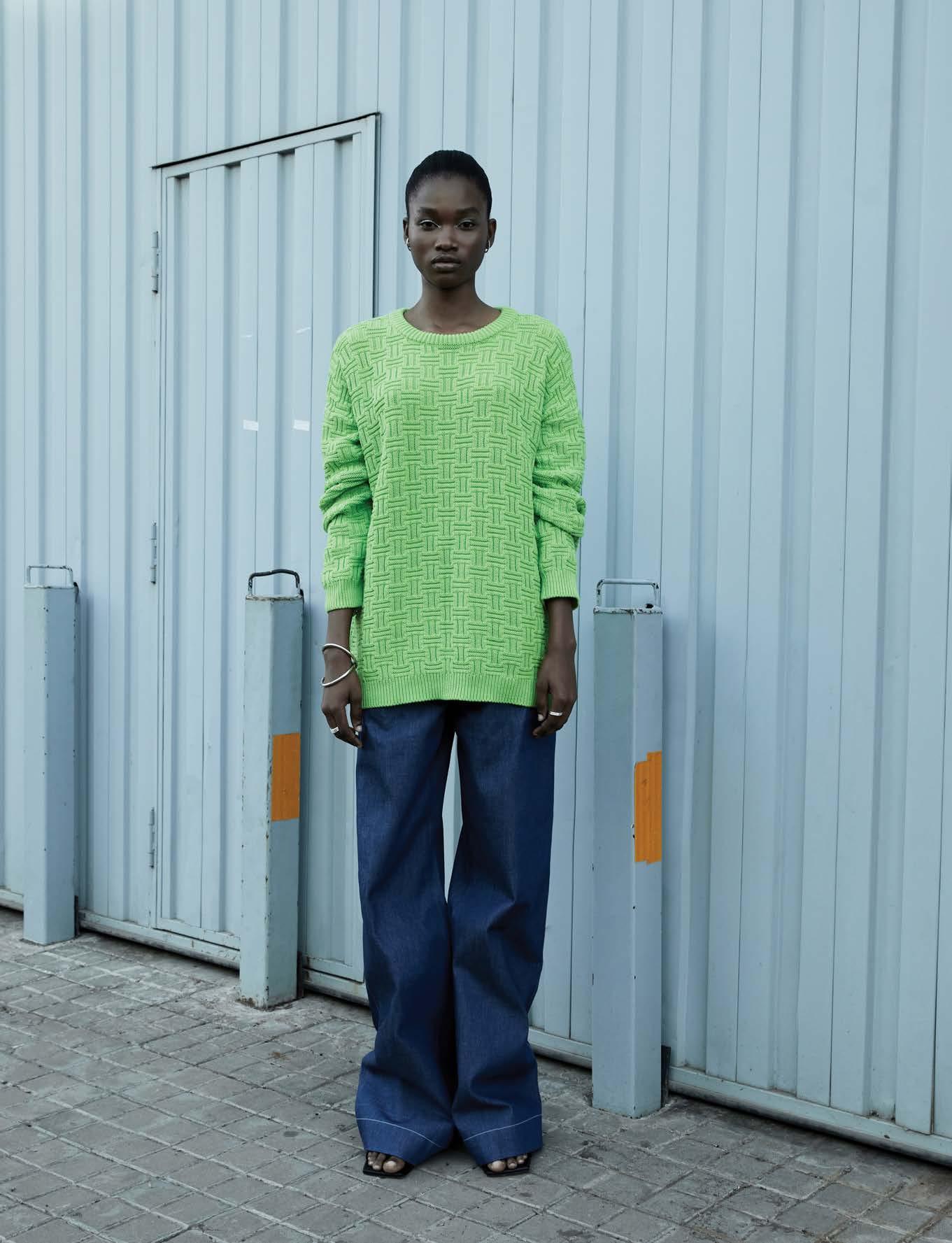
hair & makeup MABEL BOON; models NICOLAS SANÉ, DEBORAH OLUGBEMIGA agency FIFTH MODELS; photography assistant ARNAU SOLÉ THIS IS YUNG 176-177

DOU BLE
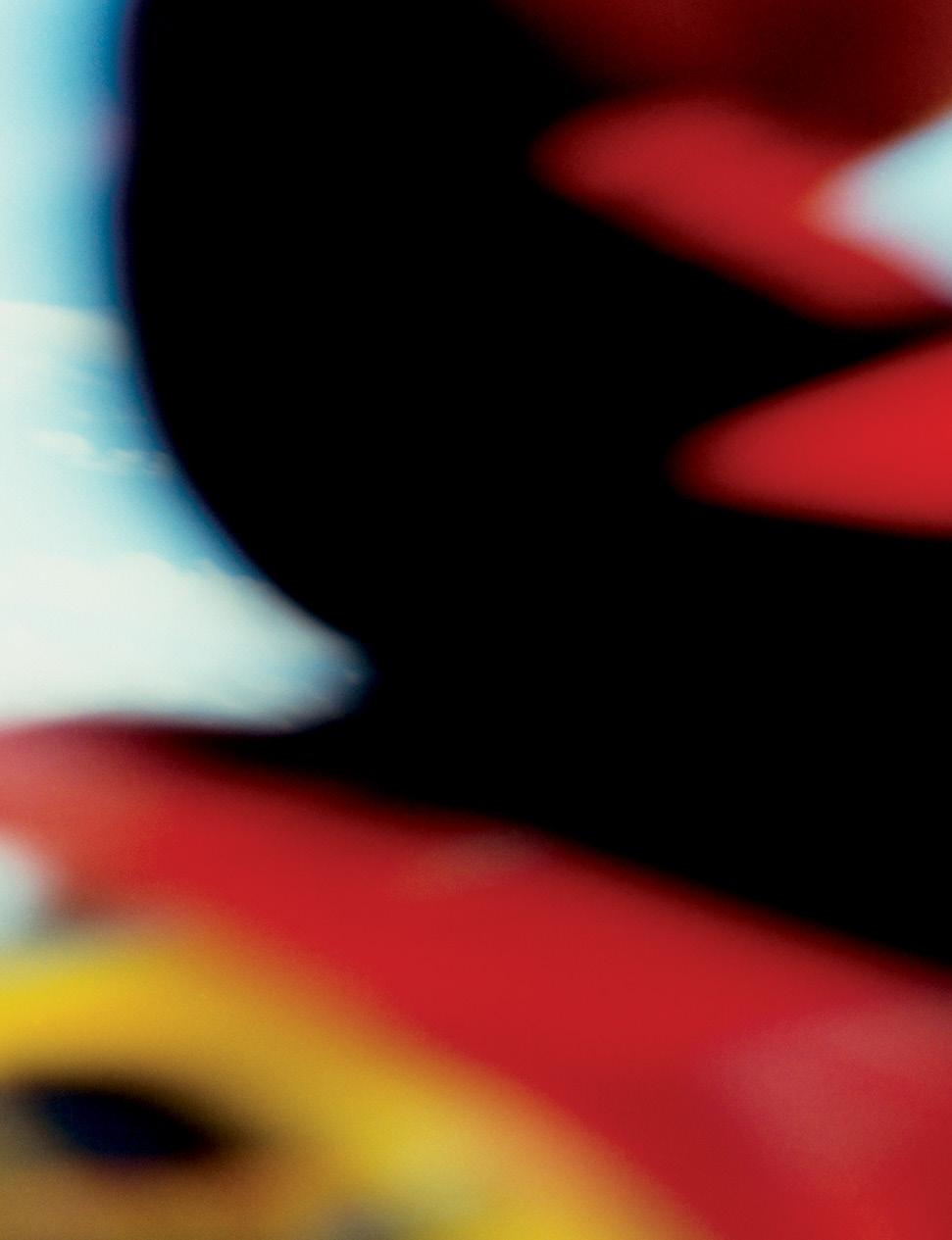
THIS IS YUNG PROFILE
photography ILYES GRIYEB
words MENNA SHANAB
178-179
CON SCI OUS NESS



THIS IS YUNG PROFILE
180-181
“My goal is to bring a more accurate, deeper and human sense of understanding to topics that were approached by a white gaze.”


THIS IS YUNG PROFILE 182-183
Weaving between half-staged portraits, candid interiors and expansive landscape shots, the extensive works of French-Moroccan photographer Ilyes Griyeb are both a documentary tool and art form, underpinned by a penetrative perspective on decolonisation. Traversing the realms of documentary, portraiture, fashion and fine art, Griyeb’s photography aims to regain control over narratives that have been left abandoned to foreign lenses.
His work is not only about creating striking portraits, but also spotlighting cultures and voices that have been exploited by the white gaze. “It’s a very simple thing that I want to correct because, of course, I am not like a white person at all, but I have this bridge between two points of views.” W.E.B. Du Bois called this ‘double consciousness’, a dual understanding evoking the internal conflict and dual-identity, specific to minorities. It is this impression of always observing oneself through the eyes of the other, often tinted with pity.
Through his photographs, Griyeb attempts to rewrite western narratives that have created an aestheticization or victimisation of the subjects. “My goal is to bring a more accurate, deeper and human sense of understanding to topics that were approached by a white gaze or by a white person that hasn’t had deeper investment in understanding the narrative.”
Griyeb lets the story tell itself, only offering a frame and allowing the scene to unravel naturally before him as he snaps the perfect shot. “When you shoot a documentary, you can write it beforehand - prepare it, build it, conceive it and direct it. But me, I think, I’m more of a spontaneous person. I create a frame that I want to evolve but I always adapt to reality because I think the story builds itself in reality. It’s more like you follow the story’s energy, then you prepare the story.”
As a second-generation immigrant, the Paris-based photographer wanted to tell the story of Morocco as he saw it; as the son of a Moroccan farm worker, revisiting his roots, paying homage to his family. Born in France to Moroccan parents who immigrated in the 80s, Griyeb has spent his life split between these two countries but never lost touch with his roots.
His first voyage into photography started in 2013, when he moved to Morocco to capture his parents’ rural hometown, Meknes. From there, he would spend the next six years photographing his family and friends in their hometown. He captured the everyday rural workers, presenting their lives not rooted in hardship but craftsmanship, without misery or exoticism. Just truth.
He stitched these unheard stories together to create his debut photography book ‘Morocco’, a deep exploration of his family’s roots translated through documentary and street photography. “Photography allowed me to connect very strongly with my Moroccan roots.

It is actually what helped me get back in touch with a big part of my family that lives in Morocco because I got to sit with them and shoot them in their everyday lives. My first book ‘Morocco’ was a kind of identity quest without me knowing it at the time, wildly. It was a way for me to stay connected to my roots.”
The question of identity punctuates all of Griyeb’s work. He is part of the first generation of Moroccan immigrant children to have access to the artistic world. However, his approach is not based on demand. Instead, it yearns to fill a void, painting a portrait of the Moroccan working classes without contempt, class differentiation or pity.
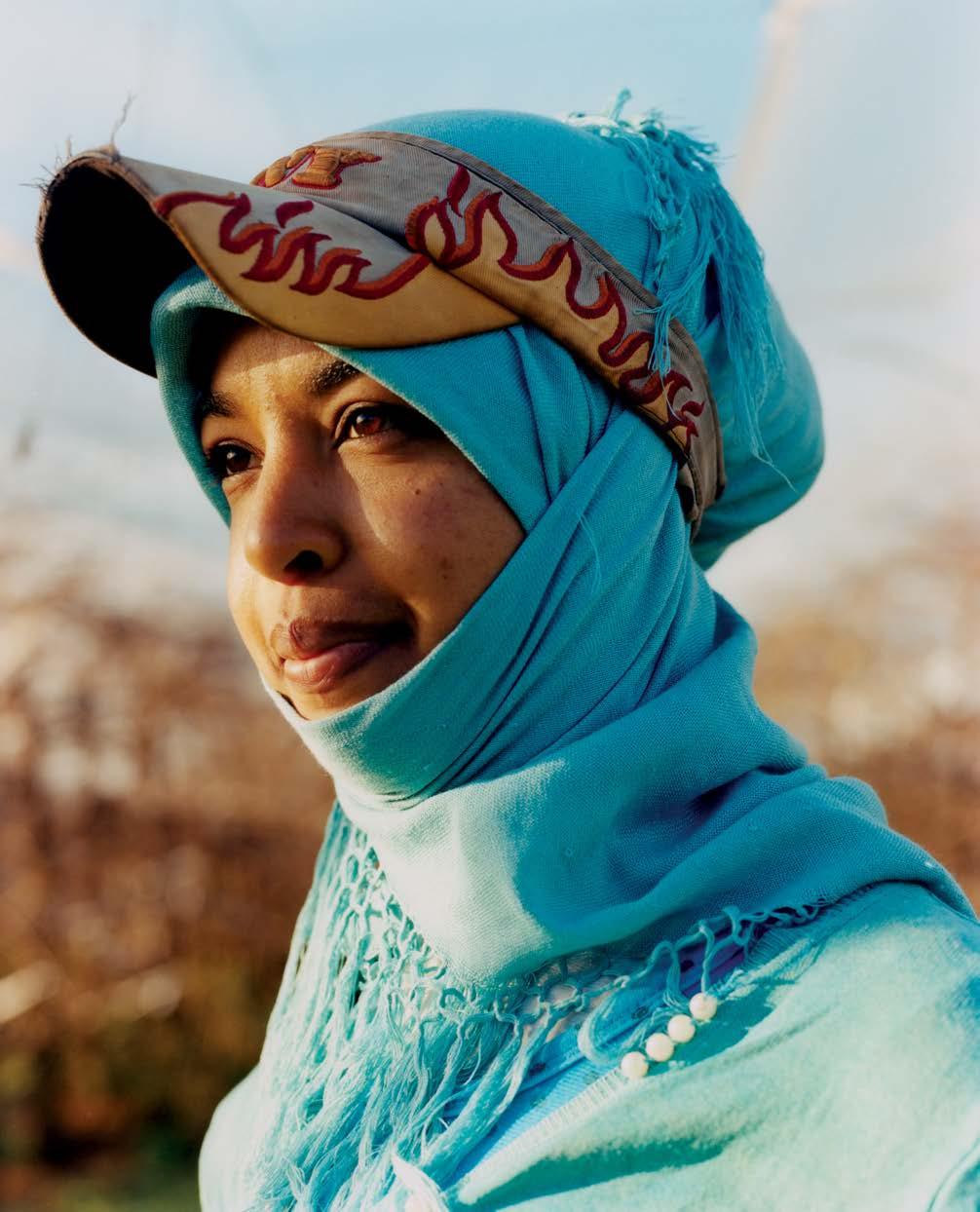
THIS IS YUNG PROFILE
184-185
“My first book ‘Morocco’ was a kind of identity quest without me knowing it at the time. It was a way for me to stay connected to my roots.”
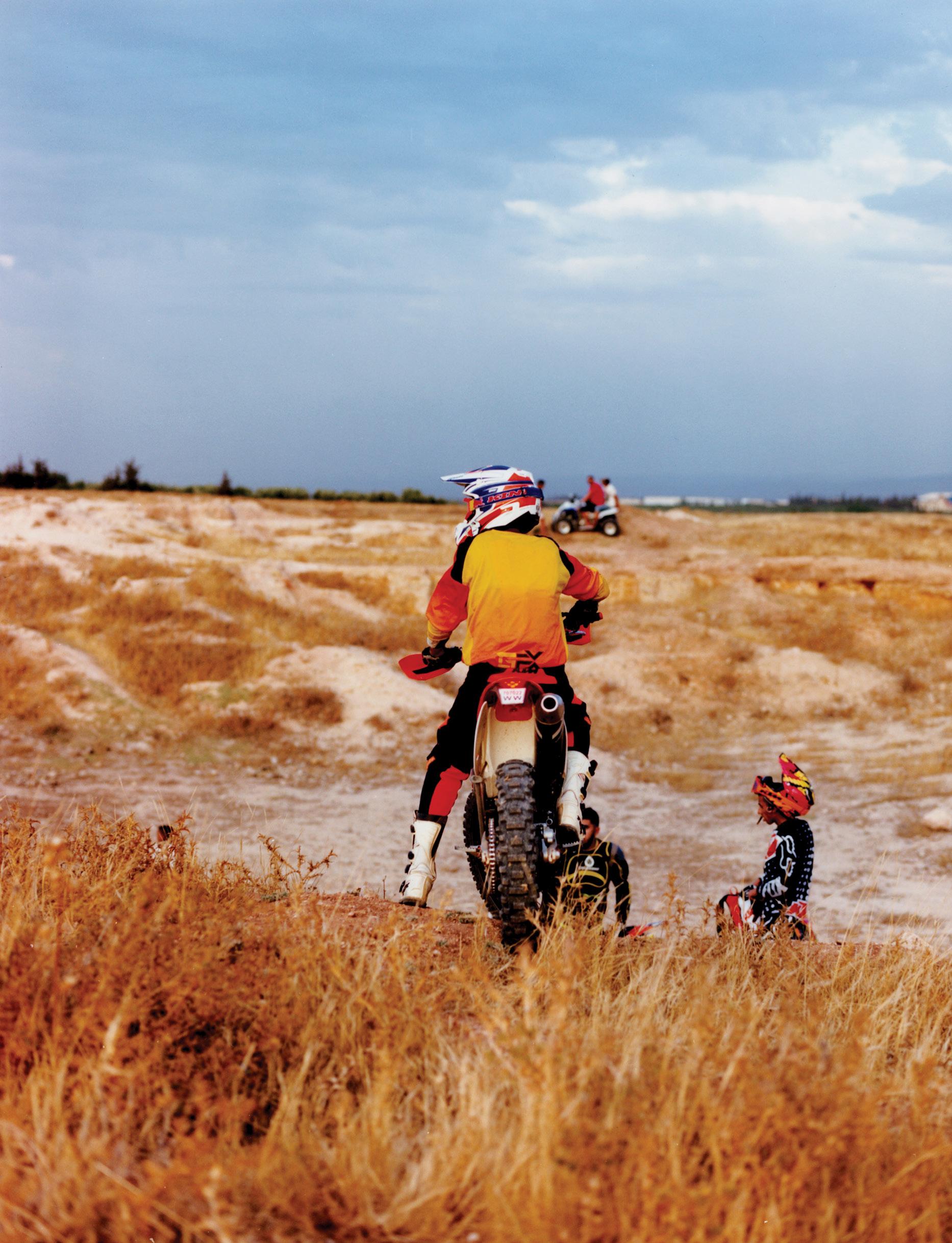
Outside of Morocco, too, he has photographed hundreds of faces in his travels across Africa, India and Europe: documenting many untold stories and a way of life that is slowly disappearing. His focus on agricultural life is rooted in his personal story and seeks a deeper universal truth that ties all of humanity together. “I really wanted to expand my personal story and find common things that human beings all over the world share,” says Griyeb. “We share the same issues. We are, for me, all descendants of farmers, if you go back like three or four or five generations. I think it’s our common path. Even though you can see that this traditional lifestyle in the poor countries is kind of disappearing - because they want to be more modern and integrate into the capitalist system - we can also see that we are going backwards, in the rich countries. But it’s not the same: the values, the cultural part of the agricultural lifestyle are quite rich.”
Griyeb’s work - a mix of portraiture and landscape - tells this story with a certain charm, sincerity and stillness that draws you in and makes you pause. His ultimate aim is to tell the truth - raw, unfiltered, and exactly as it is.

THIS IS YUNG PROFILE
186-187
“I really wanted to expand my personal story and find common things that human beings all over the world share. We share the same issues. We are, for me, all descendants of farmers, if you go back like three or four or five generations. I think it’s our common path.”


THIS IS YUNG PROFILE 188-189


ABIOLA OBISESAN THIS IS YUNG 190-191
FACETS OF
JOY
words KATIE SILCOX

THIS IS YUNG ABIOLA OBISESAN 192-193

ABIOLA OBISESAN THIS IS YUNG
194-195
“My mom and my grandmother used to do a lot of fabric-buying and sewing. I think I picked up the concept of colours and patterns from them.”
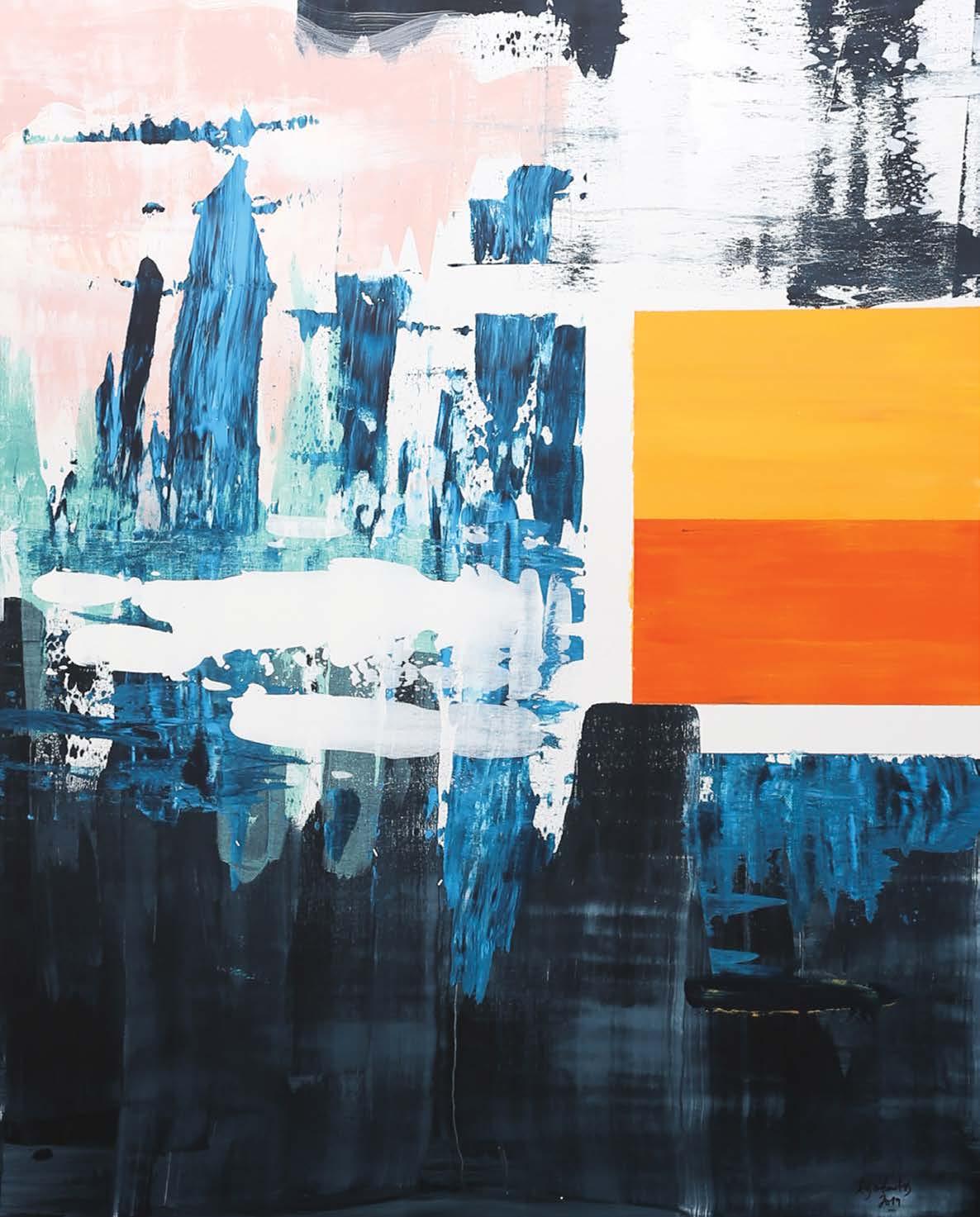
www.ayotimoty.com/art
Tell us about your background: I was born in Nigeria, I grew up in Oyo State and moved to London when I was 18.
Where do you think your creative streak comes from? My dad had an inbuilt sense of style, and my mom and my grandmother used to do a lot of fabric-buying and sewing. I think I picked up the concept of colours and patterns from them, but also from art classes in high school which I used to love - along with my Yoruba lessons. I felt a strong connection with the Yoruba language lessons at school because my parents were from the Yoruba tribe. It was easy for me to understand and feel every component of it.
You’ve given some of your artwork Yoruba names. Tell us about this: I did it because it will make people think about where the artwork comes from, and also because, for me, it’s a connection back to my childhood. There’s a painting named ÓDÒLEWU, this is where I went to high school. I named a series of work AWO GÓÒLÙ, which means ‘gold skin’ in Yoruba - I chose the name because of the gold accents in these paintings. ILÉSÁ is the place my grandmother is from and I named one painting that because of the feeling this particular painting portrays; it’s a play of innocent, child-like colours.
You work with a lot of bright colours. Why? When I started, I actually worked with darker colours. I was trying to do some portraits. But then one day I thought that maybe if I added some colours it might make people feel happy when they look at it. This is when I found my style. Both the clothes people wear and nature are bright in Nigeria and give a sense of joy. I’ll never forget the day I came across a chameleon in the forest near my school, and watched as it changed colours. It was fascinating.
Is there a message you’re trying to convey through your art? I paint with feeling. It’s what makes me feel good, and I hope that it translates to make other people feel good too. I like to think that the colours I use reflect the way I felt growing up in Nigeria: there’s a party for everything there, each with people dancing and enjoying themselves while wearing vibrant clothes. People in Nigeria have a sense of joy within them, and that is the feeling I want to create with my art.
How do you know when a piece is finished? If I come back the next day and the colours still make me feel good, it’s finished. If they don’t then I paint over it with new layers of colour, or sometimes even with white and then start all over again.
Who is your art inspired by? There are a lot of painters or artists who inspire me, ranging from people like Jean-Michel Basquiat all the way back to people like Henri Matisse. Music also inspires me a lot, particularly the music scene in Nigeria because of how far it’s come. I like listening to Nigerian artists such as Wizkid, Davido and Asake. Then there’s fashion, clothing, nature. Inspiration really is everywhere. Sometimes my paintings might be different because I see something I like, and I try to incorporate it into them.
Do you listen to music as you paint? If so, who or what? Sometimes I do, sometimes I don’t. If I am, I will be listening to music without words - maybe jazz or instrumental - so that I can completely focus on what I’m doing. I think music is a frequency and that it plays a role in how you’re creating. But when I start painting, I already have in mind what I want to do, the music is just an enhancer.
Why is art important? Art is a form of expression. It’s creativity, and we live in the creativity of other people. Take architecture, for example: offices, libraries, or football stadiums - it’s all science mixed with art and creativity. Art plays a huge part in enhancing human existence, be it the fashion you wear, the car you drive, the phone or laptop you use, or the way you style your home.
You mention the intersection of art and science. As a painter, what do you think of AI and NFTs? I don’t think there’s any one way to define art. If someone thinks AI and the product that algorithms produce is art, then it is art. The only thing I would question is feeling: if I pick up a Picasso, I know that this was made by a person who existed and who painted this piece with his hands. There is an exchange of feelings that is difficult to achieve through a computer. I’m not saying it’s a bad thing, it’s just different. As for NFTs, they have a monetisation benefit. A source of income to artists. And why shouldn’t artists have a good life, as other professionals do?
THIS IS YUNG ABIOLA OBISESAN
196-197
“I felt a strong connection with the Yoruba language lessons at school because my parents were from the Yoruba tribe. It was easy for me to understand and feel every component of it.”

THERE’S A TIME AND A PLACE FOR REGULAR, AND QUOZ ARTS FESTIVAL IS NOT IT. HERE, IT’S MATTER OVER MIND AS YOU JOURNEY THROUGH THE SPACE-TIME PARADIGM INTO A DUAL DIMENSION. EXPECT THE UNEXPECTED AND BE READY TO QUESTION EVERYTHING YOU THINK YOU KNOW.
SURRENDER TO NATURE, UNLEASH YOUR INNER CHILD, OR EXPLORE YOUR CYBORG-ENHANCED POTENTIAL AT ALSERKAL AVENUE’S ALTERNATE UNIVERSES. THE FUTURE IS YOURS TO CREATE. MAKE IT COUNT.
SHIFT ING SPAC ES
SHIFTING SPACES
THIS IS YUNG photography QVAL FILM; styling
198-199
SARAH RUXTON

(UN)REAL (UN)CERTAIN (IM)MATERIAL

200-201 SHIFTING SPACES THIS IS YUNG
Jacket, Jitrois at Les Spot. Trousers, sunglasses at Les Spot. Shirt, Anomalous. Earring, 28J
BIONIC BLING


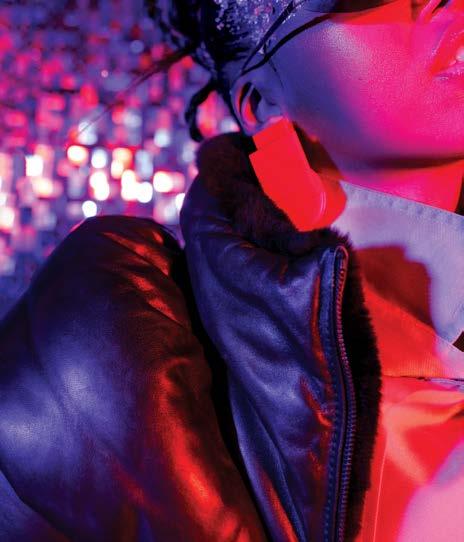

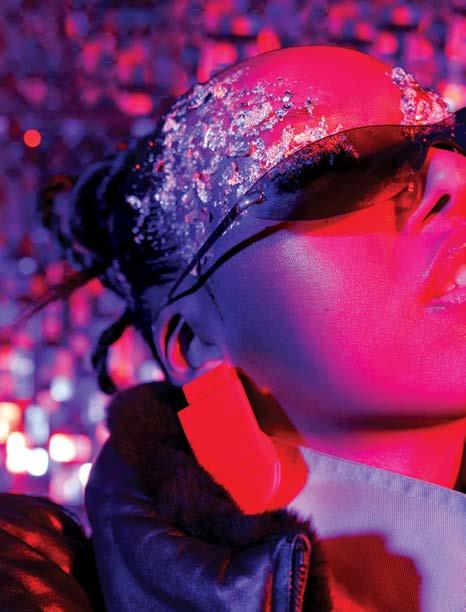

PROM
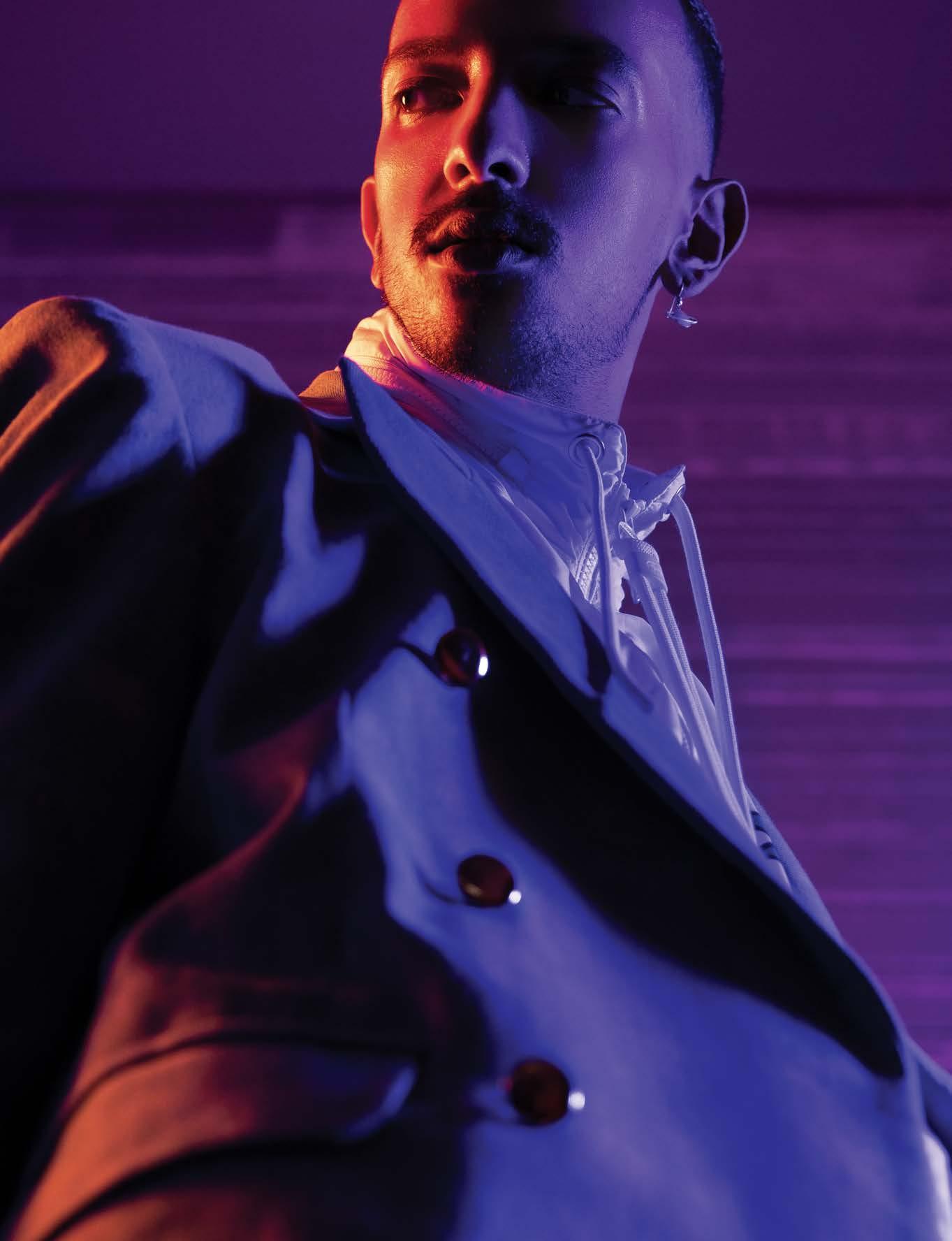
SHIFTING SPACES
THIS IS YUNG
202-203
Blazer, Anomalous. Jacket, Lacoste. Jeans, Born in Exile. Boots, model’s own
KING
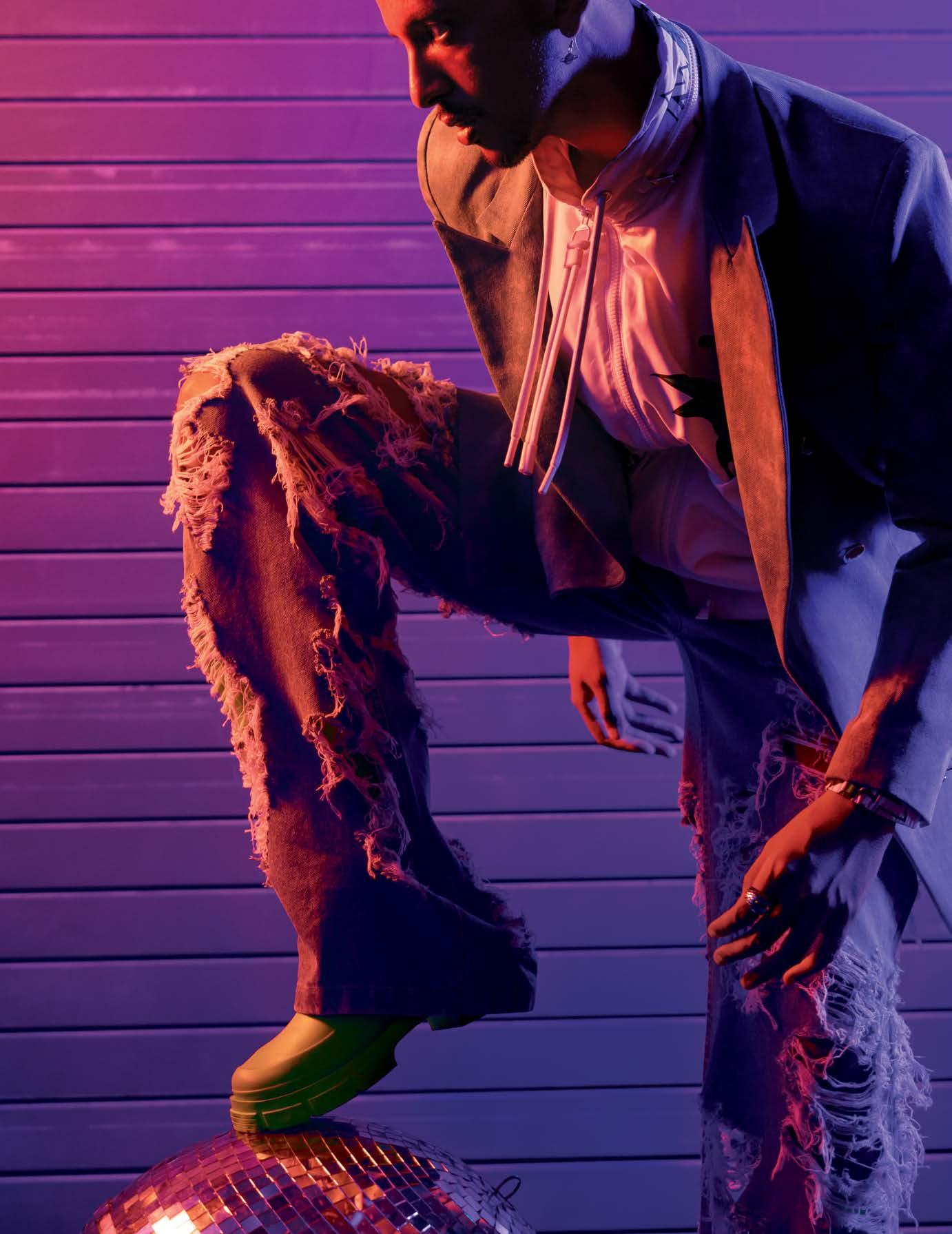
JUNGLE BEATS
204-205
THIS IS YUNG SHIFTING SPACES

in Exile director/producer PASCAL KASHOUH; d.o.p ANDREY KOVALEV; executive producer LINA MERHY; set designer EVGENIA SILVINA; hair & makeup JEAN KAIROUZ; models BARAN, KORRI, DEE
Jumpsuit, Born
DESERT
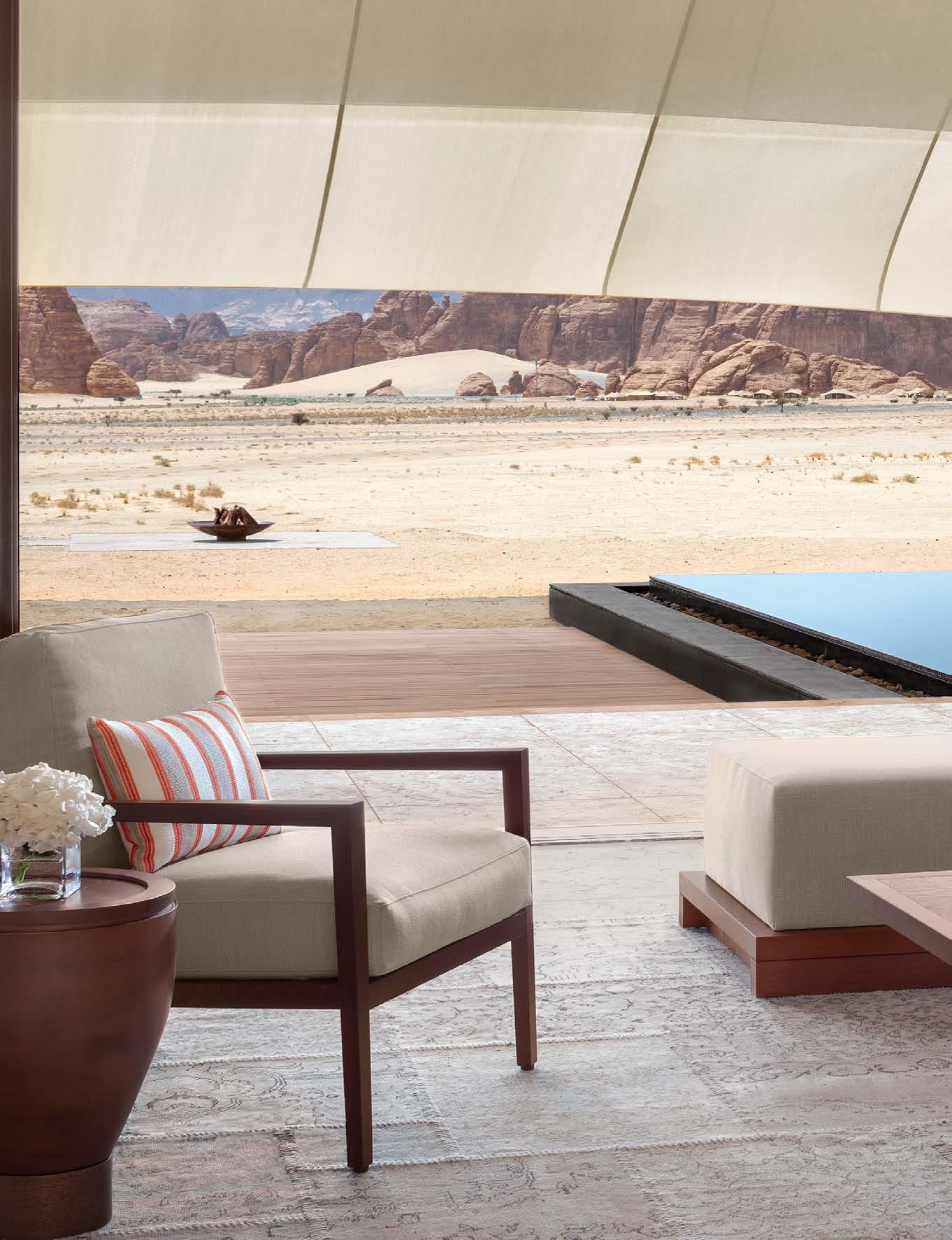
DESERT DREAMSCAPE 206-207 THIS IS YUNG
DREAMSCAPE

With 200,000 years of history, AlUla is the world’s largest living museum. Taking advantage of this prestige location, Banyan Tree AlUla has been designed to preserve and prioritise the area’s natural beauty and heritage, drawing inspiration from its nomadic, Nabataean culture. Set in the magical and mysterious Ashar Valley, this resort is a multi-sensory experience where colourful landscapes and tranquil energies permeate the desertscape, taking guests on an interactive journey.

DESERT DREAMSCAPE 208-209 THIS IS YUNG
The area’s storied past sets the scene and the hotel’s ‘in-villa, in-valley and en-voyage’ concept sets the agenda. For guests, this means not only a welcoming place to stay within the luxury tented villas, but a world of exploration across the resort’s valleys, and immersion into local-life on curated voyages, too. Here, culture and luxury are weaved seamlessly together to create an unforgettable stay.
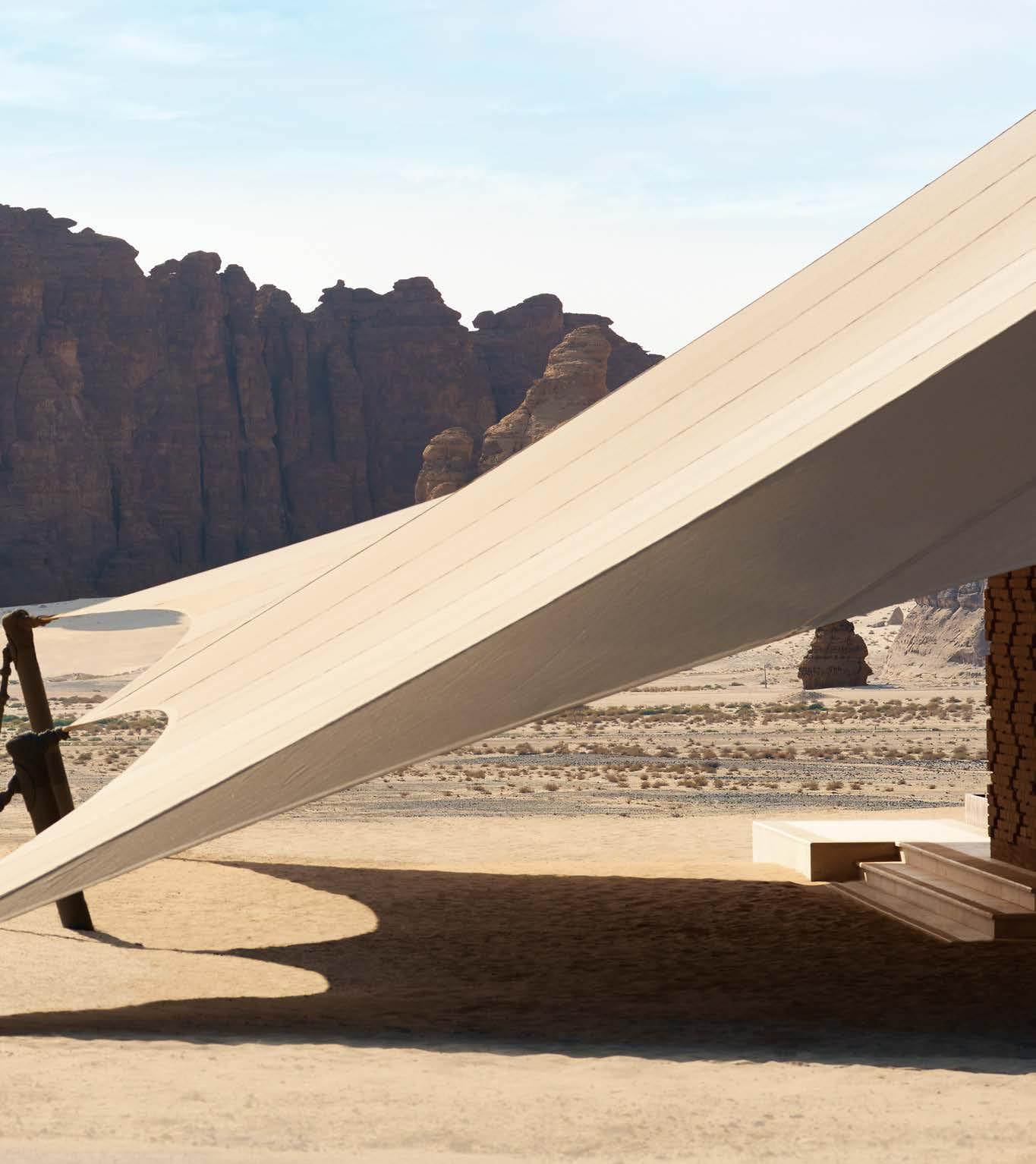
From massage treatments in the spa — a place for physical, mental, and spiritual renewal — to lazing in the pool, touring ancient sites (some UNESCO World Heritage recognised) or star-gazing, rock-climbing, zip-lining and even helicopter rides, Banyan Tree AlUla offers a dramatic balance of immersive and experiential activities, alongside an ethical preservation of culture.
Perhaps you’re envisioning setting foot in the valley, being stunned by the night stillness, or finding your way through the craggy rock formations. Or maybe you’d prefer to sit back and marvel at it all from your poolside villa with bespoke, Nabataean-inspired furnishings. Either way, the sheer force of nature and feeling of tranquillity is unmissable in this one-of-a-kind location where time and space are suspended.
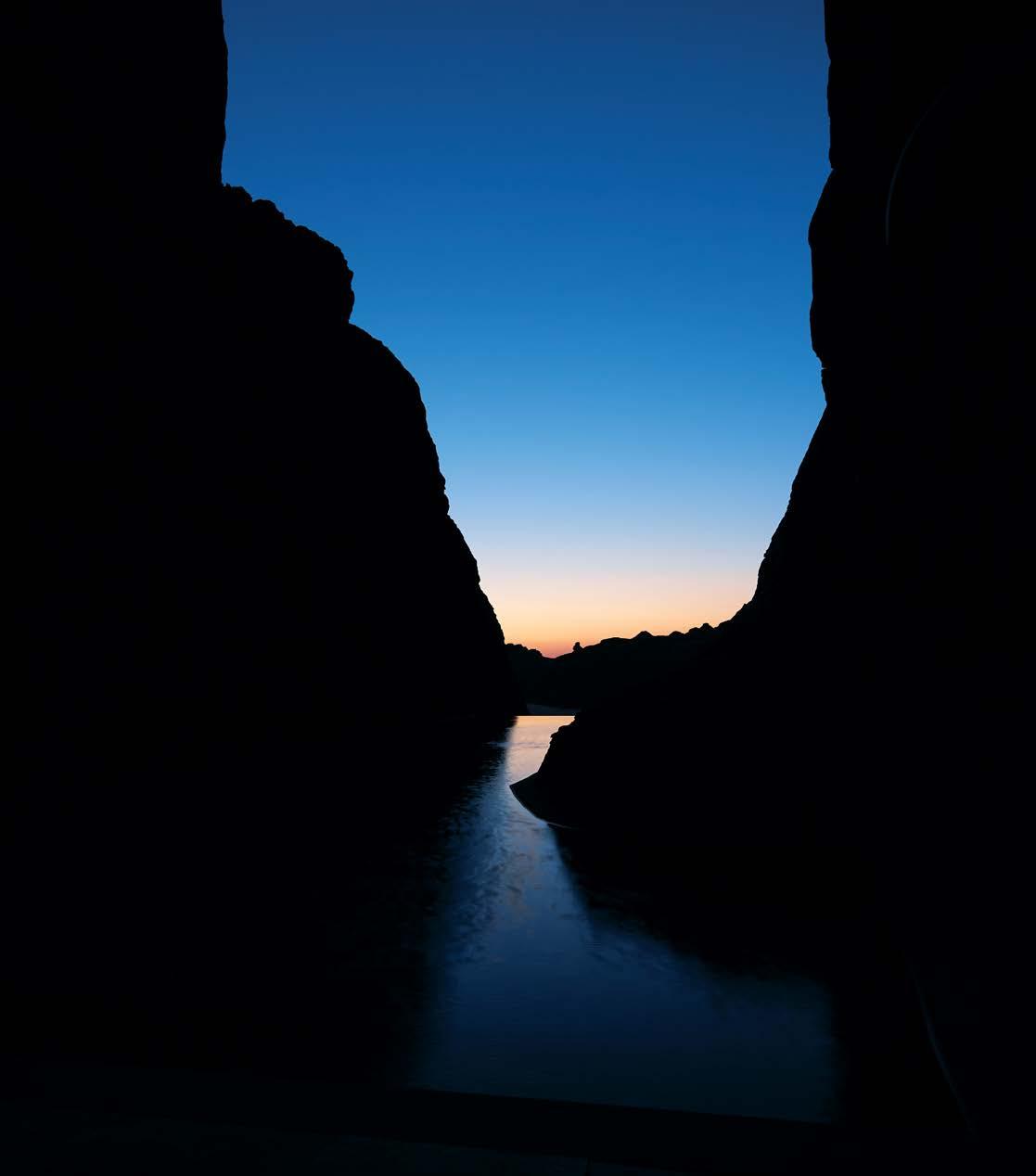
210-211 THIS IS YUNG
DESERT DREAMSCAPE

Saudi Arabia is well on its way to becoming the new tourist hot-spot,

212-213 THIS IS YUNG
DESERT DREAMSCAPE
and Banyan Tree AlUla is setting high standards.


INSPIRATION 174-175 THIS IS YUNG 214-215 THE SPACE
The Clockwork Forest
An immersive virtual reality experience by Audemars Piguet. This a dventure will be exclusively available at Dreamscape’s Geneva location beginning in March 2023 for a limited period of time.

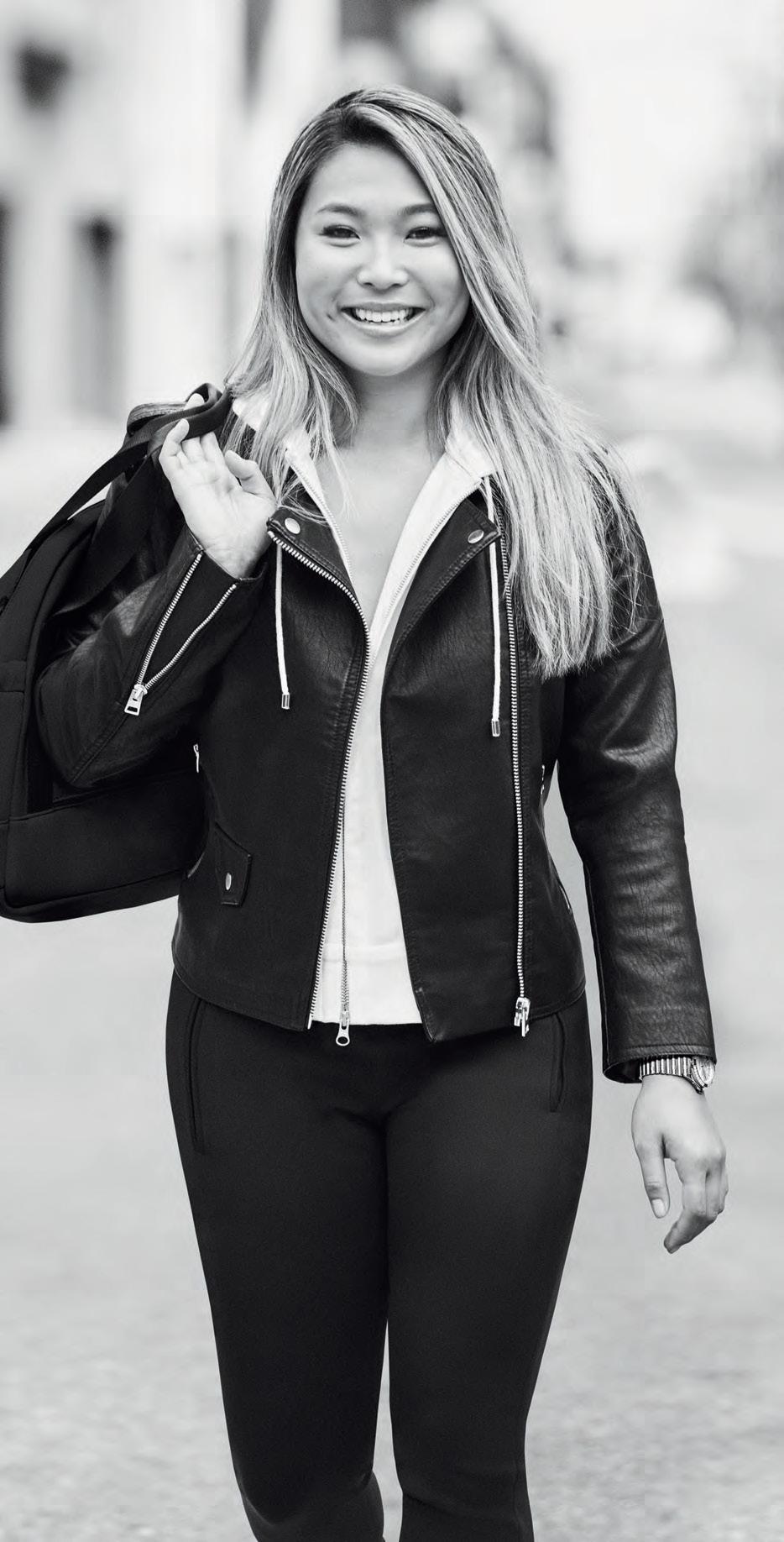
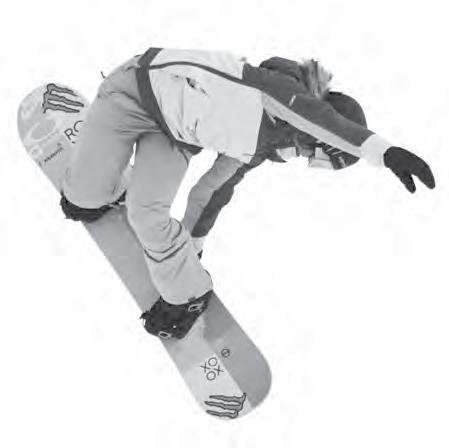
 Chloe Kim
Two-time winter games gold medalist, member of the all star squad
Chloe Kim
Two-time winter games gold medalist, member of the all star squad













 YUSRA MARDINI photography JAMEELA ELFAKI; styling LATIFA BINT SAAD
YOUSRA MOHSEN photograpy AXL JOZEPH; styling SIR WILLOW
DARIN SALLAM photography AMINA ZAHER; styling SAIF HIDAYAH
YUSRA MARDINI photography JAMEELA ELFAKI; styling LATIFA BINT SAAD
YOUSRA MOHSEN photograpy AXL JOZEPH; styling SIR WILLOW
DARIN SALLAM photography AMINA ZAHER; styling SAIF HIDAYAH








































 image supplied by talent
image supplied by talent













































 top, skirt, Miu Miu
top, skirt, Miu Miu




 Dress, heels, Gucci
Dress, heels, Gucci






 photography JAMEELA ELFAKI styling LATIFA BINT SAAD words SAIF HIDAYAH
photography JAMEELA ELFAKI styling LATIFA BINT SAAD words SAIF HIDAYAH
 Dress, Loewe. Earrings, Swarovski. Gloves, stylist’s own
Dress, Loewe. Earrings, Swarovski. Gloves, stylist’s own





 Top, shoes Maison Margiela Trousers, Highlight
Top, shoes Maison Margiela Trousers, Highlight



 Top, Louis Gabriel Nouchi. Trousers, Maison Margiela.
Shoes, Hermes. Cap, stylist’s own
Top, Louis Gabriel Nouchi. Trousers, Maison Margiela.
Shoes, Hermes. Cap, stylist’s own

















 Jacket, dress, heels, necklace, Bottega Veneta
Jacket, dress, heels, necklace, Bottega Veneta






 Jacket, top, trousers, Valentino Jewelry, stylist’s own
Jacket, top, trousers, Valentino Jewelry, stylist’s own





 Heels, Celine
Heels, Celine

 Bag, Chanel
Bag, Chanel


 Shoes, Marison Margiela
Shoes, Marison Margiela



 Top, Trashy Clothing
Top, Trashy Clothing

 Top, Trashy Clothing
Jewelry, sunglasses stylist’s own
Top, Trashy Clothing
Jewelry, sunglasses stylist’s own
 Jacket, Etro at Airport Tray.
Jewelry, stylist’s own
Jacket, Etro at Airport Tray.
Jewelry, stylist’s own























































 Chloe Kim
Two-time winter games gold medalist, member of the all star squad
Chloe Kim
Two-time winter games gold medalist, member of the all star squad